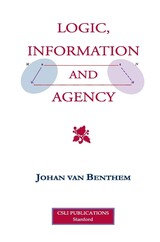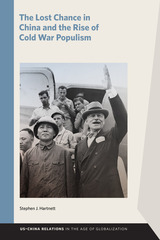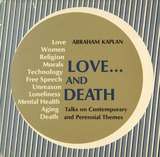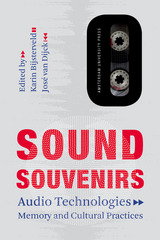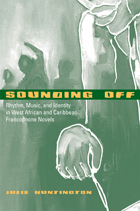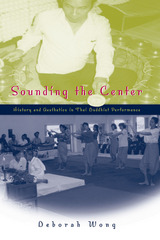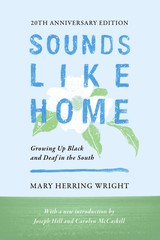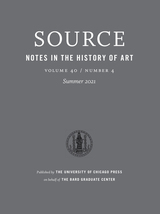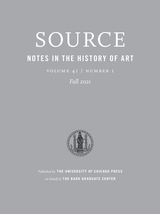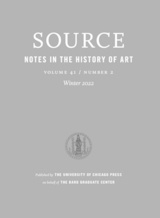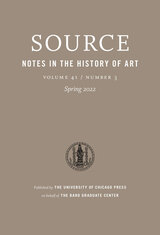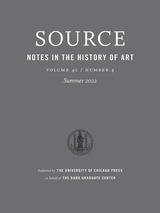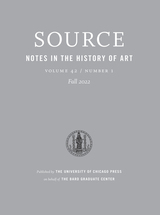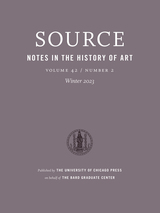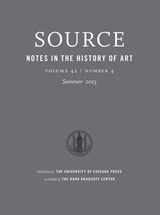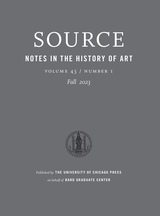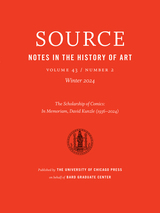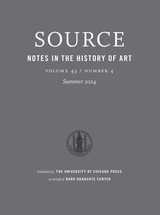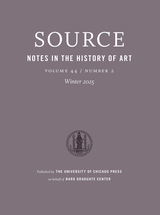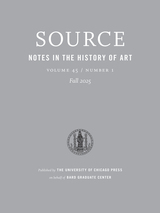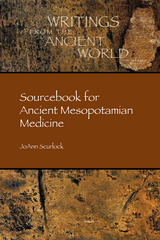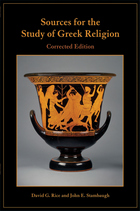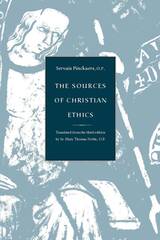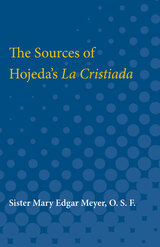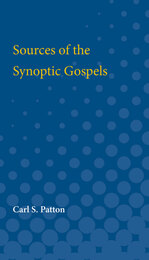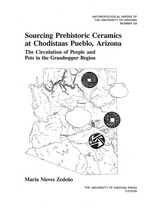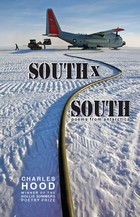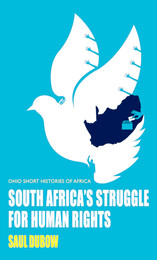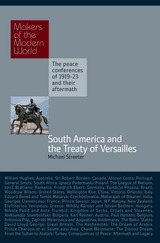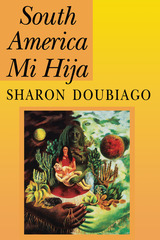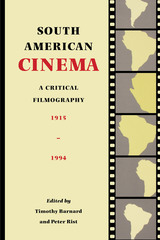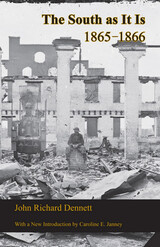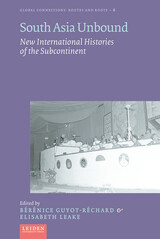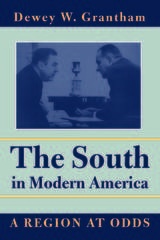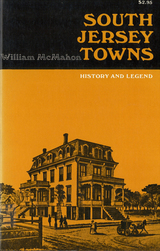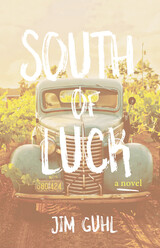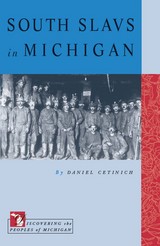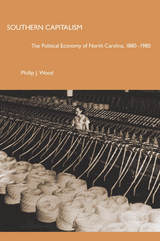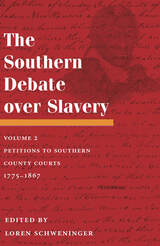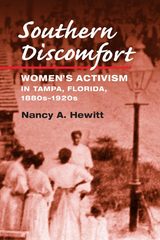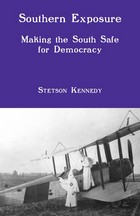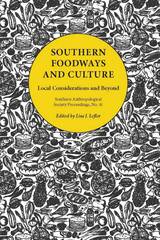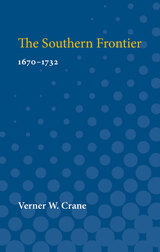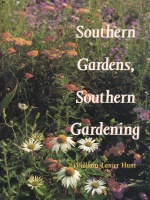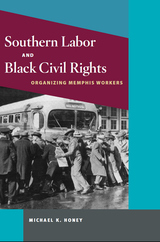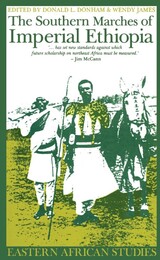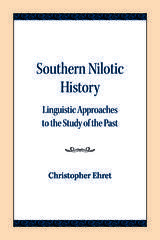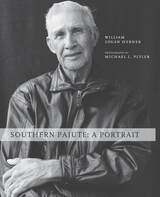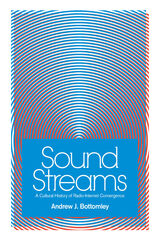 Sound Streams: A Cultural History of Radio-Internet Convergence
Andrew J. Bottomley
University of Michigan Press, 2020 In talking about contemporary media, we often use a language of newness, applying words like “revolution” and “disruption.” Yet, the emergence of new sound media technologies and content—from the earliest internet radio broadcasts to the development of algorithmic music services and the origins of podcasting—are not a disruption, but a continuation of the century-long history of radio. Today’s most innovative media makers are reintroducing forms of audio storytelling from radio’s past.
Sound Streams is the first book to historicize radio-internet convergence from the early ’90s through the present, demonstrating how so-called new media represent an evolutionary shift that is nevertheless historically consistent with earlier modes of broadcasting. Various iterations of internet radio, from streaming audio to podcasting, are all new radio practices rather than each being a separate new medium: radio is any sound media that is purposefully crafted to be heard by an audience. Rather than a particular set of technologies or textual conventions, web-based broadcasting combines unique practices and features and ideas from radio history. In addition, there exists a distinctive conversationality and reflexivity to radio talk, including a propensity for personal stories and emotional disclosure, that suits networked digital media culture. What media convergence has done is extend and intensify radio’s logics of connectivity and sharing; sonically mediated personal expression intended for public consideration abounds in online media networks.
Sound Streams marks a significant contribution to digital media and internet studies. Its mix of cultural history, industry research, and genre and formal analysis, especially of contemporary audio storytelling, will appeal to media scholars, radio and podcast practitioners, audio journalism students, and dedicated podcast fans.
Sound System: The Political Power of Music
Dave Randall
Pluto Press, 2017 Musicians have often wanted to change the world. From underground innovators to pop icons many have believed in the political power of music. Rulers recognise it too. Music has been used to challenge the political and social order - and to prop up the status quo.
Sound System is the story of one musician's journey to discover what makes music so powerful. Dave Randall uses his insider's knowledge of the industry to shed light on the secrets of celebrity, commodification and culture.
This is a book of raves, riots and revolution. From the Glastonbury Festival to the Arab Spring, Pop Idol to Trinidadian Carnival, Randall finds political inspiration across the musical spectrum and poses the question: how can we make music serve the interests of the many, rather than the few?
Published in partnership with the Left Book Club.
 Sound Tracks: A Musical ABC, Volumes 1-3
Michael Jarrett
Temple University Press, 1998 From ambient music to "Dixie" and Zulu Nation, from Sonny Rollins to the Beastie Boys and Elvis's tailor, Sound Tracks quick-shuttles like a jukebox on Saturday night. Alphabetically ordered, this collection of pithy definitions and extended meditations most resembles a boxed set of anthologized sounds compiled by an omnivore of music.
Spinning off from the "Definition of Sound" column he wrote for Pulse! magazine, Michael Jarrett mixes astute music criticism, an engaging writing style, and a wicked sense of humor to produce three alphabets that will provoke readers to rethink all sorts of popular music. Inventive and whimsical, these small essays coalesce around a serious purpose -- writing about contemporary culture in a way that is meaningful to electronic-age readers and listeners.
Take, for example, the entry on ambient music: like all of the entries in the book, it is preceded by evocative album art that amplify the definition; this one lists related videos as well. But it also presents an interview with Carla Bley and Steve Swallow on the influential music of Erik Satie. Under the Ls, producer George Avakian talks about how the technology that made LPs possible changed the music industry, and Pat Metheny talks about the challenges of sequencing an LP from a musician's point of view. The entry for Carol (as in traditional songs for Christmas and the Middle Age dance craze) opens into a riff on cultural roots and survivals that invokes Chuck Berry's classic song.
Whether it is read start to finish or sampled, Sound Tracks is a book that music lovers and students of contemporary culture will applaud.
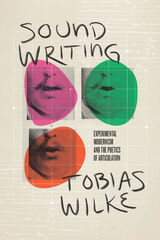 Sound Writing: Experimental Modernism and the Poetics of Articulation
Tobias Wilke
University of Chicago Press, 2022 Considers the avant-garde rethinking of poetic language in terms of physical speech production.
Avant-garde writers and artists of the twentieth century radically reconceived poetic language, appropriating scientific theories and techniques as they turned their attention to the physical process of spoken language. This modernist “sound writing” focused on the bodily production of speech, which it rendered in poetic, legible, graphic form.
Modernist sound writing aims to capture the acoustic phenomenon of vocal articulation by graphic means. Tobias Wilke considers sound writing from its inception in nineteenth-century disciplines like physiology and experimental phonetics, following its role in the aesthetic practices of the interwar avant-garde and through to its reemergence in the postwar period. These projects work with the possibility of crossing over from the audible to the visible, from speech to notation, from body to trace. Employing various techniques and concepts, this search for new possibilities played a central role in the transformation of poetry into a site of radical linguistic experimentation. Considering the works of writers and artists—including Raoul Hausmann, Kurt Schwitters, Viktor Shklovsky, Hugo Ball, Charles Olson, and Marshall McLuhan—Wilke offers a fresh look at the history of the twentieth-century avant-garde.
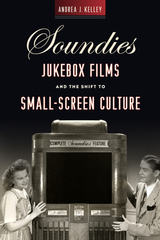 Soundies Jukebox Films and the Shift to Small-Screen Culture
Kelley, Andrea J
Rutgers University Press, 2018 Soundies Jukebox Films and the Shift to Small-Screen Culture is the first and only book to position what are called “Soundies” within the broader cultural and technological milieu of the 1940s. From 1940 to 1946, these musical films circulated in everyday venues, including bars, bowling alleys, train stations, hospitals, and even military bases. Viewers would pay a dime to watch them playing on the small screens of the Panoram jukebox. This book expands U.S. film history beyond both Hollywood and institutional film practices. Examining the dynamics between Soundies’ short musical films, the Panoram’s film-jukebox technology, their screening spaces and their popular discourse, Andrea J. Kelley provides an integrative approach to historic media exhibition. She situates the material conditions of Soundies’ screening sites alongside formal considerations of the films and their unique politics of representation to illuminate a formative moment in the history of the small screen.
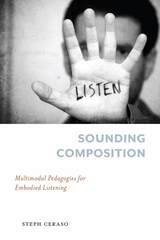 Sounding Composition: Multimodal Pedagogies for Embodied Listening
Steph Ceraso
University of Pittsburgh Press, 2018 In Sounding Composition Steph Ceraso reimagines listening education to account for twenty-first-century sonic practices and experiences. Sonic technologies such as audio editing platforms and music software allow students to control sound in ways that were not always possible for the average listener. While digital technologies have presented new opportunities for teaching listening in relation to composing, they also have resulted in a limited understanding of how sound works in the world at large. Ceraso offers an expansive approach to sonic pedagogy through the concept of multimodal listening—a practice that involves developing an awareness of how sound shapes and is shaped by different contexts, material objects, and bodily, multisensory experiences. Through a mix of case studies and pedagogical materials, she demonstrates how multimodal listening enables students to become more savvy consumers and producers of sound in relation to composing digital media, and in their everyday lives.
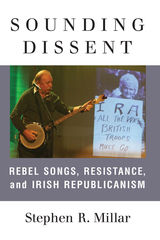 Sounding Dissent: Rebel Songs, Resistance, and Irish Republicanism
Stephen R. Millar
University of Michigan Press, 2020 The signing of the Good Friday Agreement on April 10, 1998, marked the beginning of a new era of peace and stability in Northern Ireland. As the public overwhelmingly rejected a return to the violence of the Troubles, loyalist and republican groups sought other outlets to continue their struggle. Music, which has long been used to celebrate cultural identity in the North of Ireland, became a key means of facilitating the continuation of pre-Agreement identity narratives in a “post-conflict” era.
Sounding Dissent draws on three years of sustained fieldwork within Belfast's rebel music scene, in-depth interviews with republican musicians, contemporary audiences, and former paramilitaries, as well as diverse historical and archival material, including songbooks, prison records, and newspaper articles, to understand the history of political violence in Ireland.The book examines the potential of rebel songs to memorialize a pantheon of republican martyrs, and demonstrates how musical performance and political song not only articulate experiences and memories of oppression and violence, but also play a central role in the reproduction of conflict and exclusion in times of peace.
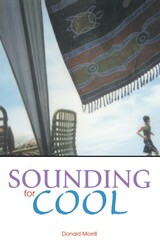 Sounding for Cool
Donald Morrill
Michigan State University Press, 2002 Sounding for Cool is about self-transformation, about growing up on one’s own as a product of contemporary America, and about how to become not just a man, but a contributing adult in society. Donald Morrill presents the day-to-day lives of seven young men (white, black, Hispanic, immigrant, middle-class, thick-headed, poor, and smart), who for various reasons have become homeless. Placed in a Transitional Living Program facility (TLP) by the courts, these men must learn to navigate in the world of “normal” values and reasonable rules. Streetwise and callow, trained to seek shortcuts or to make excuses, they struggle with the structures and assumptions inherent in living a law-abiding, bill-paying life. While sorting out their souls, they learn how to connect with others.
In turn, Sounding for Cool scrutinizes the staff of the TLP, one woman and three men, who variously come to terms with their lives by settling accounts from the past. As a TLP volunteer, Donald Morrill often finds himself bridging the gap between staff and client. In the process of telling their stories, he chronicles his own journey to understand the past. Ultimately, Sounding for Cool asks the enduring questions, “Who am I in the world and what can I become?”
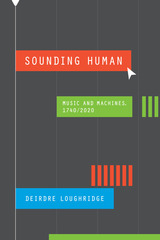 Sounding Human: Music and Machines, 1740/2020
Deirdre Loughridge
University of Chicago Press, 2023 An expansive analysis of the relationship between human and machine in music.
From the mid-eighteenth century on, there was a logic at work in musical discourse and practice: human or machine. That discourse defined a boundary of absolute difference between human and machine, with a recurrent practice of parsing “human” musicality from its “merely mechanical” simulations. In Sounding Human, Deirdre Loughridge tests and traverses these boundaries, unmaking the “human or machine” logic and seeking out others, better characterized by conjunctions such as and or with.
Sounding Human enters the debate on posthumanism and human-machine relationships in music, exploring how categories of human and machine have been continually renegotiated over the centuries. Loughridge expertly traces this debate from the 1737 invention of what became the first musical android to the creation of a “sound wave instrument” by a British electronic music composer in the 1960s, and the chopped and pitched vocals produced by sampling singers’ voices in modern pop music. From music-generating computer programs to older musical instruments and music notation, Sounding Human shows how machines have always actively shaped the act of music composition. In doing so, Loughridge reveals how musical artifacts have been—or can be—used to help explain and contest what it is to be human.
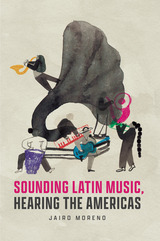 Sounding Latin Music, Hearing the Americas
Jairo Moreno
University of Chicago Press, 2023 How is Latin American music heard, by whom, and why?
Many in the United States believe Latin American musicians make “Latin music”—which carries with it a whole host of assumptions, definitions, and contradictions. In their own countries, these expatriate musicians might generate immense national pride or trigger suspicions of “national betrayals.” The making, sounding, and hearing of “Latin music” brings into being the complex array of concepts that constitute “Latin Americanism”—its fissures and paradoxes, but also its universal aspirations. Taking as its center musicians from or with declared roots in Latin America, Jairo Moreno presents us with an innovative analysis of how and why music emerges as a necessary but insufficient shorthand for defining and understanding Latin American, Latinx, and American experiences of modernity.
This close look at the growth of music-making by Latin American and Spanish-speaking musicians in the United States at the turn of the twenty-first century reveals diverging understandings of music’s social and political possibilities for participation and belonging. Through the stories of musicians—Rubén Blades, Shakira, Arturo O’Farrill and the Afro-Latin Jazz Orchestra, and Miguel Zenón—Sounding Latin Music, Hearing the Americas traces how artists use music to produce worlds and senses of the world at the ever-transforming conjunction of Latin America and the United States.
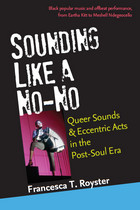 Sounding Like a No-No: Queer Sounds and Eccentric Acts in the Post-Soul Era
Francesca T. Royster
University of Michigan Press, 2012 Sounding Like a No-No traces a rebellious spirit in post–civil rights black music by focusing on a range of offbeat, eccentric, queer, or slippery performances by leading musicians influenced by the cultural changes brought about by the civil rights, black nationalist, feminist, and LGBTQ movements, who through reinvention created a repertoire of performances that have left a lasting mark on popular music. The book's innovative readings of performers including Michael Jackson, Grace Jones, Stevie Wonder, Eartha Kitt, and Meshell Ndegeocello demonstrate how embodied sound and performance became a means for creativity, transgression, and social critique, a way to reclaim imaginative and corporeal freedom from the social death of slavery and its legacy of racism, to engender new sexualities and desires, to escape the sometimes constrictive codes of respectability and uplift from within the black community, and to make space for new futures for their listeners. The book's perspective on music as a form of black corporeality and identity, creativity, and political engagement will appeal to those in African American studies, popular music studies, queer theory, and black performance studies; general readers will welcome its engaging, accessible, and sometimes playful writing style, including elements of memoir.
 Sounding Like a No-No: Queer Sounds and Eccentric Acts in the Post-Soul Era
Francesca T. Royster
University of Michigan Press, 2013 Sounding Like a No-No traces a rebellious spirit in post–civil rights black music by focusing on a range of offbeat, eccentric, queer, or slippery performances by leading musicians influenced by the cultural changes brought about by the civil rights, black nationalist, feminist, and LGBTQ movements, who through reinvention created a repertoire of performances that have left a lasting mark on popular music. The book's innovative readings of performers including Michael Jackson, Grace Jones, Stevie Wonder, Eartha Kitt, and Meshell Ndegeocello demonstrate how embodied sound and performance became a means for creativity, transgression, and social critique, a way to reclaim imaginative and corporeal freedom from the social death of slavery and its legacy of racism, to engender new sexualities and desires, to escape the sometimes constrictive codes of respectability and uplift from within the black community, and to make space for new futures for their listeners. The book's perspective on music as a form of black corporeality and identity, creativity, and political engagement will appeal to those in African American studies, popular music studies, queer theory, and black performance studies; general readers will welcome its engaging, accessible, and sometimes playful writing style, including elements of memoir.
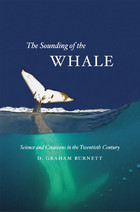 The Sounding of the Whale: Science and Cetaceans in the Twentieth Century
D. Graham Burnett
University of Chicago Press, 2011 From the Bible’s “Canst thou raise leviathan with a hook?” to Captain Ahab’s “From Hell’s heart I stab at thee!,” from the trials of Job to the legends of Sinbad, whales have breached in the human imagination as looming figures of terror, power, confusion, and mystery.
In the twentieth century, however, our understanding of and relationship to these superlatives of creation underwent some astonishing changes, and with The Sounding of the Whale, D. Graham Burnett tells the fascinating story of the transformation of cetaceans from grotesque monsters, useful only as wallowing kegs of fat and fertilizer, to playful friends of humanity, bellwethers of environmental devastation, and, finally, totems of the counterculture in the Age of Aquarius. When Burnett opens his story, ignorance reigns: even Nature was misclassifying whales at the turn of the century, and the only biological study of the species was happening in gruesome Arctic slaughterhouses. But in the aftermath of World War I, an international effort to bring rational regulations to the whaling industry led to an explosion of global research—and regulations that, while well-meaning, were quashed, or widely flouted, by whaling nations, the first shot in a battle that continues to this day. The book closes with a look at the remarkable shift in public attitudes toward whales that began in the 1960s, as environmental concerns and new discoveries about whale behavior combined to make whales an object of sentimental concern and public adulation.
A sweeping history, grounded in nearly a decade of research, The Sounding of the Whale tells a remarkable story of how science, politics, and simple human wonder intertwined to transform the way we see these behemoths from below.
Sounding Off: Rhythm, Music, and Identity in West African and Caribbean Francophone Novels
Julie Huntington
Temple University Press, 2009 Intrigued by "texted" sonorities—the rhythms, musics, ordinary noises, and sounds of language in narratives—Julie Huntington examines the soundscapes in contemporary Francophone novels such as Ousmane Sembene's God's Bits of Wood (Senegal), and Patrick Chamoiseau's Solibo Magnificent (Martinique). Through an ethnomusicological perspective, Huntington argues in Sounding Off that the range of sounds —footsteps, heartbeats, drumbeats—represented in West African and Caribbean works provides a rhythmic polyphony that creates spaces for configuring social and cultural identities.
Huntington’s analysis shows how these writers and others challenge the aesthetic and political conventions that privilege written texts over orality and invite readers-listeners to participate in critical dialogues—to sound off, as it were, in local and global communities.
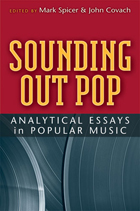 Sounding Out Pop: Analytical Essays in Popular Music
Mark Spicer and John Covach, editors
University of Michigan Press, 2010 "A variety of approaches are brought to bear on fascinating repertoire, but with the underlying aim of better understanding some brilliant music. There’s nothing more exciting in music writing than something which entices you to listen to what’s familiar to you in a new way, and this collection brings such excitement in abundance."
---Allan Moore, author of Jethro Tull: Aqualung and Rock: The Primary Text "These essays bring together a remarkable range of tools and perspectives to such diverse topics and contexts as the behind-the-scenes collaborations of composers, performers, arrangers, producers and engineers; pop culture; narratology; and race, politics and gender. The reader continuously benefits from a complementary lineup of sensitive ears that discover novelty in the familiar, exposing the heart of many rock and pop classics through imaginative and authoritative prose."
---Walter Everett, author of The Foundations of Rock and The Beatles as Musicians The nine essays in Sounding Out Pop work together to map the myriad styles and genres of the pop-rock universe through detailed case studies that confront the music from a variety of engaging, thought-provoking perspectives---from historical to music-analytic, aesthetic to ethnographic, with several authors drawing liberally from ideas in other disciplines. The range of bands and artists covered is as vast and varied as the more than fifty-year history of pop and rock music, from the Coasters and Roy Orbison to Marvin Gaye, Bob Dylan, Radiohead, Beck, Genesis, Tori Amos, and the Police. Together these diverse essays cover a broad spectrum of studies ideally suited for classroom use and for other readers interested in gaining a deeper knowledge of the way popular music works. Mark Spicer is Associate Professor and Director of Undergraduate Studies in Music at Hunter College and the Graduate Center, City University of New York. His writings have appeared in Contemporary Music Review, Gamut, Music Theory Online, twentieth-century music, and other scholarly journals and essay collections. John Covach is Professor of Music at the University of Rochester and Professor of Theory at the Eastman School of Music. He is the author of the college textbook What's That Sound? An Introduction to Rock and Its History and the coeditor of Understanding Rock, American Rock and the Classical Music Tradition, and Traditions, Institutions, and American Popular Music. Cover art credit: © iStockphoto.com/Aleksandar Dickov
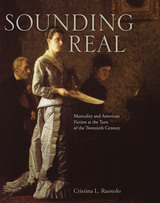 Sounding Real: Musicality and American Fiction at the Turn of the Twentieth Century
Cristina L. Ruotolo
University of Alabama Press, 2013 Examining American realist fiction as it was informed and shaped by the music of the period, Sounding Real sheds new light on the profound musical and cultural change at the turn of the twentieth century. Sounding Real by Cristina L. Ruotolo examines landmark changes in American musical standards and tastes in the late-nineteenth and early-twentieth centuries and the way they are reflected in American literature of the period. Whereas other interdisciplinary approaches to music and literature often focus on more recent popular music and black music that began with blues and jazz, Ruotolo addresses the literary response to the music that occurred in the decades before the Jazz Age. By bringing together canonical and lesser-known works by authors like Theodore Dreiser, Kate Chopin, Harold Fredric, James Weldon Johnson, Willa Cather, and Gertrude Atherton, Ruotolo argues that new, emerging musical forms were breaking free from nineteenth-century constraints, and that the elemental authenticity or real-ness that this new music articulated sparked both interest and anxiety in literature: What are the effects of an emancipated musicality on self and society? How can literature dramatize musical encounters between people otherwise segregated by class, race, ethnicity, or gender? By examining the influence of an increasingly aggressive and progressive musical marketplace on the realm of literature, Sounding Real depicts a dynamic dialogue between two art forms that itself leads to a broader discussion of how art speaks to society.
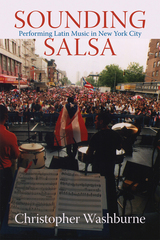 Sounding Salsa: Performing Latin Music in New York City
Christopher Washburne
Temple University Press, 2008 Written from the perspective of salsa musicians,this ethnographic journey into New York salsa of the 1990s, this pioneering study examines how musicians navigated their everyday lives, grappling with the intercultural tensions and commercial pressures that were so pronounced on the salsa scene. Author Chris Washburne examines the organizational structures, recording processes, rehearsing, and gigging of salsa bands, paying particular attention to how bands created a sense of community, privileged "the people" over artistic and commercial concerns, and incited cultural pride during performance events. He considers how violence, the illicit drug trade, and issues of gender informed sound structure, salsa aesthetics, and performance practice. He concludes the book with a discussion of salsa style in the 1990s, emphasizing how certain structural principles involved in music making (e.g., clave) and the intercultural dynamics of Puerto Rico and New York informed performance practice.
Sounding the Center: History and Aesthetics in Thai Buddhist Performance
Deborah Wong
University of Chicago Press, 2001 Sounding the Center is an in-depth look at the power behind classical music and dance in Bangkok, the capital and sacred center of Buddhist Thailand. Focusing on the ritual honoring teachers of music and dance, Deborah Wong reveals a complex network of connections among kings, teachers, knowledge, and performance that underlies the classical court arts.
Drawing on her extensive fieldwork, Wong lays out the ritual in detail: the way it is enacted, the foods and objects involved, and the people who perform it, emphasizing the way the performers themselves discuss and construct aspects of the ceremony.
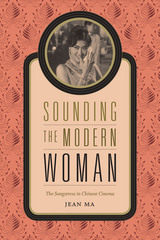 Sounding the Modern Woman: The Songstress in Chinese Cinema
Jean Ma
Duke University Press, 2015 From the beginning of the sound cinema era, singing actresses captivated Chinese audiences. In Sounding the Modern Woman, Jean Ma shows how their rise to stardom attests to the changing roles of women in urban modernity and the complex symbiosis between the film and music industries. The songstress—whether appearing as an opera actress, showgirl, revolutionary, or country lass—belongs to the lineage of the Chinese modern woman, and her forty year prevalence points to a distinctive gendering of lyrical expression in Chinese film. Ma guides readers through film history by way of the on and off-screen careers of many of the most compelling performers in Chinese film history, such as Zhou Xuan and Grace Chang, revealing the ways that national crises and Cold War conflict shaped their celebrity. As a bridge between the film cultures of prewar Shanghai and postwar Hong Kong, the songstress brings into view a dense web of connections linking these two periods and places that cut across the divides of war, national politics, and geography.
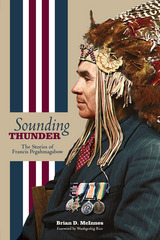 Sounding Thunder: The Stories of Francis Pegahmagabow
Brian D. McInnes
Michigan State University Press, 2016 Francis Pegahmagabow (1889–1952), an Ojibwe of the Caribou clan, was born in Shawanaga First Nation, Ontario. Enlisting at the onset of the First World War, he served overseas as a scout and sniper and became Canada’s most decorated Indigenous soldier. After the war, Pegahmagabow settled in Wasauksing First Nation, Ontario, where he married and raised six children. He served his community as both Chief and Councillor and was a founding member of the Brotherhood of Canadian Indians, the first national Indigenous political organization. In 1949 and 1950, he was elected the Supreme Chief of the National Indian Government.
Francis Pegahmagabow’s stories describe many parts of his life and are characterized by classic Ojibwe narrative. They reveal aspects of Francis’s Anishinaabe life and worldview. Interceding chapters by Brian McInnes provide valuable cultural, spiritual, linguistic, and historical insights that give a greater context and application for Francis’s words and world. Presented in their original Ojibwe as well as in English translation, the stories also reveal a rich and evocative relationship to the lands and waters of Georgian Bay.
In Sounding Thunder, Brian McInnes provides a new perspective on Pegahmagabow and his experience through a unique synthesis of Ojibwe oral history, historical record, and Pegahmagabow family stories.
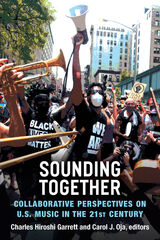 Sounding Together: Collaborative Perspectives on U.S. Music in the 21st Century
Charles Hiroshi Garrett and Carol J. Oja, Editors
University of Michigan Press, 2021 Sounding Together: Collaborative Perspectives on U.S. Music in the Twenty-21st Century is a multi-authored, collaboratively conceived book of essays that tackles key challenges facing scholars studying music of the United States in the early twenty-first century. This book encourages scholars in music circles and beyond to explore the intersections between social responsibility, community engagement, and academic practices through the simple act of working together. The book’s essays—written by a diverse and cross-generational group of scholars, performers, and practitioners—demonstrate how collaboration can harness complementary skills and nourish comparative boundary-crossing through interdisciplinary research. The chapters of the volume address issues of race, nationalism, mobility, cultural domination, and identity; as well as the crisis of the Trump era and the political power of music. Each contribution to the volume is written collaboratively by two scholars, bringing together contributors who represent a mix of career stages and positions. Through the practice of and reflection on collaboration, Sounding Together breaks out of long-established paradigms of solitude in humanities scholarship and works toward social justice in the study of music.
Soundings at Tell Fakhariyah
Calvin W. McEwan, Linda S. Braidwood, Henri Frankfort, Hans G. Guterbock, Richar
University of Chicago Press, 1958
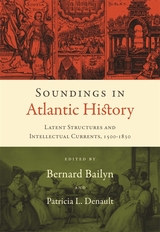 Soundings in Atlantic History: Latent Structures and Intellectual Currents, 1500–1830
Bernard Bailyn
Harvard University Press, 2011 These innovative essays probe the underlying unities that bound the early modern Atlantic world into a regional whole and trace some of the intellectual currents that flowed through the lives of the people of the four continents. Drawn together in a comprehensive Introduction by Bernard Bailyn, the essays include analyses of the climate and ecology that underlay the slave trade, pan-Atlantic networks of religion and of commerce, legal and illegal, inter-ethnic collaboration in the development of tropical medicine, science as a product of imperial relations, the Protestant international that linked Boston and pietist Germany, and the awareness and meaning of the Atlantic world in the mind of that preeminent intellectual and percipient observer, David Hume.
In his Introduction, Bailyn explains that the Atlantic world was never self-enclosed or isolated from the rest of the globe but suggests that experiences in the early modern Atlantic region were distinctive in ways that shaped the course of world history.
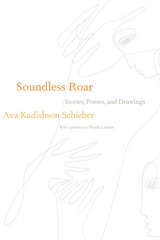 Soundless Roar: Stories, Poems, and Drawings
Ava Kadishson Schieber
Northwestern University Press, 2002 Soundless Roar introduces a distinctive new voice to Holocaust literature. Ava Kadishson Schieber, author, poet, and artist, spent her teenage years hiding from the Nazis on a Serbian farm. Her cultured speech and city-bred body language could have betrayed her, so she was forced into near isolation. Schieber began drawing while in hiding, and she continues to express herself today with the same urgency. The drawings and writings in Soundless Roar are the culmination of many years of artistry. In her work, she shares her memories of loved ones killed in the Holocaust: they are "friendly ghosts" that will always be a part of her.
Schieber's drawings, paintings, poetry, and prose are all intimate reflections of one another. Her experience forged the unusual sense of time that shapes Schieber's stories. In her preface, Phyllis Lassner writes: "The timetable of Ava's stories often consists of circles within circles, of patterns of an intertwined past, the past present of hiding, and the present looking back at those distinctly separate but inseparable pasts."
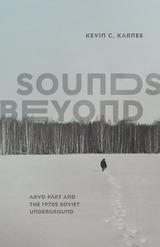 Sounds Beyond: Arvo Pärt and the 1970s Soviet Underground
Kevin C. Karnes
University of Chicago Press, 2021 Sounds Beyond charts the origins of Arvo Pärt’s most famous music, which was created in dialogue with underground creative circles in the USSR.
In Sounds Beyond, Kevin C. Karnes studies the interconnected alternative music and art scenes in the USSR during the second half of the 1970s, revealing the audacious origins of some of Estonian composer Arvo Pärt’s most famous music. Karnes shows how Pärt’s work was created within a vital yet forgotten culture of collective experimentation, the Soviet underground.
Mining archives and oral history from across the former USSR, Sounds Beyond carefully situates modes of creative experimentation within their late socialist contexts. In documenting Pärt’s work, Karnes reveals the rich creative culture that thrived covertly in the USSR and the network of figures that made underground performances possible: students, audio engineers, sympathetic administrators, star performers, and aspiring DJs. Sounds Beyond advances a new understanding of Pärt’s music as an expression of the aesthetic and religious commitments shared, nurtured, and celebrated by many in Soviet underground circles. At the same time, this story attests to the lasting power of Pärt’s music. Dislodging the mythology of the solitary creative genius, Karnes shows that Pärt’s work would be impossible without community.
 Sounds English: TRANSNATIONAL POPULAR MUSIC
Nabeel Zuberi
University of Illinois Press, 2001 Popular music culture serves as an arena for debates on English and British national identity in this lively discussion of English popular music of the 1980s and 1990s. Against the background of his own upbringing as a Pakistani Brit, Nabeel Zuberi deftly combines a detailed account of the development of this music with a sophisticated assessment of its relation to the politics of cultural identity in Britain.
Zuberi looks at how the sounds, images, and lyrics of English popular music generate and critique ideas of national belonging, recasting the social and even the physical landscapes of cities like Manchester and London. The Smiths and Morrissey play on romanticized notions of the (white) English working class, while the Pet Shop Boys map a "queer urban Britain" in the AIDS era. The techno-culture of raves and dance clubs incorporates both an anti-institutional do-it-yourself politics and emergent leisure practices, while the potent mix of technology and creativity in British black music includes local conditions as well as a sense of global diaspora. British Asian musicians, drawing on Afrodiasporic and South Asian traditions, seek a sense of place in Britain as commercial interests try to pin down an image of them to market.
Sounds English shows how popular music complicates cherished notions of Englishness as it activates cultural outsiders and taps into a sense of not belonging. Alert and readable, Zuberi's wide-ranging discussion includes the performers Oasis, Blur, Tricky, Massive Attack, Goldie, A Guy Called Gerald, Roni Size, Bally Sagoo, Funˆdaˆmental, Echobelly, Cornershop, Talvin Singh, and others.
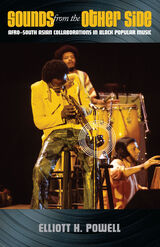 Sounds from the Other Side: Afro–South Asian Collaborations in Black Popular Music
Elliott H. Powell
University of Minnesota Press, 2020 A sixty-year history of Afro–South Asian musical collaborations
From Beyoncé’s South Asian music–inspired Super Bowl Halftime performance, to jazz artists like John and Alice Coltrane’s use of Indian song structures and spirituality in their work, to Jay-Z and Missy Elliott’s high-profile collaborations with diasporic South Asian artists such as the Panjabi MC and MIA, African American musicians have frequently engaged South Asian cultural productions in the development of Black music culture. Sounds from the Other Side traces such engagements through an interdisciplinary analysis of the political implications of African American musicians’ South Asian influence since the 1960s.
Elliott H. Powell asks, what happens when we consider Black musicians’ South Asian sonic explorations as distinct from those of their white counterparts? He looks to Black musical genres of jazz, funk, and hip hop and examines the work of Miles Davis, John Coltrane, Rick James, OutKast, Timbaland, Beyoncé, and others, showing how Afro–South Asian music in the United States is a dynamic, complex, and contradictory cultural site where comparative racialization, transformative gender and queer politics, and coalition politics intertwine. Powell situates this cultural history within larger global and domestic sociohistorical junctures that link African American and South Asian diasporic communities in the United States.
The long historical arc of Afro–South Asian music in Sounds from the Other Side interprets such music-making activities as highly political endeavors, offering an essential conversation about cross-cultural musical exchanges between racially marginalized musicians.
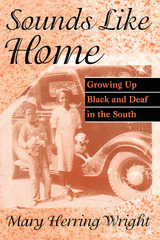 Sounds Like Home: Growing Up Black and Deaf in the South
Mary Herring Wright
Gallaudet University Press, 1999 New edition available: Sounds Like Home: Growing Up Black and Deaf in the South, 20th Anniversary Edition, ISBN 978-1-944838-58-4
Features a new introduction by scholars Joseph Hill and Carolyn McCaskill
Mary Herring Wright’s memoir adds an important dimension to the current literature in that it is a story by and about an African American deaf child. The author recounts her experiences growing up as a deaf person in Iron Mine, North Carolina, from the 1920s through the 1940s. Her story is unique and historically significant because it provides valuable descriptive information about the faculty and staff of the North Carolina school for Black deaf and blind students from the perspective of a student as well as a student teacher. In addition, this engrossing narrative contains details about the curriculum, which included a week-long Black History celebration where students learned about important Blacks such as Madame Walker, Paul Laurence Dunbar, and George Washington Carver. It also describes the physical facilities as well as the changes in those facilities over the years. In addition, Sounds Like Home occurs over a period of time that covers two major events in American history, the Depression and World War II.
Wright’s account is one of enduring faith, perseverance, and optimism. Her keen observations will serve as a source of inspiration for others who are challenged in their own ways by life’s obstacles.
Sounds Like Home: Growing Up Black and Deaf in the South
Mary Herring Wright
Gallaudet University Press, 2019 Originally published in 1999, Sounds Like Home adds an important dimension to the canon of deaf literature by presenting the perspective of an African American deaf woman who attended a segregated deaf school. Mary Herring Wright documents her life from the mid-1920s to the early 1940s, offering a rich account of her home life in rural North Carolina and her education at the North Carolina School for the Deaf and Blind, which had a separate campus for African American students. This 20th anniversary edition of Wright’s story includes a new introduction by scholars Joseph Hill and Carolyn McCaskill, who note that the historical documents and photographs of segregated Black deaf schools have mostly been lost. Sounds Like Home serves “as a permanent witness to the lives of Black Deaf people.”
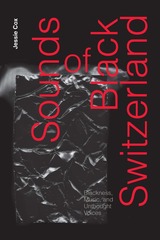 Sounds of Black Switzerland: Blackness, Music, and Unthought Voices
Jessie Cox
Duke University Press, 2025 Writing as a scholar, composer, and musician, Jessie Cox foregrounds the experience of Black Swiss through sound and music in his first book, Sounds of Black Switzerland. Cox, himself Black Swiss, affirms the value of Black life through sound while critiquing anti-Blackness as a cause of erasure, silence, and limitation. He examines Swiss Nigerian composer Charles Uzor’s pieces for George Floyd, work by Black Swiss musicians such as DJ Maïté Chénière, clarinetist Jérémie Jolo, and rapper Nativ, as well as his own musical collaborations with the Lucerne Festival. In these analyses, Cox tackles the particularities of anti-Blackness in Switzerland, creating a practice of listening beyond what can be directly heard to explore the radical potential of Black thought and experience in a nation often claimed to be race-free. In so doing, he ultimately shifts thinking about Blackness in relation to citizenship, immigration laws, gender, kinship, and belonging. By listening to Black Swiss and other voices inaudible to the current world, Cox theorizes new ways of practicing scholarly study and general ways of relating to others and the world.
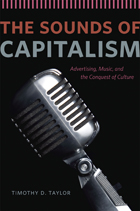 The Sounds of Capitalism: Advertising, Music, and the Conquest of Culture
Timothy D. Taylor
University of Chicago Press, 2012 From the early days of radio through the rise of television after World War II to the present, music has been used more and more to sell goods and establish brand identities. And since the 1920s, songs originally written for commercials have become popular songs, and songs written for a popular audience have become irrevocably associated with specific brands and products. Today, musicians move flexibly between the music and advertising worlds, while the line between commercial messages and popular music has become increasingly blurred. Timothy D. Taylor tracks the use of music in American advertising for nearly a century, from variety shows like The Clicquot Club Eskimos to the rise of the jingle, the postwar upsurge in consumerism, and the more complete fusion of popular music and consumption in the 1980s and after. The Sounds of Capitalism is the first book to tell truly the history of music used in advertising in the United States and is an original contribution to this little-studied part of our cultural history.
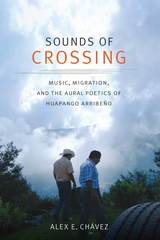 Sounds of Crossing: Music, Migration, and the Aural Poetics of Huapango Arribeño
Alex E. Chávez
Duke University Press, 2017 In Sounds of Crossing Alex E. Chávez explores the contemporary politics of Mexican migrant cultural expression manifest in the sounds and poetics of huapango arribeño, a musical genre originating from north-central Mexico. Following the resonance of huapango's improvisational performance within the lives of audiences, musicians, and himself—from New Year's festivities in the highlands of Guanajuato, Mexico, to backyard get-togethers along the back roads of central Texas—Chávez shows how Mexicans living on both sides of the border use expressive culture to construct meaningful communities amid the United States’ often vitriolic immigration politics. Through Chávez's writing, we gain an intimate look at the experience of migration and how huapango carries the voices of those in Mexico, those undertaking the dangerous trek across the border, and those living in the United States. Illuminating how huapango arribeño’s performance refigures the sociopolitical and economic terms of migration through aesthetic means, Chávez adds fresh and compelling insights into the ways transnational music-making is at the center of everyday Mexican migrant life.
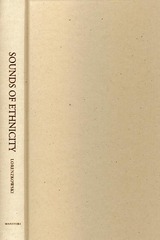 The Sounds of Ethnicity: Listening to German North America, 1850 - 1914
Barbara Lorenzkowski
University of Manitoba Press, 2010 Sounds of Ethnicity takes us into the linguistic, cultural, and geographical borderlands of German North America in the Great Lakes region between 1850 and 1914. Drawing connections between immigrant groups in Buffalo, New York, and Berlin (now Kitchener), Ontario, Barbara Lorenzkowski examines the interactions of language and music—specifically German-language education, choral groups, and music festivals—and their roles in creating both an ethnic sense of self and opportunities for cultural exchanges at the local, ethnic, and transnational levels. She exposes the tensions between the self-declared ethnic leadership that extolled the virtues of the German mother tongue as preserver of ethnic identity and gateway to scholarship and high culture, and the hybrid realities of German North America where the lives of migrants were shaped by two languages, English and German. Theirs was a song not of cultural purity, but of cultural fusion that gave meaning to the way German migrants made a home for themselves in North America.Written in lively and elegant prose, Sounds of Ethnicity is a new and exciting approach to the history of immigration and identity in North America.
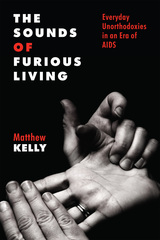 The Sounds of Furious Living: Everyday Unorthodoxies in an Era of AIDS
Matthew Kelly
Rutgers University Press, 2024 Four decades have passed since reports of a mysterious “gay cancer” first appeared in US newspapers. In the ensuing years, the pandemic that would come to be called AIDS changed the world in innumerable ways. It also gave rise to one of the late twentieth century’s largest health-based empowerment movements. Scholars across diverse traditions have documented the rise of the AIDS activist movement, chronicling the impassioned echoes of protestors who took to the streets to demand “drugs into bodies.” And yet not all activism creates echoes. Included among the ranks of 1980s and 1990s-era AIDS activists were individuals whose expressions of empowerment differed markedly from those demanding open access to mainstream pharmaceutical agents. Largely forgotten today, this activist tradition was comprised of individuals who embraced unorthodox approaches for conceptualizing and treating their condition. Rejecting biomedical expertise, they shared alternative clinical paradigms, created underground networks for distributing unorthodox nostrums, and endorsed etiological models that challenged the association between HIV and AIDS. The theatre of their protests was not the streets of New York City’s Greenwich Village but rather their bodies. And their language was not the riotous chants of public demonstration but the often-invisible embrace of contrarian systems for defining and treating their disease. The Sounds of Furious Living seeks to understand the AIDS activist tradition, identifying the historical currents out of which it arose. Embracing a patient-centered, social historical lens, it traces historic shifts in popular understanding of health and perceptions of biomedicine through the nineteenth and twentieth centuries to explain the lasting appeal of unorthodox health activism into the modern era. In asking how unorthodox health activism flourished during the twentieth century’s last major pandemic, Kelly also seeks to inform our understanding of resistance to biomedical authority in the setting of the twenty-first century’s first major pandemic: COVID-19. As a deeply researched portrait of distrust and disenchantment, The Sounds of Furious Living helps explain the persistence of movements that challenge biomedicine’s authority well into a century marked by biomedical innovation, while simultaneously posing important questions regarding the meaning and metrics of patient empowerment in clinical practice.
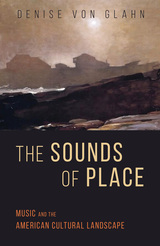 The Sounds of Place: Music and the American Cultural Landscape
Denise Von Glahn
University of Illinois Press, 2021 Composers like Charles Ives, Duke Ellington, Aaron Copland, and Ellen Taaffe Zwilich created works that indelibly commemorated American places. Denise Von Glahn analyzes the soundscapes of fourteen figures whose "place pieces" tell us much about the nation's search for its own voice and about its ever-changing sense of self. She connects each composer's feelings about the United States and their reasons for creating a piece to the music, while analyzing their compositional techniques, tunes, and styles. Approaching the compositions in chronological order, Von Glahn reveals how works that celebrated the wilderness gave way to music engaged with humanity's influence--benign and otherwise--on the landscape, before environmentalism inspired a return to nature themes in the late twentieth century. Wide-ranging and astute, The Sounds of Place explores high art music's role in the making of national myth and memory.
 Sounds of the Citizens: Dancehall and Community in Jamaica
Anne M. Galvin
Vanderbilt University Press, 2014 Dancehall: it's simultaneously a source of raucous energy in the streets of Kingston, Jamaica; a way of life for a group of professional artists and music professionals; and a force of stability and tension within the community. Electronically influenced, relevant to urban Jamaicans, and highly danceable, dancehall music and culture forms a core of popular entertainment in the nation. As Anne Galvin reveals in Sounds of the Citizens, the rhythms of dancehall music reverberate in complicated ways throughout the lives of countless Jamaicans.
Galvin highlights the unique alliance between the dancehall industry and community development efforts. As the central role of the state in supporting communities has diminished, the rise of private efforts such as dancehall becomes all the more crucial. The tension, however, between those involved in the industry and those within the neighborhoods is palpable and often dangerous. Amidst all this, individual Jamaicans interact with the dancehall industry and its culture to find their own paths of employment, social identity, and sexual mores.
As Sounds of the Citizens illustrates, the world of entertainment in Jamaica is serious business and uniquely positioned as a powerful force within the community.
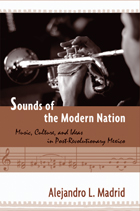 Sounds of the Modern Nation: Music, Culture, and Ideas in Post-Revolutionary Mexico
Alejandro L. Madrid
Temple University Press, 2008 Sounds of the Modern Nation explores the development of modernist and avant-garde art music styles and aesthetics in Mexico in relation to the social and cultural changes that affected the country after the 1910-1920 revolution. Alejandro Madrid argues that these modernist works provide insight into the construction of individual and collective identities based on new ideas about modernity and nationality. Instead of depicting a dichotomy between modernity and nationalism, Madrid reflects on the multiple intersections between these two ideas and the dialogic ways through which these notions acquired meaning. Madrid challenges the view that Latin American modernist music and other art were mere imitations of European trends, advancing instead the argument that Latin American artists resignified European ideas according to their specific historical and cultural circumstances. His work shows how microtonal and futurist music, modernist and avant-garde aesthetics, as well as indigenist and indianist ideas, entered a process of negotiation that ultimately shaped the ideological framework of twentieth-century Mexico.
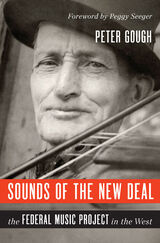 Sounds of the New Deal: The Federal Music Project in the West
Peter Gough
University of Illinois Press, 2015 At its peak the Federal Music Project (FMP) employed nearly 16,000 people who reached millions of Americans through performances, composing, teaching, and folksong collection and transcription. In Sounds of the New Deal, Peter Gough explores how the FMP's activities in the West shaped a new national appreciation for the diversity of American musical expression.
From the onset, administrators and artists debated whether to represent highbrow, popular, or folk music in FMP activities. Though the administration privileged using "good" music to educate the public, in the West local preferences regularly trumped national priorities and allowed diverse vernacular musics to be heard. African American and Hispanic music found unprecedented popularity while the cultural mosaic illuminated by American folksong exemplified the spirit of the Popular Front movement. These new musical expressions combined the radical sensibilities of an invigorated Left with nationalistic impulses. At the same time, they blended traditional patriotic themes with an awareness of the country's varied ethnic musical heritage and vast--but endangered--store of grassroots music.
 Sounds of the New Deal: The Federal Music Project in the West
Peter Gough
University of Illinois Press, 2015 At its peak, the Federal Music Project (FMP) employed nearly 16,000 people who reached millions of Americans through performances, composing, teaching, and folksong collection and transcription. In Sounds of the New Deal , Peter Gough explores how the FMP's activities in the West shaped a new national appreciation for the diversity of American musical expression. From the onset, administrators and artists debated whether to represent highbrow, popular, or folk music in FMP activities. Though the administration privileged using "good" music to educate the public, in the West local preferences regularly trumped national priorities and allowed diverse vernacular musics to be heard. African American and Hispanic music found unprecedented popularity while the cultural mosaic illuminated by American folksong exemplified the spirit of the Popular Front movement. These new musical expressions combined the radical sensibilities of an invigorated Left with nationalistic impulses. At the same time, they blended traditional patriotic themes with an awareness of the country's varied ethnic musical heritage and vast--but endangered--store of grassroots music.
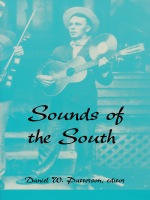 Sounds of the South
Daniel W. Patterson, ed.
Duke University Press, 1991 Beyond the familiar forms of Mississippi Delta Blues and mainstream country music, the vernacular music of the South also ranges from the ceremonial music of Native Americans, to "shout" singing in South Carolina sea islands, Cajun fiddling, and Mexican-American conjunto music. Sounds of the South assesses past efforts to document these richly varied musical forms and the challenges facing future work.
"Sounds of the South"—a 1989 conference that gathered record collectors, folklorists, musicians, record producers, librarians, archivists, and traditional music lovers—celebrated the official opening of the Southern Folklife Collection with the John Edwards Memorial Collection at the library of the University of North Carolina, Chapel Hill. Based on that conference, Sounds of the South includes Bill Malone's account of his own career as fan and scholar of country music, Paul Oliver on European blues scholarship, and Ray Funk on researching Black Gospel Quartets.
The contributors look at a number of topics related to the role of the archivist/folklorist in recording and documenting the music of the South—evaluating past fieldwork and current needs in documentation, archival issues, prospects for the publication of recordings, and changes in music and technology. Written in an accessible style, this volume will be of interest to all those concerned with preserving the music of the American South.
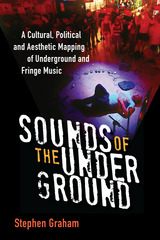 Sounds of the Underground: A Cultural, Political and Aesthetic Mapping of Underground and Fringe Music
Stephen Graham
University of Michigan Press, 2016 In basements, dingy backrooms, warehouses, and other neglected places around the world music is being made that doesn't fit neatly into popular or classical categories and genres, whose often extreme sounds and tiny concerts hover on the fringes of these commercial and cultural mainstreams. The term “underground music” as it’s being used here connects various forms of music-making that exist outside or on the fringes of mainstream institutions and culture, such as noise, free improvisation, and extreme metal. This is music that makes little money, that’s noisy and exploratory in sound and that’s largely independent from both the market and from traditional high art institutions. It sometimes exists at the fringes of these commercial and cultural institutions, as for example with experimental metal or improv, but for the most part it’s removed from the mainstream, “underground,” as we see with noise artists such as Werewolf Jerusalem or Ramleh, obscure black metal artists such as Lord Foul, and improvisers such as Maggie Nicols. In response to a lack of previous scholarly discussion, Graham provides a cultural, political, and aesthetic mapping of this broad territory. By outlining the historical background but focusing on the digital age, the underground and its fringes can be seen as based in radical anti-capitalist politics or radical aesthetics while also being tied to the political contexts and structures of late capitalism. The book explores these various ideas of separation and captures, through interviews and analysis, a critical account of both the music and the political and cultural economy of the scene.
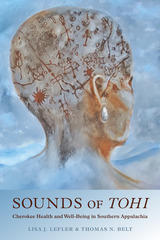 Sounds of Tohi: Cherokee Health and Well-Being in Southern Appalachia
Lisa J. Lefler and Thomas N. Belt
University of Alabama Press, 2022 Dialogue between a medical anthropologist and a Cherokee linguist about health, well-being, and environmental issues
Sounds of Tohi: Cherokee Health and Well-Being in Southern Appalachia is the result of almost two decades of work by medical anthropologist Lisa J. Lefler and Cherokee elder and traditionalist Thomas N. Belt. The narrative consists of a dialogue between them that displays traditional Indigenous knowledge as well as the importance of place for two people from cultures and histories that intersect in the mountains of Southern Appalachia. Together, Lefler and Belt decolonize thinking about health, well-being, and environmental issues through the language and experiences of people whose identity is inextricably linked to the mountains and landscape of western North Carolina.
Lefler and Belt discuss several critical cultural concepts that explain the science of relationships with this world, with the spirit world, and with people. They explore tohi, the Cherokee concept of health, which offers a more pervasive understanding of relationships in life as balanced and moving forward in a good way. They converse about the importance of matrilineality, particularly in light of community healing, the epistemologies of Cherokee cosmography, and decolonizing counseling approaches.
The discussions here offer a different way of approaching the issues that face Americans in this difficult time of division. Lefler and Belt share their urgency to take action against the wholesale exploitation of public lands and the shared environment, to work to perpetuate tribal languages, to preserve the science that can make a difference in how people treat one another, and to create more forums that are inclusive of Native and marginalized voices and that promote respect and appreciation of one another and the protection of sacred places. Throughout, they rely on the preservation of traditional knowledge, or Native science, via Native language to provide insight as to why people should recognize a connection to the land.
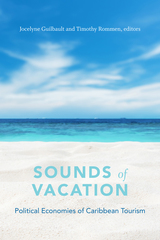 Sounds of Vacation: Political Economies of Caribbean Tourism
Jocelyne Guilbault and Timothy Rommen, editors
Duke University Press, 2019 The contributors to Sounds of Vacation examine the commodification of music and sound at popular vacation destinations throughout the Caribbean in order to tease out the relationships between political economy, hospitality, and the legacies of slavery and colonialism. Drawing on case studies from Barbados, the Bahamas, Guadeloupe, Saint Martin, and Saint Lucia, the contributors point to the myriad ways live performances, programmed music, and the sonic environment heighten tourists' pleasurable vacation experience. They explore, among other topics, issues of authenticity in Bahamian music; efforts to give tourists in Barbados peace and quiet at a former site of colonial violence; and how resort soundscapes extend beyond music to encompass the speech accents of local residents. Through interviews with resort managers, musicians, and hospitality workers, the contributors also outline the social, political, and economic pressures and interests that affect musical labor and the social encounters of musical production. In so doing, they prompt a rethinking of how to account for music and sound's resonances in postcolonial spaces.
Contributors. Jerome Camal, Steven Feld, Francio Guadeloupe, Jocelyne Guilbault, Jordi Halfman, Susan Harewood, Percy C. Hintzen, Timothy Rommen
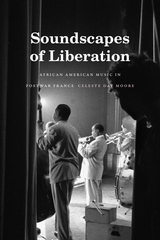 Soundscapes of Liberation: African American Music in Postwar France
Celeste Day Moore
Duke University Press, 2021 In Soundscapes of Liberation, Celeste Day Moore traces the popularization of African American music in postwar France, where it signaled new forms of power and protest. Moore surveys a wide range of musical genres, soundscapes, and media: the US military's wartime records and radio programs; the French record industry's catalogs of blues, jazz, and R&B recordings; the translations of jazz memoirs; a provincial choir specializing in spirituals; and US State Department-produced radio programs that broadcast jazz and gospel across the French empire. In each of these contexts, individual intermediaries such as educators, producers, writers, and radio deejays imbued African American music with new meaning, value, and political power. Their work resonated among diverse Francophone audiences and transformed the lives and labor of many African American musicians, who found financial and personal success as well as discrimination in France. By showing how the popularity of African American music was intertwined with contemporary structures of racism and imperialism, Moore demonstrates this music's centrality to postwar France and the convergence of decolonization, the expanding globalized economy, the Cold War, and worldwide liberation movements.
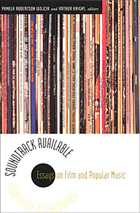 Soundtrack Available: Essays on Film and Popular Music
Pamela Robertson Wojcik and Arthur Knight, eds.
Duke University Press, 2001 From the silent era to the present day, popular music has been a key component of the film experience. Yet there has been little serious writing on film soundtracks that feature popular music. Soundtrack Available fills this gap, as its contributors provide detailed analyses of individual films as well as historical overviews of genres, styles of music, and approaches to film scoring.
With a cross-cultural emphasis, the contributors focus on movies that use popular songs from a variety of genres, including country, bubble-gum pop, disco, classical, jazz, swing, French cabaret, and showtunes. The films discussed range from silents to musicals, from dramatic and avant-garde films to documentaries in India, France, England, Australia, and the United States. The essays examine both “nondiegetic” music in film—the score playing outside the story space, unheard by the characters, but no less a part of the scene from the perspective of the audience—and “diegetic” music—music incorporated into the shared reality of the story and the audience. They include analyses of music written and performed for films, as well as the now common practice of scoring a film with pre-existing songs. By exploring in detail how musical patterns and structures relate to filmic patterns of narration, character, editing, framing, and mise-en-scene, this volume demonstrates that pop music is a crucial element in the film experience. It also analyzes the life of the soundtrack apart from the film, tracing how popular music circulates and acquires new meanings when it becomes an official soundtrack.
Contributors. Rick Altman, Priscilla Barlow, Barbara Ching, Kelley Conway, Corey Creekmur, Krin Gabbard, Jonathan Gill, Andrew Killick, Arthur Knight, Adam Knee, Jill Leeper, Neepa Majumdar, Allison McCracken, Murray Pomerance, Paul Ramaeker, Jeff Smith, Pamela Robertson Wojcik, Nabeel Zuberi
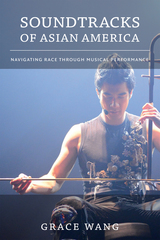 Soundtracks of Asian America: Navigating Race through Musical Performance
Grace Wang
Duke University Press, 2015 In Soundtracks of Asian America, Grace Wang explores how Asian Americans use music to construct narratives of self, race, class, and belonging in national and transnational spaces. She highlights how they navigate racialization in different genres by considering the experiences of Asians and Asian Americans in Western classical music, U.S. popular music, and Mandopop (Mandarin-language popular music). Her study encompasses the perceptions and motivations of middle-class Chinese and Korean immigrant parents intensely involved in their children's classical music training, and of Asian and Asian American classical musicians whose prominence in their chosen profession is celebrated by some and undermined by others. Wang interviews young Asian American singer-songwriters who use YouTube to contest the limitations of a racialized U.S. media landscape, and she investigates the transnational modes of belonging forged by Asian American pop stars pursuing recording contracts and fame in East Asia. Foregrounding musical spaces where Asian Americans are particularly visible, Wang examines how race matters and operates in the practices and institutions of music making.
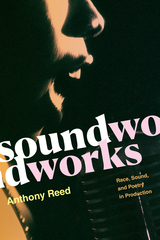 Soundworks: Race, Sound, and Poetry in Production
Anthony Reed
Duke University Press, 2021 In Soundworks Anthony Reed argues that studying sound requires conceiving it as process and as work. Since the long Black Arts era (ca. 1958–1974), intellectuals, poets, and musicians have defined black sound as radical aesthetic practice. Through their recorded collaborations as well as the accompanying interviews, essays, liner notes, and other media, they continually reinvent black sound conceptually and materially. Soundwork is Reed’s term for that material and conceptual labor of experimental sound practice framed by the institutions of the culture industry and shifting historical contexts. Through analyses of Langston Hughes’s collaboration with Charles Mingus, Amiri Baraka’s work with the New York Art Quartet, Jayne Cortez’s albums with the Firespitters, and the multimedia projects of Archie Shepp, Matana Roberts, Cecil Taylor, and Jeanne Lee, Reed shows that to grasp black sound as a radical philosophical and aesthetic insurgence requires attending to it as the product of material, technical, sensual, and ideological processes.
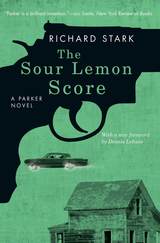 The Sour Lemon Score: A Parker Novel
Richard Stark
University of Chicago Press, 2010
An action-packed crime novel starring Parker, the heister starring in the forthcoming Shane Black film Play Dirty!
Richard Stark's Parker novels are the hardest of hard-boiled, classic crime novels where the heists are huge, the body counts are high, and the bad guys usually win.
The Parker novels have been a huge influence on countless writers and filmmakers, including Quentin Tarantino, Stephen King, George Pelecanos, Colson Whitehead, Lucy Sante, John Banville, and many more. Their stripped-down language and hard-as-nails amorality create an unforgettable world where the next score could be the big one, but your next mistake could also be your last. There's nothing else like them.
Bank robberies should run like clockwork, right? If your name’s Parker, you expect nothing less. The Sour Lemon Score finds Parker wrapping up a heist where everything has gone right. But then one of his partners gets too greedy for his own good. The four-way split following a job leaves too small a take for George Uhl, who begins to pick off his fellow heisters, one by one. The first mistake? That he doesn’t begin things by putting a bullet in Parker. That means he won’t get the chance to make a second. One of the darkest novels in the series, this caper proves the adage that no one crosses Parker and lives.
A Source Book in Animal Biology
Thomas S. Hall
Harvard University Press The two main aims of this book are to increase the general availability of classical contributions to animal biology and to present the development of thought in this field in the words of those who produced it.
The first of these aims is realized by assembling in one volume works previously scattered and, in some cases, rather rare.
The second object, that of tracing the principal patterns of development in the field, is made possible through the selection of appropriate materials and the inclusion of brief critical comments indicating the historical position of each work and its author.
 Source Book in Astronomy, 1900–1950
Harlow Shapley
Harvard University Press The phenomenal growth of modern astronomy, including the invention of the coronagraph and major developments in telescope design and photographic technique, is unparalleled in many centuries. Theories of relativity, the concept and measurement of the expanding universe, the location of sun and planets far from the center of the Milky Way, the exploration of the interiors of stars, the pulsation theory of Cepheid variation, and investigations of interstellar space have profoundly altered the astronomer's approach.
These fundamental discoveries are reported in papers by such eminent scientists as Albert Einstein, Sir Arthur S. Eddington, Henry Norris Russell, Sir James Jeans, Meghnad Saha, Otto Struve, Fred L. Whipple, Bernard Lyot, Jan H. Oort, and George Ellery Hale. The Source Book's 69 contributions represent all fields of astronomy. For example, there are reports on the equivalence of mass and energy (E = mc²) of the special theory of relativity; building the 200-inch Palomar telescope; the scattering of galaxies suggesting a rapidly expanding universe; stellar evolution; and the Big Bang and Steady State theories of the universe's origin.
 A Source Book in Astronomy and Astrophysics, 1900–1975
Kenneth Lang
Harvard University Press, 1979 When at the beginning of this century, new instrumentation in astronomy came together with innovative concepts in physics, a science was born that has yielded not only staggering quantities of information about the universe but an elegant and useful conception of its origins and behavior. This volume in Harvard’s distinguished series of Source Books serves to record the achievements of this science and illuminate its brief history by bringing together the major contributions through the year 1975.
The volume is organized to trace the development of the basic ideas of astrophysics. The 132 selections document chronologically the changing answers to such fundamental questions as: How did the solar system originate? What makes the stars shine? What lies in the vacuous space between the stars? Are the spiral nebulae distant “island universes”? Will the universe expand forever? The articles range from Hale’s popular piece in Harper’s Magazine to the tensor calculus of Schwarzschild and Einstein. They include Chamberlain and Moulton’s account of the collision hypothesis; Edwin Hubble’s identification of the Crab Nebula with the supernova of 1054; Ralph Fowler’s work on the application of degenerate gas statistics to white dwarfs; and Jan Oort’s detection of galactic rotation. The complexity and richness of twentieth-century astrophysics is felt in these selections and a sense of discovery is provided in reading, in the words of the pioneer scientist, accounts of the first observations of the cosmic rays, the Van Allen belts, the Martian volcanoes and canyons, pulsars, interstellar hydrogen, cosmic magnetic fields, quasars and the remnant background of the primeval big bang.
About half of the papers are printed in their entirety and the others in careful abridgment. Editors Kenneth Lang and Owen Gingerich provide substantial commentary that describes related developments before, during and after the selected research. Works by Heinrich Vogt, Carl Friedrich von Weizsacker, Karl Schwarzschild, Albert Einstein, Aleksandr Friedman and many others appear for the first time in translation.
 Source Book in Bioethics: A Documentary History
Albert R. Jonsen, Robert M. Veatch, and LeRoy Walters, Editors
Georgetown University Press Government agencies and commissions, courts, and legislatures have during the past several decades produced reports, rendered decisions, and passed laws that have both defined the fundamental issues in the field of bioethics and established ways of managing them in our society. Providing a history of these key bioethical decisions, this Source Book in Bioethics is the first and only comprehensive collection of the critical public documents in biomedical ethics, including many hard-to-find or out-of-print materials. Covering the period from 1947 to 1995, this volume brings together core legislative documents, court briefs, and reports by professional organizations, public bodies, and governments around the world. Sections on human experimentation, care of the terminally ill, genetics, human reproduction, and emerging areas in bioethics include such pivotal works as "The Nuremberg Code," "The Tuskegee Report," and "In the Matter of Baby M," as well less readily available documents as "The Declaration of Inuyama," the Council for International Organizations of Medical Sciences statement on genetic engineering, and "The Warnock Committee Report" on reproductive technologies from the United Kingdom. Three eminent scholars in the field provide brief introductions to each document explaining the significance of these classic sources. This historical volume will be a standard text for courses in bioethics, health policy, and death and dying, and a primary reference for anyone interested in this increasingly relevant field.
 Source Book in Chemistry, 1900–1950
Henry M. Leicester
Harvard University Press The growing interdependence of the sciences was one of the outstanding characteristics of the first half of the twentieth century. "Inevitably," Dr. Leicester points out, "this expanded vision led to closer contacts among chemists of every speciality, and also with scientists in other fields. Physics and physical chemistry were applied to organic compounds, and new substances that could not have been foreseen by the older theories were prepared. Reaction mechanisms were generalized. New borderline sciences sprang up. Chemical physics and biochemistry became sciences in their own right. Chemistry thus became a link between physics and biology."
A continuation of A Source Book in Chemistry, 1400-1900 (HUP, 1952), this volume contains selections from ninety classic papers in all branches of chemistry -- papers upon which contemporary research and practices are based.
The topics include such chemical techniques as microanalysis, polarography, hydrogen ion concentration, chromatography, electrophoresis, and the use of the ultramicroscope, the ultracentrifuge, and radioactive tracers; modern structural theories, with emphasis on crystal structure, radioactive decay, isotopes, molecular structure, the applications of quantum mechanics to chemistry, thermodynamics, electrolytes, and kinetics; the more recent studies on artificial radioactivity and the transuranium elements; organic chemistry, with reference to general synthetic methods, polymers, the structure of proteins, nucleic acids, alkaloids, steroids, and carotenoids; and biochemistry, including the concept of hormones and vitamins, separation of enzymes and viruses, metabolism of fats, proteins and carbohydrates, and energy production.
The Source Book serves as an introduction to present-day chemistry and can also be used as supplementary reading in general chemistry courses, since, in many instances, the papers explain the circumstances under which a particular discovery was made--information that is customarily lacking in textbooks. Although the selections are classified into the usual branches of the science, it will be apparent to the reader how the discoveries in any one branch were taken up and incorporated into others.
 A Source Book in Classical Analysis
Garrett Birkhoff
Harvard University Press, 1973 An understanding of the developments in classical analysis during the nineteenth century is vital to a full appreciation of the history of twentieth-century mathematical thought. It was during the nineteenth century that the diverse mathematical formulae of the eighteenth century were systematized and the properties of functions of real and complex variables clearly distinguished; and it was then that the calculus matured into the rigorous discipline of today, becoming in the process a dominant influence on mathematics and mathematical physics.
This Source Book, a sequel to D. J. Struik’s Source Book in Mathematics, 1200–1800, draws together more than eighty selections from the writings of the most influential mathematicians of the period. Thirteen chapters, each with an introduction by the editor, highlight the major developments in mathematical thinking over the century. All material is in English, and great care has been taken to maintain a high standard of accuracy both in translation and in transcription. Of particular value to historians and philosophers of science, the Source Book should serve as a vital reference to anyone seeking to understand the roots of twentieth-century mathematical thought.
 A Source Book in Geography
George Kish
Harvard University Press, 1978 This remarkable volume presents a panorama of geographical writings from Hesiod to Humboldt, from the beginnings of geographical thought in the Western world to the emergence of topical specialization. It includes a wealth of material from non-Western sources, particularly Moslem and Chinese, that has not been collected before.
The selections are arranged chronologically, and contain geographical theory, descriptions of terrestrial phenomena by early observers, and excerpts from major voyages of discovery. Some are obvious classics: Socrates on the nature of the Earth, Ezekiel’s description of the commerce of Tyre, Columbus’s first glimpse of the West Indies, Buffon on the history of the Earth, and Kant’s geographical lectures. Yet more commonly, George Kish provides a sense of the discovery with such finds as the ambassador’s report to the Caliph of Baghdad on the lands and customs of the Norsemen, the study of the Tartar Empire by John of Monte Corvino, Archbishop of Peking, and Jefferson’s private memo to Alexander von Humboldt seeking information on the American West.
Each section is highlighted by a brief but engagingly written introduction by the editor. Throughout, the unique cultural and professional perspective of Kish is very much in evidence.
 Source Book in Geology, 1900–1950
Kirtley F. Mather
Harvard University Press Since 1900, the science of geology has grown in a spectacular fashion. Not only have field studies been undertaken throughout vast areas of the earth’s surface previously unexplored or only superficially surveyed, but recent discoveries in physics, chemistry, and biology have provided geologists with new techniques of observation and experimentation, and radically new concepts and theories have been developed. This book presents source literature for the most important contributions to this remarkable expansion of geological knowledge. One of the world’s most distinguished geologists provides excerpts from sixty-five articles by sixty-three authors, selected with the advice of more than a score of leading scientists from all parts of the globe. Among the subjects discussed in this comprehensive volume are the constitution of the earth’s interior, the causes of earthquakes, radioactive timekeepers, the interpretation of submarine features and deep-sea cores, the origin and entrapment of petroleum, and crystal structure. Included are articles which led directly to the development of theories of paleomagnetism, metamorphism, cryopedology, and isostasy.
Source Book in Geology, 1900–1950 makes available several papers previously to be found in the libraries of only a few universities, and eight articles translated into English for the first time, of which four are by leading Soviet geologists.
A Source Book in Greek Science
Morris R. Cohen and I. E. Drabkin
Harvard University Press Covering the general fields of mathematics, astronomy, mathematical geography, physics, chemistry and chemical technology, geology and meteorology, biology, medicine, and physiological psychology, the present collection surveys the field of Greek scientific achievement over a thousand-year period.
Many Greek scientific treatises were written and read by cultivated people who did not regard themselves as specialists. These works should appeal today to those readers who wish to understand not only the foundations of modern science, but also a vital element of the humanistic tradition.
 A Source Book in Mathematics, 1200-1800
D. J. Struik
Harvard University Press The Source Book contains 75 excerpts from the writings of Western mathematics from the thirteenth to the end of the eighteenth century. The selection has been confined to pure mathematics or to those fields of applied mathematics that had a direct bearing on the development of pure mathematics.
The authors range from Al-Khwarizmi (a Latin translation of whose work was much used in Europe), Viète, and Oresme, to Newton, Euler, and Lagrange. The selections are grouped in chapters on arithmetic, algebra, geometry, and analysis. All the excerpts are translated into English. Some of the translations have been newly made by Mr. and Mrs. Struik; if a translation was already available it has been used, but in every such case it has been checked against the original and amended or corrected where it seemed necessary. The editor has taken considerable pains to put each selection in context by means of introductory comments and has explained obscure or doubtful points in footnote wherever necessary.
The Source Book should be particularly valuable to historians of science, but all who are concerned with the origins and growth of mathematics will find it interesting and useful.
 A Source Book in Medieval Science
Edward Grant
Harvard University Press, 1974 Modern scholarship has exposed the intrinsic importance of medieval science and confirmed its role in preserving and transmitting Greek and Arabic achievements. This Source Book offers a rare opportunity to explore more than ten centuries of European scientific thought. In it are approximately 190 selections by about 85 authors, most of them from the Latin West. Nearly half of the selections appear here for the first time in any vernacular translation.
The readings, a number of them complete treatises, have been chosen to represent “science” in a medieval rather than a modern sense. Thus, insofar as they are relevant to medieval science, selections have been drawn from works on alchemy, astrology, logic, and theology. Most of the book, however, reflects medieval understanding of, and achievements in, the mathematical, physical, and biological sciences. Critical commentary and annotation accompany the selections. An appendix contains brief biographies of all authors.
This book will be an indispensable resource for students and scholars in the history of science.
A Source Book in Physics
William Francis Magie
Harvard University Press This is the reprint of a well-known and valuable work that has been out of print and widely sought for a number of years. A volume in the series Source Books in the History of the Sciences, it consists of selections from the writings of the great physicists from the sixteenth through the nineteenth century—such figures as Galileo and Newton, Franklin and Faraday, Rowland, Hertz, and the Curies—making available to the student in English translation their most important contributions, described in their own words, together with biographical and explanatory notes by the editor.
 A Source Book in the History of Psychology
Richard J. Herrnstein
Harvard University Press This is a source book unique in its scope, clarity, and general interest. Its 116 excerpts range in time from Epicurus (ca. 300 B.C.) to the turn of the present century and sometimes, when continuity requires, a little beyond (as to K. S. Lashley, 1929). It includes excerpts from Kepler (1604) on the inverted retinal image, Descartes (1650) on the soul's interaction with the machine of the body, Newton (1675) on the seven colors of the spectrum, Locke (1700) on association of ideas, Whytt (1751) on the spinal reflex, Weber (1834) on Weber's law, Darwin (1859) on evolution, Sechenov (1863) on reflexology, Hughlings Jackson (1884) on nervous dissolution, William James (1890) on associationism, Thorndike, Pavlov, Wertheimer, Watson, and 70 other great figures in the history of psychology.
Arranged by topic rather than in the usual strict chronological order, each of the first fourteen chapters traces the development of one important subject in experimental and quantitative psychology. The final chapter discusses the history of thinking about the nature of psychology itself. The editors provide an introduction to each chapter and each excerpt, indicating the significance of the content to follow and establishing historical continuity.
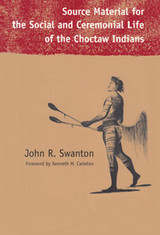 Source Material for the Social and Ceremonial Life of the Choctaw Indians
John Swanton, with a foreword by Kenneth H. Carleton
University of Alabama Press, 2001 Long considered the undisputed authority on the Indians of the southern United States, anthropologist John Swanton published this history as the Smithsonian Institution's Bureau of American Ethnology (BAE) Bulletin 103 in 1931. Swanton's descriptions are drawn from earlier records—including those of DuPratz and Romans—and from Choctaw informants. His long association with the Choctaws is evident in the thorough detailing of their customs and way of life and in his sensitivity to the presentation of their native culture.
Included are descriptions of such subjects as clans, division of labor between sexes, games, religion, war customs, and burial rites. The Choctaws were, in general, peaceful farmers living in Mississippi and southwestern Alabama until they were moved to Oklahoma in successive waves beginning in 1830, after the treaty of Dancing Rabbit Creek.
This edition includes a new foreword by Kenneth Carleton placing Swanton's work in the context of his times. The continued value of Swanton's original research makes Source Material the most comprehensive book ever published on the Choctaw people.
Source: Notes in the History of Art, volume 40 number 4 (Summer 2021)
The University of Chicago Press
University of Chicago Press Journals, 2021 This is volume 40 issue 4 of Source: Notes in the History of Art. Source was founded in 1981 as a scholarly journal in art history. Its mission is to publish articles of 2,500 words or less, accompanied by a maximum of three illustrations. The range of articles spans antiquity to the present and includes western and non-western art. The original premise has been borne out: there is an audience for scholarly articles in art history that are clearly written, adequately illustrated and above all, succinct. Furthermore, scholars welcome having a forum to present ideas and speculations that don’t warrant a major treatise, but might nevertheless make interesting “notes” for specialists and non-specialists alike.
Source: Notes in the History of Art, volume 41 number 1 (Fall 2021)
The University of Chicago Press
University of Chicago Press Journals, 2021 This is volume 41 issue 1 of Source: Notes in the History of Art. Source was founded in 1981 as a scholarly journal in art history. Its mission is to publish articles of 2,500 words or less, accompanied by a maximum of three illustrations. The range of articles spans antiquity to the present and includes western and non-western art. The original premise has been borne out: there is an audience for scholarly articles in art history that are clearly written, adequately illustrated and above all, succinct. Furthermore, scholars welcome having a forum to present ideas and speculations that don’t warrant a major treatise, but might nevertheless make interesting “notes” for specialists and non-specialists alike.
Source: Notes in the History of Art, volume 41 number 2 (Winter 2022)
The University of Chicago Press
University of Chicago Press Journals, 2022 This is volume 41 issue 2 of Source: Notes in the History of Art. Source was founded in 1981 as a scholarly journal in art history. Its mission is to publish articles of 2,500 words or less, accompanied by a maximum of three illustrations. The range of articles spans antiquity to the present and includes western and non-western art. The original premise has been borne out: there is an audience for scholarly articles in art history that are clearly written, adequately illustrated and above all, succinct. Furthermore, scholars welcome having a forum to present ideas and speculations that don’t warrant a major treatise, but might nevertheless make interesting “notes” for specialists and non-specialists alike.
Source: Notes in the History of Art, volume 41 number 3 (Spring 2022)
The University of Chicago Press
University of Chicago Press Journals, 2022 This is volume 41 issue 3 of Source: Notes in the History of Art. Source was founded in 1981 as a scholarly journal in art history. Its mission is to publish articles of 2,500 words or less, accompanied by a maximum of three illustrations. The range of articles spans antiquity to the present and includes western and non-western art. The original premise has been borne out: there is an audience for scholarly articles in art history that are clearly written, adequately illustrated and above all, succinct. Furthermore, scholars welcome having a forum to present ideas and speculations that don’t warrant a major treatise, but might nevertheless make interesting “notes” for specialists and non-specialists alike.
Source: Notes in the History of Art, volume 41 number 4 (Summer 2022)
The University of Chicago Press
University of Chicago Press Journals, 2022 This is volume 41 issue 4 of Source: Notes in the History of Art. Source was founded in 1981 as a scholarly journal in art history. Its mission is to publish articles of 2,500 words or less, accompanied by a maximum of three illustrations. The range of articles spans antiquity to the present and includes western and non-western art. The original premise has been borne out: there is an audience for scholarly articles in art history that are clearly written, adequately illustrated and above all, succinct. Furthermore, scholars welcome having a forum to present ideas and speculations that don’t warrant a major treatise, but might nevertheless make interesting “notes” for specialists and non-specialists alike.
Source: Notes in the History of Art, volume 42 number 1 (Fall 2022)
The University of Chicago Press
University of Chicago Press Journals, 2022 This is volume 42 issue 1 of Source: Notes in the History of Art. Source was founded in 1981 as a scholarly journal in art history. Its mission is to publish articles of 2,500 words or less, accompanied by a maximum of three illustrations. The range of articles spans antiquity to the present and includes western and non-western art. The original premise has been borne out: there is an audience for scholarly articles in art history that are clearly written, adequately illustrated and above all, succinct. Furthermore, scholars welcome having a forum to present ideas and speculations that don’t warrant a major treatise, but might nevertheless make interesting “notes” for specialists and non-specialists alike.
Source: Notes in the History of Art, volume 42 number 2 (Winter 2023)
The University of Chicago Press
University of Chicago Press Journals, 2023 This is volume 42 issue 2 of Source: Notes in the History of Art. Source was founded in 1981 as a scholarly journal in art history. Its mission is to publish articles of 2,500 words or less, accompanied by a maximum of three illustrations. The range of articles spans antiquity to the present and includes western and non-western art. The original premise has been borne out: there is an audience for scholarly articles in art history that are clearly written, adequately illustrated and above all, succinct. Furthermore, scholars welcome having a forum to present ideas and speculations that don’t warrant a major treatise, but might nevertheless make interesting “notes” for specialists and non-specialists alike.
Source: Notes in the History of Art, volume 42 number 4 (Summer 2023)
The University of Chicago Press
University of Chicago Press Journals, 2023 This is volume 42 issue 4 of Source: Notes in the History of Art. Source was founded in 1981 as a scholarly journal in art history. Its mission is to publish articles of 2,500 words or less, accompanied by a maximum of three illustrations. The range of articles spans antiquity to the present and includes western and non-western art. The original premise has been borne out: there is an audience for scholarly articles in art history that are clearly written, adequately illustrated and above all, succinct. Furthermore, scholars welcome having a forum to present ideas and speculations that don’t warrant a major treatise, but might nevertheless make interesting “notes” for specialists and non-specialists alike.
Source: Notes in the History of Art, volume 43 number 1 (Fall 2023)
The University of Chicago Press
University of Chicago Press Journals, 2023 This is volume 43 issue 1 of Source: Notes in the History of Art. Source was founded in 1981 as a scholarly journal in art history. Its mission is to publish articles of 2,500 words or less, accompanied by a maximum of three illustrations. The range of articles spans antiquity to the present and includes western and non-western art. The original premise has been borne out: there is an audience for scholarly articles in art history that are clearly written, adequately illustrated and above all, succinct. Furthermore, scholars welcome having a forum to present ideas and speculations that don’t warrant a major treatise, but might nevertheless make interesting “notes” for specialists and non-specialists alike.
Source: Notes in the History of Art, volume 43 number 2 (Winter 2024)
The University of Chicago Press
University of Chicago Press Journals, 2024 This is volume 43 issue 2 of Source: Notes in the History of Art. Source was founded in 1981 as a scholarly journal in art history. Its mission is to publish articles of 2,500 words or less, accompanied by a maximum of three illustrations. The range of articles spans antiquity to the present and includes western and non-western art. The original premise has been borne out: there is an audience for scholarly articles in art history that are clearly written, adequately illustrated and above all, succinct. Furthermore, scholars welcome having a forum to present ideas and speculations that don’t warrant a major treatise, but might nevertheless make interesting “notes” for specialists and non-specialists alike.
Source: Notes in the History of Art, volume 43 number 3 (Spring 2024)
The University of Chicago Press
University of Chicago Press Journals, 2024 This is volume 43 issue 3 of Source: Notes in the History of Art. Source was founded in 1981 as a scholarly journal in art history. Its mission is to publish articles of 2,500 words or less, accompanied by a maximum of three illustrations. The range of articles spans antiquity to the present and includes western and non-western art. The original premise has been borne out: there is an audience for scholarly articles in art history that are clearly written, adequately illustrated and above all, succinct. Furthermore, scholars welcome having a forum to present ideas and speculations that don’t warrant a major treatise, but might nevertheless make interesting “notes” for specialists and non-specialists alike.
Source: Notes in the History of Art, volume 43 number 4 (Summer 2024)
The University of Chicago Press
University of Chicago Press Journals, 2024 This is volume 43 issue 4 of Source: Notes in the History of Art. Source was founded in 1981 as a scholarly journal in art history. Its mission is to publish articles of 2,500 words or less, accompanied by a maximum of three illustrations. The range of articles spans antiquity to the present and includes western and non-western art. The original premise has been borne out: there is an audience for scholarly articles in art history that are clearly written, adequately illustrated and above all, succinct. Furthermore, scholars welcome having a forum to present ideas and speculations that don’t warrant a major treatise, but might nevertheless make interesting “notes” for specialists and non-specialists alike.
Source: Notes in the History of Art, volume 44 number 1 (Fall 2024)
The University of Chicago Press
University of Chicago Press Journals, 2024 This is volume 44 issue 1 of Source: Notes in the History of Art. Source was founded in 1981 as a scholarly journal in art history. Its mission is to publish articles of 2,500 words or less, accompanied by a maximum of three illustrations. The range of articles spans antiquity to the present and includes western and non-western art. The original premise has been borne out: there is an audience for scholarly articles in art history that are clearly written, adequately illustrated and above all, succinct. Furthermore, scholars welcome having a forum to present ideas and speculations that don’t warrant a major treatise, but might nevertheless make interesting “notes” for specialists and non-specialists alike.
Source: Notes in the History of Art, volume 44 number 2 (Winter 2025)
The University of Chicago Press
University of Chicago Press Journals, 2025 This is volume 44 issue 2 of Source: Notes in the History of Art. Source was founded in 1981 as a scholarly journal in art history. Its mission is to publish articles of 2,500 words or less, accompanied by a maximum of three illustrations. The range of articles spans antiquity to the present and includes western and non-western art. The original premise has been borne out: there is an audience for scholarly articles in art history that are clearly written, adequately illustrated and above all, succinct. Furthermore, scholars welcome having a forum to present ideas and speculations that don’t warrant a major treatise, but might nevertheless make interesting “notes” for specialists and non-specialists alike.
Source: Notes in the History of Art, volume 44 number 3 (Spring 2025)
The University of Chicago Press
University of Chicago Press Journals, 2025 This is volume 44 issue 3 of Source: Notes in the History of Art. Source was founded in 1981 as a scholarly journal in art history. Its mission is to publish articles of 2,500 words or less, accompanied by a maximum of three illustrations. The range of articles spans antiquity to the present and includes western and non-western art. The original premise has been borne out: there is an audience for scholarly articles in art history that are clearly written, adequately illustrated and above all, succinct. Furthermore, scholars welcome having a forum to present ideas and speculations that don’t warrant a major treatise, but might nevertheless make interesting “notes” for specialists and non-specialists alike.
Source: Notes in the History of Art, volume 44 number 4 (Summer 2025)
The University of Chicago Press
University of Chicago Press Journals, 2025 This is volume 44 issue 4 of Source: Notes in the History of Art. Source was founded in 1981 as a scholarly journal in art history. Its mission is to publish articles of 2,500 words or less, accompanied by a maximum of three illustrations. The range of articles spans antiquity to the present and includes western and non-western art. The original premise has been borne out: there is an audience for scholarly articles in art history that are clearly written, adequately illustrated and above all, succinct. Furthermore, scholars welcome having a forum to present ideas and speculations that don’t warrant a major treatise, but might nevertheless make interesting “notes” for specialists and non-specialists alike.
Source: Notes in the History of Art, volume 45 number 1 (Fall 2025)
The University of Chicago Press
University of Chicago Press Journals, 2025 This is volume 45 issue 1 of Source: Notes in the History of Art. Source was founded in 1981 as a scholarly journal in art history. Its mission is to publish articles of 2,500 words or less, accompanied by a maximum of three illustrations. The range of articles spans antiquity to the present and includes western and non-western art. The original premise has been borne out: there is an audience for scholarly articles in art history that are clearly written, adequately illustrated and above all, succinct. Furthermore, scholars welcome having a forum to present ideas and speculations that don’t warrant a major treatise, but might nevertheless make interesting “notes” for specialists and non-specialists alike.
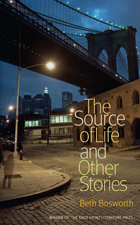 The Source of Life and Other Stories
Beth Bosworth
University of Pittsburgh Press, 2012 From “The Eight Rhetorical Mode”
Later he asked, “Would you like to go for a hike sometime?” and two trains of thought left the station: He means to get to know me and we might leave the city together and it’s been a long time since I climbed a mountain. That train chugged into a wider brighter country all the time. The other train went by another route through the panicked interior. He’s a lunatic, it whistled. He’s been in and out of hospitals. He will take you to a mountaintop and throw you right off into the bright air: choo choo!
Post-divorce dating is one more cause for celebration (or a quick call in to the police) in Beth Bosworth’s revelatory new book, The Source of Life and Other Stories. The spine of this collection is a series of linked stories about Ruth Stein, a Brooklyn author whose first book has exposed her father’s abuses; while the voice here, speaking across a lifetime, ranges from bittersweet to humorous to lethal. In other stories Bosworth’s narrators—a mother left to care for her son’s suicidal dog, an editor haunted by a dog-eared manuscript—seem to grab hold of the reins and run off with their fates. Meanwhile Bosworth explores the extended family, the bonds of friendship, an apocalyptic Vermont, the rank yet redeemable Gowanus Canal; also rites of passage, race relations, divorce, middle-aged romance, dementia, funerals, alcoholism, and the Jewish religion. Reality is just another stumbling block for Bosworth’s characters, who might help themselves but don’t always choose to. There are leaps of faith here, nonetheless, as the collection dispenses a kind of narrative psychotropic for survival and redemption, with a chaser of humor mixed in.
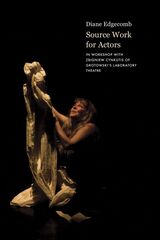 Source Work for Actors
Diane Edgecomb
Seagull Books, 2025 An actor delves into the electrifying world of Jerzy Grotowski’s Polish Laboratory Theatre.
The legacy of Polish theatre director Jerzy Grotowski and the skills of his legendary actors come to life in this personal account of a workshop and intensive with Laboratory Theatre master actor Zbigniew Cynkutis. Drawing from her extensive notes and recordings, Diane Edgecomb takes us to the heart of the workshop experience as a young actor determined to make this process her own. Cynkutis guides the participants to a deep understanding of his artistic philosophy and craft, giving them invaluable tools and sources to enrich their acting. Stimulated by a developing series of tasks, Laboratory Theatre training exercises, and by Cynkutis’ startling demonstrations, the group is challenged to bring their whole selves to the work and to reimagine what is possible in theatre.
The intensive proceeds from exercises familiar to those who have studied Grotowski to innovative explorations of dramatic text and character which draw from theatre sources based in the primal energies of nature. Those who have been mystified by academic writings on the work of the Laboratory Theatre will find this personal story refreshing and accessible, filled with advice and exercises grounded in the rich conversational style of a charismatic master actor. Links to audio files of Cynkutis speaking as he leads the work lend an invaluable immersive element to the book.
This compelling volume bears witness to the power of a deeply visceral form of theatre and illustrates why the work of Grotowski and his actors has had such a profound impact on generations of theatre artists. It is sure to stimulate students, challenge directors and inspire innovative work.
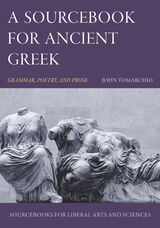 A Sourcebook for Ancient Greek: Grammar, Poetry, and Prose
John Tomarchio
Catholic University of America Press, 2022 This book was designed for students transitioning from the study of Greek grammar to translation of texts. It was developed in classroom use for classroom use, in the context of an integrated Great Books program in liberal arts and sciences. It is meant for students not only of Classics, but more, for students of Humanities interested in direct engagement of primary sources. Each Greek text offered for translation was chosen for its theoretical interest as well as the interest of its Greek.
The selections of Greek literature offered in this Sourcebook are wide-ranging. The indisputable standard of excellence for classicists is of course the Attic dialect of Athens in its glory. However, this Sourcebook is meant for students of liberal arts and sciences whose interests range far more widely. Thus, it does not hesitate to extend not only backward to the archaic Greek of Homer, but also forward to the koine Greek of the Alexandrian and Roman empires. Greek works were chosen for being seminal to Western thinking today, chosen to give students of Western arts and sciences introductions to its Greek sources
Naturally, Greek grammar is taught to the newcomer analytically and sequentially, but the continuing student needs to synthesize these distended enumerations of elements and principles. Accordingly, grammatical synopses are not appended as reference tables but placed front and center as objects of study. The grammar tables offer synoptic views of integral parts of Greek grammar to show the form and logic of the whole part of speech or part of a sentence. On the basis of these tables, detailed grammatical notes and commentary appended to Greek selections that follow are tailored for continuing students.
Sourcebook for Ancient Mesopotamian Medicine
JoAnn Scurlock
SBL Press, 2014
An introductory guide for scholars and students of the ancient Near East and the history of medicine
In this collection JoAnn Scurlock assembles and translates medical texts that provided instructions for ancient doctors and pharmacists. Scurlock unpacks the difficult, technical vocabulary that describes signs and symptoms as well as procedures and plants used in treatments. This fascinating material shines light on the development of medicine in the ancient Near East, yet these tablets were essentially inaccessible to anyone without an expertise in cuneiform. Scurlock’s work fills this gap by providing a key resource for teaching and research.
Features:
- Accessible translations and transliterations for both specialists and non-specialists
- Texts include a range of historical periods and regions
- Therapeutic, pharmacological, and diagnostic texts
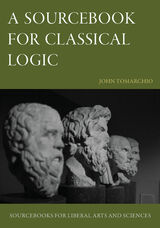 A Sourcebook for Classical Logic
John Tomarchio
Catholic University of America Press, 2023 This Sourcebook offers a brief sequence in classical Logic befitting an unspecialized study for students of liberal arts and sciences. The sequence is made up of select texts of the Aristotelian Organon, mostly the opening chapters of each treatise, in the traditional order, where Aristotle lays out the primary elements of reasoning. Study aids accompany these primary texts, providing students with mnemonics and diagrams developed for classroom use in the great books programs St. John’s College. The culmination of this Aristotelian Logic sequence is selections from the Posterior Analytics where Aristotle offers an account of the demonstrative reasoning of theoretical sciences. The interest of this Sourcebook, as of Aristotelian Logic, is search for such knowledge.
This Aristotelian sequence is preceded by a sequence of readings in Medieval grammatica speculativa, or philosophy of language. This propaedeutic sequence begins with an ancient source to which that metaphysically minded ‘grammar’ recurred, namely Augustine’s De magistro, or On the Teacher. It is a dialogue between Augustine and his son about the triadic relation of the spoken word to the word thought and the thing thought about. This aporetic dialectic between Augustine and his son proves effective in awakening students to the theoretical stakes of Logic. Similarly, from later theological inquiries into language for purposes of scriptural interpretation more general theories of language emerged. The theoretical uses thus made of Aristotelian Logic by the Jewish theologian Maimonides and the Catholic Thomas Aquinas whet student appetite for the technical matter of the Organon sequence to follow.
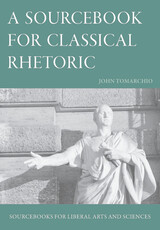 A Sourcebook for Classical Rhetoric
John Tomarchio
Catholic University of America Press, 2023 This Sourcebook is intended for students of liberal arts and great books. It treats such books as primary sources for inquiring into the nature of human speech because they clarify the terms and stakes of perennial questions thinking human beings ask themselves about persuasive speaking. By crystallizing viable claims about the nature of what we confront in politics and society—live claims for us to confront in our own, with the stakes of that confrontation being live as well—they originate a dialectic with one another and with us their readers.
Cicero called rhetoric a liberal art necessary for every citizen of a free republic. In the polities of ancient Greece and Rome, rhetoric was politically potent because oratory was the regular means of political decision. Words were decisive, often a matter of life and death, not merely for individuals but for peoples. In human milieux where human speech is so politically decisive, reflection upon its nature became keen.
The selections of this sourcebook have been arranged in three sequences. The first two sequences comprise philosophical dialogues on the ends of rhetoric. Selections from Plato’s Gorgias, Phaedrus, and Apology examine the rhetorician or teacher of rhetoric, and then Cicero’s De oratore offers us a dialectic among practitioners about its practice. The philosophical dialogues on the art’s intended ends and causative effects provide the theoretical and ethical context for examining its means. These philosophical dialogues are thus propaedeutic to the third sequence, which focusses on the art itself with selections from Aristotle’s treatise On Rhetoric, paired with orations from Thucydides’ History of the Peloponnesian War.
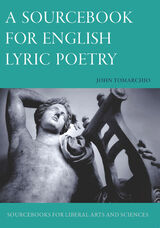 A Sourcebook for English Lyric Poetry
John Tomarchio
Catholic University of America Press, 2023 This Sourcebook is not a survey of English lyric poems but rather a florilegium. It singles out great poems of the last five centuries worthy of study in liberal education—in Great Books programs, Core curricula, and the Humanities generally. The poems were selected not as representative of the author’s time or oeuvre, but rather as addressed to the reader and the reader’s time by virtue of their representing the nature of things. That is what makes a poem great and worthy of inquiry, in John Tomarchio’s judgement. The capacities, needs, and interests of students of such great poetry were the principles of selection.
To arrange the great poems selected Tomarchio looked to their meters as a formal measure intrinsic to them, rather than to epochal divisions. The paradigmatic example of this is the classical English sonnet. Many an English poet has submitted themselves to the self-discipline of this poetic form born in the classical period of English poetry in Tudor England. But what of such historical context? When Robert Frost chooses to write a sonnet in the 20th century, why associate it more with the free verse of e.e. cummings than of the quincentenary sonnet tradition his chosen form invokes for context?
The Sourcebook arranges poems according to five such metrical modes, however along with an Index by poet as well . Tomarchio’s enumeration of poetic modes does not presume to be either exhaustive or normative, but rather interpretative of poetic practices and hopefully more elucidative than historical considerations. Further, as understanding great poetry’s means deepens interpretation of ends, the Sourcebook begins with a propaedeutic “grammar” that introduces students to such devices of poetic art as meter, rhyme, and trope.
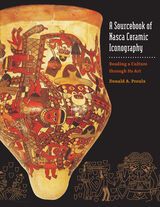 A Sourcebook of Nasca Ceramic Iconography: Reading a Culture through Its Art
Proulx, Donald A.
University of Iowa Press, 2006 For almost eight hundred years (100 BC–AD 650) Nasca artists modeled and painted the plants, animals, birds, and fish of their homeland on Peru’s south coast as well as numerous abstract anthropomorphic creatures whose form and meaning are sometimes incomprehensible today. In this first book-length treatment of Nasca ceramic iconography to appear in English, drawing upon an archive of more than eight thousand Nasca vessels from over 150 public and private collections, Donald Proulx systematically describes the major artistic motifs of this stunning polychrome pottery, interprets the major themes displayed on this pottery, and then uses these descriptions and his stimulating interpretations to analyze Nasca society. After beginning with an overview of Nasca culture and an explanation of the style and chronology of Nasca pottery, Proulx moves to the heart of his book: a detailed classification and description of the entire range of supernatural and secular themes in Nasca iconography along with a fresh and distinctive interpretation of these themes. Linking the pots and their iconography to the archaeologically known Nasca society, he ends with a thorough and accessible examination of this ancient culture viewed through the lens of ceramic iconography. Although these static images can never be fully understood, by animating their themes and meanings Proulx reconstructs the lifeways of this complex society.
 Sourcebook on the Environment: A Guide to the Literature
Kenneth A. Hammond, George Macinko, and Wilma B. Fairchild
University of Chicago Press, 1978 The Sourcebook on the Environment, produced in conjunction with the Association of American Geographers, provides a much-needed, objective, and comprehensive guide to environmental studies. Twenty-six specialists have compiled and critically annotated commentaries on the sources treating a broad spectrum of crucial issues, ranging from resource scarcity to the environmental impact of urbanization. Their syntheses of information encompass questions of both long-range value ("Environment and the Quality of Life") and immediate utility ("Solid Waste and Resource Recovery") as well as thoroughgoing state-of-the-art reviews ("Energy and the Environment").
Beginning with an introduction to various philosophies and perspectives, the Sourcebook examines major elements of the environment and selected case studies of human alteration of our surroundings. The essential references in each field are carefully presented, and directions are given for examining more advanced and specialized works. Appendixes on selected periodicals, the latest relevant federal legislation, and environmental organizations point to further areas of investigation. To maintain its value in this volatile area, this indispensable work will be periodically revised and updated.
Sources for the Study of Greek Religion, Corrected Edition
David G. Rice
SBL Press, 2009 Since its initial publication in 1979, Sources for the Study of Greek Religion has become an essential classroom resource in the field of classical studies. The Society of Biblical Literature is pleased to present a corrected edition—in a new, attractive, and electronic-friendly format—with hopes that it will inspire a new generation of classicists and religious historians.
The Sources of Christian Ethics
Servais Pinckaers
Catholic University of America Press, 2013 First published in 1985 as Les sources de la morale chrétienne by University Press Fribourg, this work has been recognized by scholars worldwide as one of the most important books in the field of moral theology
 The Sources of Democratic Responsiveness in Mexico
Matthew R. Cleary
University of Notre Dame Press, 2010
Matthew Cleary investigates the political sources of improved government responsiveness in contemporary Mexico. He draws on existing theoretical frameworks that explain responsiveness (the degree to which government output matches public preferences) as a function of electoral accountability mechanisms, direct participatory pressure, or a combination of the two. Cleary demonstrates that electoral competition is not the cause of improved responsiveness among Mexican municipal governments. Instead, he attributes responsiveness in the 1980s and 1990s to a prior qualitative shift in participatory politics that began in the 1970s and continues to this day. The inability of electoral competition to improve responsiveness is, Cleary argues, a function of Mexico's political institutions. The book demonstrates the implications of thinking broadly about the variety of strategies that citizens use, on a daily basis, to influence the behavior of politicians.
The Sources of Democratic Responsiveness in Mexico exposes serious flaws in conventional understandings of electoral competition in Mexico. Cleary's careful critique of electoral accountability theory and his theory of participatory responsiveness address broader theoretical and conceptual issues that extend beyond the Mexican situation.
"This book does an excellent job of exposing the weaknesses of elections as mechanisms of democratic accountability, both in the abstract and with regard to the specific features of the Mexican political system. Most scholars accept the electoral model as a given. Cleary makes it theoretically clear why this is deeply problematic, not by asserting that elections never perform an accountability function, but rather by showing that they may not, and that we ignore this possibility at our peril." --Marcus Kurtz, Ohio State University
". . . an important contribution to the literature on problems of democracy in Latin America. Cleary offers a careful, nuanced analysis of the limits of electoral competition as a democratic instrument for improving the responsiveness of government to citizens in contemporary Mexico." --Richard Snyder, Brown University
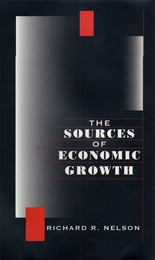 The Sources of Economic Growth
Richard R. Nelson
Harvard University Press, 1996 Technological advance is the key driving force behind economic growth, argues Richard Nelson. Investments in physical and human capital contribute to growth largely as handmaidens to technological advance. Technological advance needs to be understood as an evolutionary process, depending much more on ex post selection and learning than on ex ante calculation. That is why it proceeds much more rapidly under conditions of competition than under monopoly or oligopoly.
Nelson also argues that an adequate theory of economic growth must incorporate institutional change explicitly. Drawing on a deep knowledge of economic and technological history as well as the tools of economic analysis, Nelson exposes the intimate connections among government policies, science-based universities, and the growth of technology. He compares national innovation systems, and explores both the rise of the United States as the world’s premier technological power during the first two-thirds of the twentieth century and the diminishing of that lead as other countries have largely caught up.
Lucid, wide-ranging, and accessible, the book examines the secrets of economic growth and why the U.S. economy has been anemic since the early 1970s.
The Sources of Hojeda's La Cristiada
Sister Mary Edgar Meyer, O.S.F.
University of Michigan Press, 1953 La Cristiada, by Fray Diego de Hojeda, is one of the great religious epics of the seventeenth century. The present work, the result of a vast amount of research, attempts to discover the sources used by Hojeda. As one reads it, one feels that Hojeda must have had access to most, if not all, of the literary material available in his day—the classical, medieval, Renaissance, and contemporary literatures, sacred history, and mythology, and the works of the mystics and the patristic writers. La Cristiada, so baroque in its structure, is a mirror of the times and an epitome of the learning and culture that prevailed and to which one could attain during the Golden Age of Spain. The two chapters on legends and traditions make this source study of interest not only to scholars and students of Spanish literature, but also to students of Christian lore.
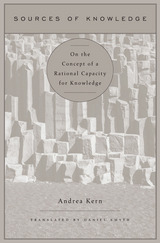 Sources of Knowledge: On the Concept of a Rational Capacity for Knowledge
Andrea Kern
Harvard University Press, 2017 How can human beings, who are liable to error, possess knowledge? The skeptic finds this question impossible to answer. If we can err, then it seems the grounds on which we believe do not rule out that we are wrong. Most contemporary epistemologists agree with the skeptic that we can never believe on grounds that exclude error. Sources of Knowledge moves beyond this predicament by demonstrating that some major problems of contemporary philosophy have their roots in the lack of a metaphysical category that is fundamental to our self-understanding: the category of a rational capacity for knowledge.
Andrea Kern argues that we can disarm skeptical doubt by conceiving knowledge as an act of a rational capacity. This enables us to appreciate human fallibility without falling into skepticism, for it allows us to understand how we can form beliefs about the world on grounds that exclude error. Knowledge is a fundamental capacity of the human mind. Human beings, as such, are knowers. In this way, Sources of Knowledge seeks to understand knowledge from within our self-understanding as knowers. It develops a metaphysics of the human mind as existing through knowledge of itself, which knowledge—as the human being is finite—takes the form of a capacity.
Regaining the concept of a rational capacity for knowledge, Kern makes a powerful and original contribution to philosophy that reinvigorates the tradition of Aristotle and Kant—thinkers whose relevance for contemporary epistemology has yet to be fully appreciated.
 Sources of the Self: The Making of the Modern Identity
Charles Taylor
Harvard University Press, 1989 “Taylor has taken on the most delicate and exacting of philosophical questions, the question of who we are and how we should live…and he has made this an adventure of self-discovery for his reader.” —Martha Nussbaum, New Republic
In this extensive inquiry into the sources of modern selfhood, Charles Taylor demonstrates just how rich and precious those resources are. The modern turn to subjectivity, with its attendant rejection of an objective order of reason, has led—it seems to many—to mere subjectivism at the mildest and to sheer nihilism at the worst. Many critics believe that the modern order has no moral backbone and has proved corrosive to all that might foster human good. Taylor rejects this view. He argues that, properly understood, our modern notion of the self provides a framework that more than compensates for the abandonment of substantive notions of rationality.
The major insight of Sources of the Self is that modern subjectivity, in all its epistemological, aesthetic, and political ramifications, has its roots in ideas of human good. After first arguing that contemporary philosophers have ignored how self and good connect, the author defines the modern identity by describing its genesis. His effort to uncover and map our moral sources leads to novel interpretations of most of the figures and movements in the modern tradition. Taylor shows that the modern turn inward is not disastrous but is in fact the result of our long efforts to define and reach the good. At the heart of this definition he finds what he calls the affirmation of ordinary life, a value which has decisively if not completely replaced an older conception of reason as connected to a hierarchy based on birth and wealth. In telling the story of a revolution whose proponents have been Augustine, Montaigne, Luther, and a host of others, Taylor’s goal is in part to make sure we do not lose sight of their goal and endanger all that has been achieved. Sources of the Self provides a decisive defense of the modern order and a sharp rebuff to its critics.
Sources of the Synoptic Gospels
Carl S. Patton
University of Michigan Press, 1915 This volume considers recent investigations into the Synoptic Problem and its recent analysis, and pushes the question farther based on that body of research. Minute differences among versions of the Gospels are compared, toward arriving at a better sense of underlying textual transmission.
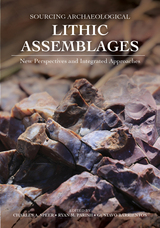 Sourcing Archeological Lithic Assemblages: New Perspectives and Integrated Approaches
Edited by Charles Speer, Ryan M. Parish, and Gustavo Barrientos
University of Utah Press, 2022 For most of our existence, humans have manipulated stone into tools that are essential for survival. Generally resistant to degradation, stone tools comprise a large portion of the material culture found at archaeological sites worldwide. Recovery of stone tools during archaeological excavation indicates the location where they were discarded, often tied to where they were used. “Sourcing” refers to attempts to determine the origin of the raw materials used to produce these tools. Knowing the beginning and end points of a tool’s use-life, as well as the likely paths it took between those two locations, can offer insight into trade and procurement patterns. The scholars gathered in this volume employ a variety of unique approaches to real-life contexts in multiple geographic regions. These studies illustrate the numerous, robust options available to archaeologists and researchers today, as well as the problems that must be faced and resolved.
Part 1 of the book explores technological approaches to sourcing in conjunction with innovative survey strategies. The chapters describe a particular method while often offering suggestions for improving the chemical analysis. Part 2 focuses on region-specific and methodological sourcing applications. In a concluding review, Michael D. Glascock critiques each of the chapters and presents his views, developed across 40 years of work in the field, on sourcing raw materials. Broadly, these contributions demonstrate how knowledge of lithic sources, geologic processes, the nature of variation, and regional availability can provide a more thorough understanding of past peoples.
Sourcing Prehistoric Ceramics at Chodistaas Pueblo, Arizona: The Circulation of People and Pots in the Grasshopper Region
María Nieves Zedeño
University of Arizona Press, 1994 For decades archaeologists have used pottery to reconstruct the lifeways of ancient populations. It has become increasingly evident, however, that to make inferences about prehistoric economic, social, and political activities through the patterning of ceramic variation, it is necessary to determine the location where the vessels were made. Through detailed analysis of manufacturing technology and design styles as well as the use of modern analytical techniques such as neutron activation analysis, Zedeño here demonstrates a broadly applicable methodology for identifying local and nonlocal ceramics.
South × South: Poems from Antarctica
Charles Hood
Ohio University Press, 2013 A vivid and insightful look at the culture and terrain of Antarctica, as well as the people who choose to live and work there, South × South celebrates and explores life at the extreme edge of our planet. Blending travel narrative, historical research, and the surprises of magical realism, Hood presents life in Antarctica and the history of polar aviation as both a miracle of achievement yet also as a way to understand humanity’s longing to be creatures of the heavens as well as the earth. South × South is poetry at its most inventive and surprising, insisting that the world is stranger and more glorious than we ever might have guessed.
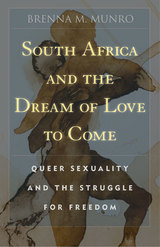 South Africa and the Dream of Love to Come: Queer Sexuality and the Struggle for Freedom
Brenna M. Munro
University of Minnesota Press, 2012 After apartheid, South Africa established a celebrated new political order that imagined the postcolonial nation as belonging equally to the descendants of indigenous people, colonizing settlers, transported slaves, indentured laborers, and immigrants. Its constitution, adopted in 1996, was the first in the world to include gays and lesbians as full citizens. Brenna M. Munro examines the stories that were told about sexuality, race, and nation throughout the struggle against apartheid in order to uncover how these narratives ultimately enabled gay people to become imaginable as fellow citizens. She also traces how the gay, lesbian, or bisexual person appeared as a stock character in the pageant of nationhood during the transition to democracy. In the process, she offers an alternative cultural history of South Africa. Munro asserts that the inclusion of gay people made South Africans feel “modern”—at least for a while. Being gay or being lesbian was reimagined in the 1990s as distinctly South African, but the “newness” that made these sexualities apt symbols for a transformed nation can also be understood as foreign and un-African. Indeed, a Western-style gay identity is often interpreted through the formula “gay equals modernity equals capitalism.” As South Africa’s reentrance into the global economy has failed to bring prosperity to the majority of its citizens, homophobic violence has been on the rise. Employing a wide array of texts—including prison memoirs, poetry, plays, television shows, photography, political speeches, and the postapartheid writings of Nobel Laureates Nadine Gordimer and J. M. Coetzee—Munro reports on how contemporary queer activists and artists are declining to remain ambassadors for the “rainbow nation” and refusing to become scapegoats for the perceived failures of liberation and liberalism.
 South Africa in the Global Imaginary, Volume 22
Bethlehem Kock, Louise Bethlehem, and Sonja Laden, eds.
Duke University Press Winner of the 2001 CELJ Award for the Best Special Issue This special issue of Poetics Today explores the development of a South African literary identity in the face of its staggering cultural, historical, and linguistic diversity. The collection uses the idea of the "global imaginary" to explore the ways the outside world has constructed ideas about South African literature as well as the way South Africans themselves have fashioned their literary selfhood. Articles address the legacy of colonialism and apartheid and wrestle with the fact that in spite of the fact that there are eleven official languages in South Africa and that many of the cultures have historically relied on an oral tradition, the dominant works continue to be those that are written down, in English. As de Kock writes in his introduction, the collection "raises a multiplicity of questions about the colonization of culture." There has been a "trope of binary pairing," he writes, between white and black, civilized and backward, home and exile, colonizer and colonized, which obscures the richness and complexity of the South African literary tradition. This collection promises to at least begin to correct that oversimplification. Contributors: Louise Bethlehem, Jonathan Crewe, Dirk Klopper, Leon de Kock, Loren Kruger, Sonja Laden, Simon Lewis, Peter Merrington, Patricia Watson Shariff, Pippa Skotnes
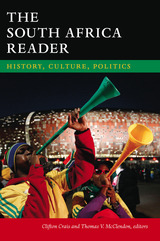 The South Africa Reader: History, Culture, Politics
Clifton Crais and Thomas V. McClendon, eds.
Duke University Press, 2013 The South Africa Reader is an extraordinarily rich guide to the history, culture, and politics of South Africa. With more than eighty absorbing selections, the Reader provides many perspectives on the country's diverse peoples, its first two decades as a democracy, and the forces that have shaped its history and continue to pose challenges to its future, particularly violence, inequality, and racial discrimination. Among the selections are folktales passed down through the centuries, statements by seventeenth-century Dutch colonists, the songs of mine workers, a widow's testimony before the Truth and Reconciliation Commission, and a photo essay featuring the acclaimed work of Santu Mofokeng. Cartoons, songs, and fiction are juxtaposed with iconic documents, such as "The Freedom Charter" adopted in 1955 by the African National Congress and its allies and Nelson Mandela's "Statement from the Dock" in 1964. Cacophonous voices—those of slaves and indentured workers, African chiefs and kings, presidents and revolutionaries—invite readers into ongoing debates about South Africa's past and present and what exactly it means to be South African.
South African Cinema 1896-2010
Martin Botha
Intellect Books, 2012 Taking an inclusive approach to South African film history, this volume represents an ambitious attempt to analyze and place in appropriate sociopolitical context the aesthetic highlights of South African cinema from 1896 to the present. Thoroughly researched and fully documented by renowned film scholar Martin Botha, the book focuses on the many highly creative uses of cinematic form, style, and genre as set against South Africa’s complex and often turbulent social and political landscape. Included are more than two hundred illustrations and a look at many aspects of South African film history that haven’t been previously documented.
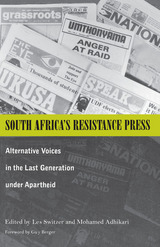 South Africa’s Resistance Press: Alternative Voices in the Last Generation under Apartheid
Les Switzer
Ohio University Press, 2000 South Africa's Resistance Press is a collection of essays celebrating the contributions of scores of newspapers, newsletters, and magazines that confronted the state in the generation after 1960. These publications contributed in no small measure to reviving a mass movement inside South Africa that would finally bring an end to apartheid. This marginalized press had an impact on its audience that cannot be measured in terms of the small number of issues sold, the limited amount of advertising revenue raised, or the relative absence of effective marketing and distribution strategies. These journalists rendered communities visible that were too often invisible and provided a voice for those too often voiceless. They contributed immeasurably to broadening the concept of a free press in South Africa. The guardians of the new South Africa owe these publications a debt of gratitude that cannot be repaid.
South Africa’s Struggle for Human Rights
Saul Dubow
Ohio University Press, 2012 The human rights movement in South Africa’s transition to a postapartheid democracy has been widely celebrated as a triumph for global human rights. It was a key aspect of the political transition, often referred to as a miracle, which brought majority rule and democracy to South Africa. The country’s new constitution, its Truth and Reconciliation Commission, and the moral authority of Nelson Mandela stand as exemplary proof of this achievement. Yet, less than a generation after the achievement of freedom, the status of human rights and constitutionalism in South Africa is uncertain. In government the ANC has displayed an inconsistent attitude to the protection, and advancement, of hard-won freedoms and rights, and it is not at all clear that a broader civic and political consciousness of the importance of rights is rooting itself more widely in popular culture.
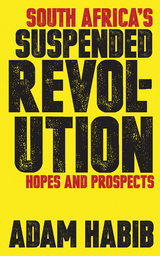 South Africa’s Suspended Revolution: Hopes and Prospects
Adam Habib
Ohio University Press, 2013 South Africa’s Suspended Revolution tells the story of South Africa’s democratic transition and the prospects for the country to develop a truly inclusive political system. Beginning with an account of the transition in the leadership of the African National Congress from Thabo Mbeki to Jacob Zuma, the book then broadens its lens to examine the relationship of South Africa’s political elite to its citizens. It also examines the evolution of economic and social policies through the democratic transition, as well as the development of a postapartheid business community and a foreign policy designed to re-engage South Africa with the world community. Written by one of South Africa’s leading scholars and political commentators, the book combines historical and contemporary analysis with strategies for an alternative political agenda. Adam Habib connects the lessons of the South African experience with theories of democratic transition, social change, and conflict resolution. Political leaders, scholars, students, and activists will all find material here to deepen their understanding of the challenges and opportunities of contemporary South Africa.
South America and the Treaty of Versailles
Michael Streeter
Haus Publishing, 2011 While Portuguese-speaking Brazil declared war on Germany in the First World War, the rest of South America held back. In the end no other South American nation joined the fighting. But four - Bolivia, Ecuador, Peru and Uruguay - did break off diplomatic relations with Germany in 1917, in sympathy with US policy and with the Allies in Europe. Their reward was a place at the Paris Peace Conference table and for the first time a chance to play a role on the world stage rather than just in their own backyard.
South America Mi Hija
Sharon Doubiago
University of Pittsburgh Press, 1992
When Shawn Doubiago graduated from high school, she and her mother Sharon, embarked on a journey through Colombia, Ecuador, and Peru. In Cuzco, Peru, standing before an alter where the Incas had sacrifced their female virgins, the daughter asked, “Are there any good men?” South American Mi Hija is Sharon Doubiago’s reply.
Set amidst the mysteries and tragedies of South American culture, this book-length narrative poem is both an account of their journey and a feminist exploration of the struggle between the sexes.
South American Cinema: A Critical Filmography, 1915-1994
Edited by Timothy Barnard and Peter Rist
University of Texas Press, 1999 Originally issued in hardcover in 1996 by Garland Publishing, this important reference work is now available in paperback for a wider audience. A distinguished team of contributors has compiled entries on 140 significant South American feature films from the silent era until 1994. The entries discuss each film's subject matter, critical reception, and social and political contexts, as well as its production, distribution, and exhibition history, including technical credits. The entries are grouped by country and arranged chronologically. Both fiction and documentary films (some no longer in existence) are included, as well as extensive title, name, and subject indexes and glossaries of film and foreign terms.
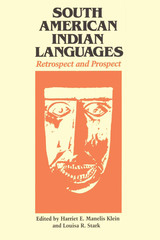 South American Indian Languages: Retrospect and Prospect
Edited by Harriet E. Manelis Klein and Louisa R. Stark
University of Texas Press, 1985 This book fills the crucial need for a single volume that gives broad coverage and synthesizes findings for both the general reader and the specialist. This collection of twenty-two essays from fifteen well-known scholars presents linguistic research on the indigenous languages of South America, surveying past research, providing data and analysis gathered from past and current research, and suggesting prospects for future investigation. Of interest not only to linguists but also to anthropologists, historians, and geographers, South American Indian Languages offers a wide perspective, both temporal and regional, on an area noted for its enormous linguistic diversity and for the lack of knowledge of its indigenous languages. An invaluable source book and reference tool, its appearance is especially timely when exploitation of the rich natural resources in a number of areas in South America must surely result in the demise and/or acculturation of some indigenous groups.
South American Progress
Clarence Henry Haring
Harvard University Press At the present time, when the South American republics have completed a century of experience as sovereign nations, an accounting should be made of the progress they have achieved and some intimation be given of their promise for the future. They have importance for us not only for their trade or for the dividends we may extract from them but also for the increasing significance of their artistic and intellectual life; and this importance will be much greater in the future than in the past. Professor Haring’s first-hand acquaintance with them will help the average American to understand and appreciate their background, their problems, and their point of view.
The South As It Is: 1865–1866
John Richard Dennett, with a new introduction by Caroline E. Janney
University of Alabama Press, 2010 This classic report originally appeared as a series of articles in the Nation between July 8, 1865, and April 11, 1866. Dennett traveled in seven states—Virginia, North Carolina, South Carolina, Georgia, Alabama, Louisiana, and Mississippi—at the very beginning of Reconstruction. His remarkably prophetic account of the recently defeated South is a major source for the history of this transition.
 South Asia on the Move: Mobilities, Mobilizations, Maneuvers
Benjamin Linder
Amsterdam University Press, 2025 This book sustains and expands the new mobilities paradigm by focusing such theoretical advances on South Asian scholarship. When it comes to analytical approaches to movement, the mobilities turn has been tremendously provocative, particularly in the last twenty years. However, much of that literature remains rooted in the priorities, ontologies, and geographies of the West/Global North. This volume extends earlier approaches by centering South Asia as a critical site through which scholars can advance new empirical research, develop fresh theoretical tools, diversify mobilities studies, and pose a challenge to predominant models. Through a diverse set of interdisciplinary chapters, South Asia on the Move makes a sustained argument about the value of decentering (im)mobilities research. In so doing, the collection redirects the regional, theoretical, and methodological foci of the mobilities turn, demonstrating the relevance of South Asia for thinking about varieties of movement within the region and around the world.
South Asia Unbound: New International Histories of the Subcontinent
Bérénice Guyot-Réchard
Leiden University Press, 2023 Whose international matters, and why? How are geographic regions constructed? What are the channels of engagement between a place, its people, its institutions, and the world? How do we understand the non-West’s influence in contemporary global interactions? From humanitarianism and activism to diplomacy and institutional networks, South Asia has been a crucial place for the elaboration of international politics, even before the twentieth century. South Asia Unbound gathers an interdisciplinary group of scholars from across the world to investigate South Asian global engagement at the local, regional, national, and supra-national levels, spanning the time before and after independence. Only by understanding its past entanglements with the world can we understand South Asia’s increasing global importance today.
 South Asian Civilizations: A Bibliographic Synthesis
Maureen L. P. Patterson
University of Chicago Press, 1981 indispensable Patterson, the preeminent bibliographer in the area of South Asian studies, has here devised an indispensible reference tool. She has drawn together over 28,000 periodical and monographic references to humanistic, social-science, and nontechnical-science works. These include works that date from the earliest times to the present day and works in South Asian as well as Western languages.
This information is organized in accord with indigenous South Asian concepts and categories within the threefold dimensions of time, space, and topic. These units and their interrelationships are first laid out in an outline of headings that constitutes, in the aggregate, a self-contained reference outline of Indic civilization. Each unit and its subdivisions are then presented as the headings for the bibliographic sections that form the main body of the book. This conceptual structure, in combination with the author and subject indexes, offers the reader several means of access to the entries themselves, making South Asian Civilizations a work that will be of great use to a wide audience.
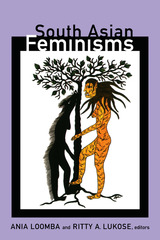 South Asian Feminisms
Ania Loomba and Ritty A. Lukose, eds.
Duke University Press, 2012 During the past forty years, South Asia has been the location and the focus of dynamic, important feminist scholarship and activism. In this collection of essays, prominent feminist scholars and activists build on that work to confront pressing new challenges for feminist theorizing and practice. Examining recent feminist interventions in India, Pakistan, Sri Lanka, and Bangladesh, they address feminist responses to religious fundamentalism and secularism; globalization, labor, and migration; militarization and state repression; public representations of sexuality; and the politics of sex work. Their essays attest to the diversity and specificity of South Asian locations and feminist concerns, while also demonstrating how feminist engagements in the region can enrich and advance feminist theorizing globally. Contributors. Flavia Agnes, Anjali Arondekar, Firdous Azim, Anannya Bhattacharjee, Laura Brueck, Angana P. Chatterji, Malathi de Alwis, Toorjo Ghose, Amina Jamal, Ratna Kapur, Lamia Karim, Ania Loomba, Ritty A. Lukose, Vasuki Nesiah, Sonali Perera, Atreyee Sen, Mrinalini Sinha, Ashwini Sukthankar
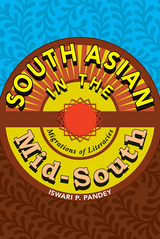 South Asian in the Mid-South: Migrations of Literacies
Iswari P. Pandey
University of Pittsburgh Press, 2015 Winner of the 2017 CCCC Advancement of Knowledge Award.
In an age of global anxiety and suspicion, South Asian immigrants juggle multiple cultural and literate traditions in Mid-South America. In this study Iswari P. Pandey looks deeply into this community to track the migration of literacies, showing how different meaning-making practices are adapted and reconfigured for cross-language relations and cross-cultural understanding at sites as varied as a Hindu school, a Hindu women’s reading group, Muslim men’s and women’s discussion groups formed soon after 9/11, and cross-cultural presentations by these immigrants to the host communities and law enforcement agencies. Through more than seventy interviews, he reveals the migratory nature of literacies and the community work required to make these practices meaningful.
Pandey addresses critical questions about language and cultural identity at a time of profound change. He examines how symbolic resources are invented and reinvented and circulated and recirculated within and across communities; the impact of English and new technologies on teaching, learning, and practicing ancestral languages; and how gender and religious identifications shape these practices. Overall, the book offers a thorough examination of the ways individuals use interpretive powers for agency within their own communities and for cross-cultural understanding in a globalizing world and what these practices mean for our understanding of that world.
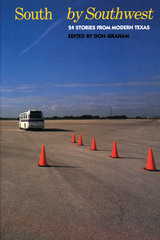 South by Southwest: 24 Stories from Modern Texas
Edited by Don Graham
University of Texas Press, 1986 These Texas stories are among the best produced by the state's writers in the mid-twentieth century. Selected above all for their artistic excellence and their narrative mastery, they also present a vital picture of the Southwest in microcosm, as revealed in its largest state. Texas and Texas writing moved from a Southern orientation in the 1940s—reflected here in works by William Goyen, William Humphrey, and others—to the strong Southwestern flavor of stories by such authors as Larry McMurtry and A. C. Greene to, finally, urban or Sunbelt Texas, mirrored in the edgy, sometimes experimental prose of Doug Crowell, William Harrison, and Peter LaSalle. Here are stories by such celebrated authors as Paul Horgan and William A. Owens, as well as startling, in some cases previously unpublished work by writers like Harryette Mullen, Naomi Shihab Nye, Pat Ellis Taylor, and Thomas Zigal. A few stories may already be favorites—Larry McMurtry's "There Will Be Peace in Korea," Amado Muro's "Cecilia Rosas." Many others have become classics, such as Vassar Miller's poignantly autobiographical "Pact," Hughes Rudd's hilarious record of grade school fieldtrips, R. E. Smith's gripping story of a Houstonian's life-changing encounter with nature, and Dave Hickey's astonishing account of an old cowboy's imprisonment . . . in a bathtub. Bill Brett, James Crumley, Linda West Eckhardt, Robert Flynn, Mary Gray Hughes, Carolyn Osborn—all are represented here by stories guaranteed to banish stereotypes and boredom and to enlarge one's vision of the Lone Star State. Anyone who thinks that oil wells and big hair define Texas will find out differently in the dazzling short fiction presented in South by Southwest.
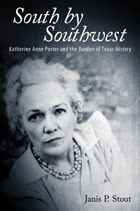 South by Southwest: Katherine Anne Porter and the Burden of Texas History
Janis P. Stout
University of Alabama Press, 2013 An interdisciplinary study of Katherine Anne Porter’s troubled relationship to her Texas origins and southern roots, South by Southwest offers a fresh look at this ever-relevant author. Today, more than thirty years after her death, Katherine Anne Porter remains a fascinating figure. Critics and biographers have portrayed her as a strikingly glamorous woman whose photographs appeared in society magazines. They have emphasized, of course, her writing— particularly the novel Ship of Fools, which was made into an award-winning film, and her collection Pale Horse, Pale Rider, which cemented her role as a significant and original literary modernist. They have highlighted her dramatic, sad, and fragmented personal life. Few, however, have addressed her uneasy relationship to her childhood in rural Texas. Janis P. Stout argues that throughout Porter’s life she remained preoccupied with the twin conundrums of how she felt about being a woman and how she felt about her Texas origins. Her construction of herself as a beautiful but unhappy southerner sprung from a plantation aristocracy of reduced fortunes meant she construed Texas as the Old South. The Texas Porter knew and re-created in her fiction had been settled by southerners like her grandparents, who brought slaves with them. As she wrote of this Texas, she also enhanced and mythologized it, exaggerating its beauty, fertility, and gracious ways as much as the disaffection that drove her to leave. Her feelings toward Texas ran to both extremes, and she was never able to reconcile them. Stout examines the author and her works within the historical and cultural context from which she emerged. In particular, Stout emphasizes four main themes in the history of Texas that she believes are of the greatest importance in understanding Porter: its geography and border location (expressed in Porter’s lifelong fascination with marginality, indeterminacy, and escape); its violence (the brutality of her first marriage as well as the lawlessness that pervaded her hometown); its racism (lynchings were prevalent throughout her upbringing); and its marginalization of women (Stout draws a connection between Porter’s references to the burning sun and oppressive heat of Texas and her life with her first husband).
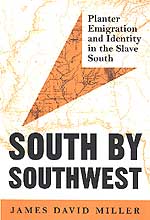 South by Southwest: Planter Emigration and Identity in the Slave South
James David Miller
University of Virginia Press, 2002 Between 1815 and 1861 thousands of planters formed a unique emigrant group in American history. A slaveholding, landholding elite, southerners from Georgia and South Carolina uprooted themselves from their communities and headed for their society's borderlands with a frequency and intensity unsurpassed by any comparable class. A phenomenon of such singularity and significance preoccupied many of the South's leading citizens and generated a great deal of interest and discussion among movers and prospective movers, as well as among those who stayed behind. While many wondered what emigration could do for them as individuals or households, others engaged in a public debate as to what emigration said about them as a class and as a society. That multilayered debate surrounding the personal and social, spiritual and ideological meanings of emigration is at the very center of James David Miller's study.
In exploring what planter mobility reveals about planter identity and culture, South by Southwest blends analysis of both public and private responses to emigration and in so doing illuminates the ways in which elite southerners themselves understood the connections between emigration as private conduct and as a public phenomenon. In bringing together these two spheres of inquiry, Miller examines the diverse geographical, cultural, and intellectual meanings that elite southerners gave to their private and public journeys and what those meanings reveal about their broader attitudes regarding the people and places of slaveholding society.
Reviews
"This is a terrific study. South by Southwest adds an entirely new dimension to our understanding of the formation of the slaveholding class."
--Christopher Morris, author of Becoming Southern:
The Evolution of a Way of Life
"Energetic research in dozens of private manuscript collections forms the principal basis of Miller's clear-headed analysis of why and how planters moved to the Southwest, what they found when they arrived, and what differences it made to them personally and collectively. South by Southwest is written with unusual grace, clarity, and flair."
--Michael P. Johnson, coauthor of Black Masters: A Free
Family of Color in the Old South
The Author
James David Miller is Assistant Professor of History at Carleton University.
South Carolina Ballads: With a Study of the Traditional Ballad Today
Reed Smith
Harvard University Press Based upon many years of browsing in the fascinating field of traditional balladry, this little book starts with the popular ballad as we have it exhibited in Child's great collection and works forward in time to modern instances and contemporary analogies, with all possible stress on music as an essential part of ballads. The general discussion is followed by a small sheaf of surviving South Carolina ballads, fourteen in all, with thirty-seven variants and eleven tunes. It will be found a charming addition to our many collections of folk-songs.
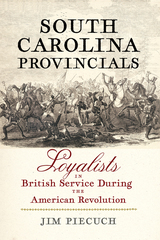 South Carolina Provincials: Loyalists in British Service During the American Revolution
Jim Piecuch
Westholme Publishing, 2023 The Loyalists who supported the British during the American Revolution have frequently been neglected in accounts of that conflict. Nevertheless, Loyalists made significant efforts to assist British forces in restoring royal control of the thirteen colonies. This was especially true in South Carolina, where backcountry Loyalists under almost-forgotten leaders such as Joseph Robinson and Euan McLaurin challenged the Revolutionary movement in 1775. Although their initial efforts were unsuccessful, Robinson, McLaurin, and hundreds of their followers eventually made their way to British East Florida, where they organized into a provincial regiment called the South Carolina Royalists. Operating in concert with British efforts, the Royalists were part of many notable actions from 1778 to 1781, including the defenses of East Florida and Savannah, Georgia, and the battles of Briar Creek, Stono Ferry, Musgrove’s Mill, and Hobkirk’s Hill. A second provincial regiment created in 1780, Major John Harrison’s South Carolina Rangers, saw considerably action in operations against partisans under Francis Marion. When the British were forced to evacuate their backcountry posts in 1781, the Royalists, Rangers, and three troops of Provincial Light Dragoons raised earlier in the year withdrew first to Charleston and then East Florida. From there, many went to Canada at the war’s end, with others dispersing to different British colonies to begin new lives after their strenuous but unsuccessful effort on behalf of king and country.
In South Carolina Provincials: Loyalists in British Service During the American Revolution, historian Jim Piecuch provide the first comprehensive history of those South Carolinians who took up arms to assist the British during their attempt to quell the rebellion in the South. Based on primary source research including records rarely consulted, the result provides a much clearer picture of the American Revolution at the local level in Georgia, Florida, and the Carolinas.
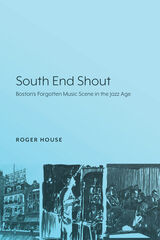 South End Shout: Boston’s Forgotten Music Scene in the Jazz Age
Roger House
Lever Press, 2023 South End Shout: Boston’s Forgotten Music Scene in the Jazz Age details the power of music in the city’s African American community, spotlighting the era of ragtime culture in the early 1900s to the rise of big band orchestras in the 1930s. This story is deeply embedded in the larger social condition of Black Bostonians and the account is brought to life by the addition of 20 illustrations of musicians, theaters, dance halls, phonographs, and radios used to enjoy the music. South End Shout is part of an emerging field of studies that examines jazz culture outside of the major centers of music production. In extensive detail, author Roger R. House covers the activities of jazz musicians, jazz bands, the places they played, the relationships between Black and white musicians, the segregated local branches of the American Federation of Musicians (AFL-CIO), and the economics of Boston’s music industry. Readers will be captivated by the inclusion of vintage local newspaper reports, classified advertisements, and details of hard-to-access oral history accounts by musicians and residents. These precious documentary materials help to understand how jazz culture evolved as a Boston art form and contributed to the national art form between the world wars. With this book, House makes an important contribution to American studies and jazz history. Scholars and general readers alike who are interested in jazz and jazz culture, the history of Boston and its Black culture, and 20th century American and urban studies will be enlightened and delighted by this book.
The South in Modern America: A Region at Odds
Dewey W. Grantham
University of Arkansas Press, 2001 The South in Modern America is a lively and illuminating account of the Southern experience since the end of Reconstruction. In the twentieth century, as in the nineteenth, the South has been the region most sharply at odds with the rest of the nation. No other part of the country has as clear-cut a sectional image. The interplay between the South, the North, and the rest of the nation represents a rich and instructive part of the United States history, illustrating much of the nation's conflict and tension, the way it has tried to reconcile divergent issues, and its struggles to realize its historical ideals. In this new treatment of modern Southern history, Dewey W. Grantham illuminates the features that make the South a distinctive region while clarifying how it has converged socially and politically with the rest of the country during this century.
South Jersey Towns: History and Legends
McMahon, William
Rutgers University Press, 1973 No region in the nation has a richer heritage than the right counties of South Jersey--Cape May, Salem, Cumberland, Atlantic, Gloucester, Camden, Burlington, and Ocean. In this book William McMahon has collected an assortment of little-known information and historical anecdotes about the people and places of this area.
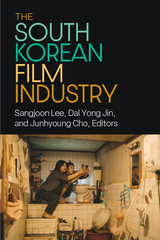 The South Korean Film Industry
Sangjoon Lee, Dal Yong Jin, And Junhyoung Cho, Editors
University of Michigan Press, 2024 As shown by the success of Squid Game and Parasite, South Korea’s film industry is producing films and original series for streaming services, film studios, and television stations worldwide. South Korea is now arguably considered one of the few countries outside the United States to have captivated the world’s hearts and minds through pop music, TV dramas, and film. Similarly, the exponential growth in the South Korean film industry has been mirrored by a growing body of industry and film policy forums and academic conferences in both the East and the West.
The South Korean Film Industry is the first detailed scholarly overview of the South Korean film industry. The thirteen chapters discuss topics from short films to popular television series that have engaged global audiences. Contributors explore the major changes in South Korean film making, marketing, and in the international growth and popularity of South Korean films. By bringing together a wide range of academic specialists, The South Korean Film Industry situates the current scholarship on South Korean cinema within the ongoing theoretical debates in contemporary global film studies. This volume will be widely read in undergraduate and graduate classes related to Korean and East Asian studies, cinema and media studies, cultural studies, and communication studies. Moreover, many institutions offer dedicated modules on South Korean cinema, media, and popular culture, for which The South Korean Film Industry will be ideal.
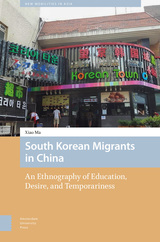 South Korean Migrants in China: An Ethnography of Education, Desire, and Temporariness
Xiao Ma
Amsterdam University Press, 2024 This book is an ethnographic account of education and migration from the perspective of three groups of South Koreans in contemporary China: migrant parents, children/students, and educational agents. The book reveals how these temporary migrants make choices, plan their trajectories and engage with the authorities, both in China and South Korea. Migrant subjectivities among these groups are driven by and respond to the education-migration regimes of both the sending and receiving countries. As ‘people in between’, they occupy flexible and multiple positionalities that are transnationally distributed. However, paradoxically, they experience a juxtaposition of privilege, integration and separation, which is indicative of the Chinese style of internationalisation. The book adds weight to the argument that China is a temporary destination for foreigners and not one for long-term settlement.
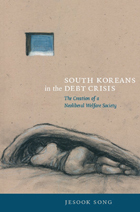 South Koreans in the Debt Crisis: The Creation of a Neoliberal Welfare Society
Jesook Song
Duke University Press, 2009 South Koreans in the Debt Crisis is a detailed examination of the logic underlying the neoliberal welfare state that South Korea created in response to the devastating Asian Debt Crisis (1997–2001). Jesook Song argues that while the government proclaimed that it would guarantee all South Koreans a minimum standard of living, it prioritized assisting those citizens perceived as embodying the neoliberal ideals of employability, flexibility, and self-sufficiency. Song demonstrates that the government was not alone in drawing distinctions between the “deserving” and the “undeserving” poor. Progressive intellectuals, activists, and organizations also participated in the neoliberal reform project. Song traces the circulation of neoliberal concepts throughout South Korean society, among government officials, the media, intellectuals, NGO members, and educated underemployed people working in public works programs. She analyzes the embrace of partnerships between NGOs and the government, the frequent invocation of a pervasive decline in family values, the resurrection of conservative gender norms and practices, and the promotion of entrepreneurship as the key to survival. Drawing on her experience during the crisis as an employee in a public works program in Seoul, Song provides an ethnographic assessment of the efforts of the state and civilians to regulate social insecurity, instability, and inequality through assistance programs. She focuses specifically on efforts to help two populations deemed worthy of state subsidies: the “IMF homeless,” people temporarily homeless but considered employable, and the “new intellectuals,” young adults who had become professionally redundant during the crisis but had the high-tech skills necessary to lead a transformed post-crisis South Korea.
South of Luck
Jim Guhl
University of Wisconsin Press, 2021 It’s the summer of 1945, and sixteen-year-old ruffian Milo Egerson has been shipped from his Minneapolis home to his great-uncle Ham’s farm in rural northwestern Wisconsin. Though his mother puts on a smile and says it’ll do him good to be out in nature, they both know otherwise. Milo’s stepfather, the one who gave him that jagged scar, is set to be released from Stillwater Prison soon and has already promised to finish what he started.
Hoping there are enough miles between the Twin Cities and dusty Milltown, Milo sets about trying to make the most of life without running water and electricity while trying to better understand his own place in the world and what it all means. His tough-guy act softens as he blends into the community and befriends an endearing group of small-town folks. And that’s lucky for him, because to stay safe, he’s going to need all the help he can get.
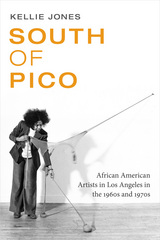 South of Pico: African American Artists in Los Angeles in the 1960s and 1970s
Kellie Jones
Duke University Press, 2017 Named a Best Art Book of 2017 by the New York Times and Artforum
In South of Pico Kellie Jones explores how the artists in Los Angeles's black communities during the 1960s and 1970s created a vibrant, productive, and engaged activist arts scene in the face of structural racism. Emphasizing the importance of African American migration, as well as L.A.'s housing and employment politics, Jones shows how the work of black Angeleno artists such as Betye Saar, Charles White, Noah Purifoy, and Senga Nengudi spoke to the dislocation of migration, L.A.'s urban renewal, and restrictions on black mobility. Jones characterizes their works as modern migration narratives that look to the past to consider real and imagined futures. She also attends to these artists' relationships with gallery and museum culture and the establishment of black-owned arts spaces. With South of Pico, Jones expands the understanding of the histories of black arts and creativity in Los Angeles and beyond.
 South Pole Station
Ashley Shelby
University of Minnesota Press, 2024 A New York TimesBook Review Editors’ Choice A Shelf Awareness Best Book of the Year Hudson Booksellers Book of the Year One of the New York Post’s Best Books of the Summer One of The Millions’s Most Anticipated Books of the Year IndieNext Pick A Time Magazine “What to Read Now” Selection
A wry novel set at the edge of the earth about the courage it takes to band together, even as everything around you falls apart
Unmoored by a recent family tragedy, Cooper Gosling is adrift at thirty and on the verge of ruining her career. So when the opportunity arises to join the National Science Foundation’s Artists & Writers Program in Antarctica, she jumps at the chance—and finds herself in the company of others who are just abnormal enough for Polar life, a group of eccentrics motivated by desires as ambiguous as her own. When they are joined by a fringe scientist who claims climate change is a hoax, the Polies’ already-imbalanced community is rattled, bringing them to the center of a global controversy and threatening the ancient ice chip they call home.
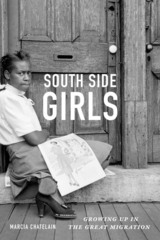 South Side Girls: Growing Up in the Great Migration
Marcia Chatelain
Duke University Press, 2015 In South Side Girls Marcia Chatelain recasts Chicago's Great Migration through the lens of black girls. Focusing on the years between 1910 and 1940, when Chicago's black population quintupled, Chatelain describes how Chicago's black social scientists, urban reformers, journalists and activists formulated a vulnerable image of urban black girlhood that needed protecting. She argues that the construction and meaning of black girlhood shifted in response to major economic, social, and cultural changes and crises, and that it reflected parents' and community leaders' anxieties about urbanization and its meaning for racial progress. Girls shouldered much of the burden of black aspiration, as adults often scrutinized their choices and behavior, and their well-being symbolized the community's moral health. Yet these adults were not alone in thinking about the Great Migration, as girls expressed their views as well. Referencing girls' letters and interviews, Chatelain uses their powerful stories of hope, anticipation and disappointment to highlight their feelings and thoughts, and in so doing, she helps restore the experiences of an understudied population to the Great Migration's complex narrative.
 South Side Impresarios: How Race Women Transformed Chicago's Classical Music Scene
Samantha Ege
University of Illinois Press, 2024 Between the world wars, Chicago Race women nurtured a local yet widely resonant Black classical music community entwined with Black civic life. Samantha Ege tells the stories of the Black women whose acumen and energy transformed Chicago’s South Side into a wellspring of music making. Ege focuses on composers like Florence Price, Nora Holt, and Margaret Bonds not as anomalies but as artists within an expansive cultural flowering. Overcoming racism and sexism, Black women practitioners instilled others with the skill and passion to make classical music while Race women like Maude Roberts George, Estella Bonds, Neota McCurdy Dyett, and Beulah Mitchell Hill built and fostered institutions central to the community. Ege takes readers inside the backgrounds, social lives, and female-led networks of the participants while shining a light on the scene’s audiences, supporters, and training grounds. What emerges is a history of Black women and classical music in Chicago and the still-vital influence of the world they created. A riveting counter to a history of silence, South Side Impresarios gives voice to an overlooked facet of the Black Chicago Renaissance.
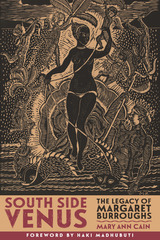 South Side Venus: The Legacy of Margaret Burroughs
Mary Ann Cain; Foreword by Haki Madhubuti
Northwestern University Press, 2018 The extraordinarily productive life of curator, artist, and activist Margaret Burroughs was largely rooted in her work to establish and sustain two significant institutions in Chicago: the South Side Community Art Center (SSCAC), founded in 1940, and the DuSable Museum of African American History, founded in her living room in 1961.
As Mary Ann Cain's South Side Venus: The Legacy of Margaret Burroughs reveals, the primary motivations for these efforts were love and hope. Burroughs was spurred by her love for Chicago's African American community—largely ill served by mainstream arts organizations—and by her hope that these new, black-run cultural centers would welcome many generations of aspiring artists and art lovers.
This first, long–awaited biography of Burroughs draws on interviews with peers, colleagues, friends, and family, and extensive archival research at the DuSable Museum, the Art Institute of Chicago, and the Chicago Public Library. Cain traces Burroughs's multifaceted career, details her work and residency on Chicago's South Side, and highlights her relationships with other artists and culture makers. Here, we see Burroughs as teacher and mentor as well as institution builder.
Anchored by the author's talks with Burroughs as they stroll through her beloved Bronzeville, and featuring portraits of Burroughs with family and friends, South Side Venus will enlighten anyone interested in Chicago, African American history, social justice, and the arts.
South Slavs in Michigan
Daniel Cetinich
Michigan State University Press, 2003 The South Slavs of Michigan—Slovenes, Croats, Serbs, Macedonians, and Bosnian Muslims—are a microcosm of the immigration waves of southern and eastern Europeans who came to the United States between 1880 and 1924. History has almost forgotten these immigrants, who were instrumental in developing the large urban centers of Michigan and the United States, and who specifically contributed to development of the auto industry and struck in 1913–1914 for better working conditions in the copper mines of the Upper Peninsula. While labor problems were the primary obstacles confronting Michigan’s South Slavs, the painful process of acculturation has since dimmed their very real accomplishments. As Daniel Cetinich shows, South Slavs helped shape both a regional and national civilization in North America with their hands, backs, feet, and the labor organizations they helped create.
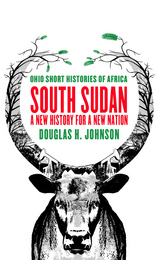 South Sudan: A New History for a New Nation
Douglas H. Johnson
Ohio University Press, 2016 Africa’s newest nation has a long history. Often considered remote and isolated from the rest of Africa, and usually associated with the violence of slavery and civil war, South Sudan has been an arena for a complex mixing of peoples, languages, and beliefs. The nation’s diversity is both its strength and a challenge as its people attempt to overcome the legacy of decades of war to build a new economic, political, and national future. Most recent studies of South Sudan’s history have a foreshortened sense of the past, focusing on current political issues, the recently ended civil war, or the ongoing conflicts within the country and along its border with Sudan. This brief but substantial overview of South Sudan’s longue durée, by one of the world’s foremost experts on the region, answers the need for a current, accessible book on this important country. Drawing on recent advances in the archaeology of the Nile Valley, new fieldwork as well as classic ethnography, and local and foreign archives, Johnson recovers South Sudan’s place in African history and challenges the stereotypes imposed on its peoples.
South Vietnam Trial and Experience: A Challenge for Development
Ang Tuan Nguyen
Ohio University Press, 1987
Dr. Nguyen Anh Tuan, former Minister of Finance of the Republic of South Vietnam, addresses a common perception of Vietnam: that South Vietnam was a fragmented society which did not deserve to succeed because of its internal weaknesses. According to Tuan, however, South Vietnam in the last decade of its life developed considerable governmental cohesion and internal social strength. Before the final failure of will, the South and its defenders were well on the way to becoming a viable society that had managed with American assistance to lift itself by its bootstraps to the point to economic take-off. Tuan argues that South Vietnam’s fall was not inevitable. This controversial book will be of great interest to all those concerned with the Vietnamese experience during the period 1954-1975.
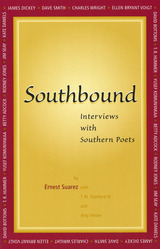 Southbound: Interviews with Southern Poets
Edited by Ernest Suarez, T. W. Stanford III, & Amy Verner
University of Missouri Press, 1999
"There's a real flowering, I think, of southern poetry right now, . . . assembling at the edges of everything." This observation by Pulitzer Prize-winning poet Charles Wright reflects upon the continuing vibrancy and importance of the southern poetic tradition. Although the death of James Dickey in 1997 left southern poetry without a recognizably dominant voice, an array of other vibrant voices continue to be heard and recognized. Southbound: Interviews with Southern Poets provides detailed discussion of the art and craft of poetry by many writers who promise to keep southern poetry vital into the twenty-first century.
Beginning with an interview with the late literary giant James Dickey, Southbound collects the ideas and insights of both well-known and rising southern poets, including Dave Smith, Charles Wright, Ellen Bryant Voigt, Yusef Komunyakaa, and Rodney Jones. Suarez's guiding principle for conducting and revising the interviews was to let the poets express themselves as clearly and fully as possible. Each interview is ultimately defined by the poet's own personality and voice, yet all explore similar themes—the relationship between technique and subject, the nature of the southern canon and each poet's place in it, and the state of contemporary poetry. As Dave Smith relates, "My sense of appreciation of what life means or could mean, whatever I know about life, stems from a sense of place, a sense of the ghostliness of meaning." It is this sense of place and meaning that Suarez allows each poet to convey truthfully in his interviews.
Including a brief introduction to each interview and a bibliography of primary and secondary sources for each poet, Southbound is a useful tool for scholars and a springboard for casual readers. More important, this collection of interviews makes a significant contribution to the tradition of southern poetry and its most prominent voices.
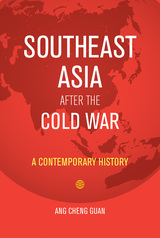 Southeast Asia After the Cold War: A Contemporary History
Ang Cheng Guan
National University of Singapore Press, 2019 International relations in Southeast Asia after 1990 can be understood in terms of a United States dominated security order, and the regional structure created by the Association of Southeast Asian Nations (ASEAN). But as the Cold War recedes further into the past, that order is increasingly under siege, with a new global strategic rebalancing underway. The region is forced to contemplate new risks and the emergence of new rivalries and conflicts.
With Southeast Asia After the Cold War, Ang Cheng Guan offers a complete, analytically informed contemporary history that covers the whole region, tracing developments since 1990 and highlighting change, continuity, and the larger context in which decisions have been made. Crucial as a tool for making sense of the dynamics of the region, this account of Southeast Asia’s international relations will also be of immediate relevance to those in the United States and elsewhere who engage with the region, with its young, dynamic population, and its strategic position at between the Indian Ocean and the Pacific.
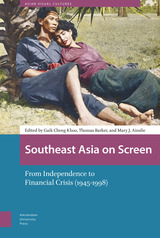 Southeast Asia on Screen: From Independence to Financial Crisis (1945-1998)
Gaik Cheng Khoo
Amsterdam University Press, 2020 After the end of World War II when many Southeast Asian nations gained national independence, and up until the Asian Financial Crisis, film industries here had distinctive and colourful histories shaped by unique national and domestic conditions. Southeast Asia on Screen: From Independence to Financial Crisis (1945-1998) addresses the similar themes, histories, trends, technologies and sociopolitical events that have moulded the art and industry of film in this region, identifying the unique characteristics that continue to shape cinema, spectatorship and Southeast Asian filmmaking in the present and the future. Bringing together scholars across the region, chapters explore the conditions that have given rise to today’s burgeoning Southeast Asian cinemas as well as the gaps that manifest as temporal belatedness and historical disjunctures in the more established regional industries.
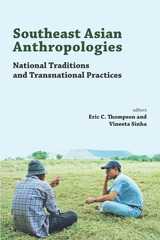 Southeast Asian Anthropologies: National Traditions and Transnational Practices
Edited by Eric C. Thompson and Vineeta Sinha
National University of Singapore Press, 2019 Anthropology is a flourishing discipline in Southeast Asia. Anthropologists in the region spent the second half of the twentieth century establishing the field, and now, as we move further into the twenty-first century, a new generation is working to shift the discipline from European and American narratives to a Southeast Asian locus. There has been a vigorous debate and a wide range of suggestions on what might be done to break from the Euro-, andro-, hetero-, and other centrisms of the discipline and move to an emerging world anthropologies perspective. But actually transforming anthropology requires going beyond mere critique.
Southeast Asian Anthropologies outlines the practices and paradigms of anthropologists working from and within Southeast Asia. It addresses three overlapping issues: the historical development of unique traditions of research, scholarship, and social engagement across diverse anthropological communities of the region; the opportunities and challenges faced by Southeast Asian anthropologists as they practice their craft in different institutional and political contexts; and the emergence of locally grounded, intraregional, transnational linkages and practices undertaken by Southeast Asian-based anthropologists. It is a much-needed assessment of the state of the discipline that will be an invaluable tool for anthropologists navigating a new era of development and challenges.
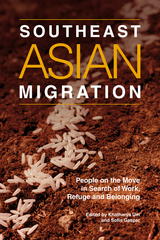 Southeast Asian Migration: People on the Move in Search of Work, Refuge, and Belonging
Khatharya Um
Sussex Academic Press, 2022 Southeast Asia has long been a crossroad of cultural influence and transnational movement, but the massive migration of Southeast Asians throughout the world in recent decades is historically unprecedented. Dispersal, compelled by economic circumstance, political turmoil, and war, engenders personal, familial, and spiritual dislocation, and provokes a questioning of identity and belonging. This volume features original works by scholars from Asia, America, and Europe that highlight these trends and perspectives on Southeast Asian migration within and beyond the Asia-Pacific region. Adopting an interdisciplinary approach -- with contributions from sociology, political science, anthropology, and history -- and anchored in empirical case studies from various Southeast Asian countries, it extends the scope of inquiry beyond the economic concerns of migration, and beyond a single country source or destination, and disciplinary focus. Analytic focus is placed on the forces and factors that shape migration trajectories and migrant incorporation experiences in Asia and Europe; the impact of migration and immigration status on individuals, families, and institutions, on questions of equity, inclusion, and identity; and the triangulated relationships between diasporic communities, the sending and receiving countries. Of particular importance is the scholarly attention to lesser known populations and issues such as Vietnamese in Poland, children and the 1.5 generation immigrants, health and mental consequences of state sponsored violence and protracted encampment, ethnic media, and the challenges of both transnational parenting and family reunification. In examining the complex and creative negotiations that immigrants engage locally and transnationally in their daily lives, it foregrounds immigrant resilience in the strategies they adopt not only to survive but thrive in displacement.
 Southeast Asian/American Studies, Volume 20
Mimi Thi Nguyen
Duke University Press This special issue claims Southeast Asian/American studies as a unique site for scholarly engagements with US empire and its professions of liberal humanism as well as its practices of neoliberal violence. Dissolving the disciplinary distinctions between Southeast Asia area studies and Asian American studies, the authors construct transnational analytic methods to examine new assemblages of nations and states, refugees and residents, migrations and returns. The contributors represent a new generation of scholars, some of whom are themselves migrants and refugees, who seek to reinvent the study of displaced populations and their diasporas. One essay considers the historical production of the refugee soldier during the “secret wars” of Laos. An ethnography of Southeast Asian American youth protests post-9/11 reveals how neoliberal rationalization of “personal responsibility” created a context for both deportation and the youth movement against it. Several contributions explore concepts of exile, belonging, and the nation-state via media representations of masculinity and the erotic, including the Hmong actors who appear in Clint Eastwood’s film Gran Torino, campy pan-Asian boy bands, and Vietnam Idol, a reality show that, like its British and American counterparts, illustrates specific cultural imagination and national ambitions. Fiona I. B. Ngô and Mimi Thi Nguyen are both assistant professors of gender and women’s studies and Asian American studies at the University of Illinois, Urbana-Champaign. Nguyen is the author of The Gift of Freedom: War, Debt, and Other Refugee Passages and a co-editor of Alien Encounters: Popular Culture in Asian America, both also published by Duke University Press. Contributors: Diem-My T. Bui, Long Bui, Thang Dao, Ly Chong Thong Jalao, Soo Ah Kwon, Mariam B. Lam, Viet Le, Fiona I.B. Ngô, Mimi Thi Nguyen, Viet Thanh Nguyen,
Louisa Schein, Cathy J. Schlund-Vials, Va-Megn Thoj, Khatharya Um, Julie Thi Underhill, Bee Vang, Ma Vang
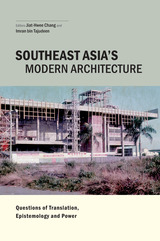 Southeast Asia's Modern Architecture: Questions of Translation, Epistemology and Power
Edited by Jiat-Hwee Chang and Imran bin Tajudeen
National University of Singapore Press, 2018 What is the modern in Southeast Asia’s architecture and how do we approach its study critically? This pathbreaking multidisciplinary volume is the first critical survey of Southeast Asia’s modern architecture. It looks at the challenges of studying this complex history through the conceptual frameworks of translation, epistemology, and power. Challenging Eurocentric ideas and architectural nomenclature, the authors examine the development of modern architecture in Indonesia, Malaysia, Myanmar, the Philippines, Singapore, Thailand, and Vietnam, with a focus on selective translation and strategic appropriation of imported ideas and practices by local architects and builders. The book transforms our understandings of the region’s modern architecture by moving beyond a consideration of architecture as an aesthetic artifact and instead examining its entanglement with different dynamics of power.
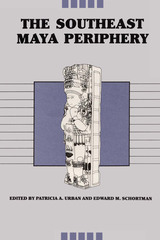 The Southeast Maya Periphery
Edited by Patricia A. Urban and Edward M. Schortman
University of Texas Press, 1986 Archaeologists are continually faced with a pervasive problem: How can cultures, and the interactions among cultures, be differentiated in the archaeological record? This issue is especially difficult in peripheral areas, such as El Salvador, Honduras, and southern Guatemala in the New World. Encompassing zones that are clearly Mayan in language and culture, especially during the Classic period, this area also includes zones that seem to be non-Mayan. The Southeast Maya Periphery examines both aspects of this territory. For the Maya, emphasis is on two sites: Quirigua, Guatemala, and Copan, Honduras. For the non-Maya zone, information is presented on a variety of sites and subregions—the Lower Motagua Valley in Guatemala; the Naco, Sula, and Comayagua valleys and the site of Playa de los Muertos in Honduras; and the Zapotitan Valley and the sites of Cihuatan and Santa Leticia in El Salvador. Spanning over two thousand years of prehistory, from the Middle Preclassic through the Classic and the poorly understood Postclassic, the essays in this volume address such topics as epigraphy and iconography, architecture, site planning, settlement patterns, and ceramics and include basic information on chronology. Copan and Quirigua are treated both individually and in comparative perspective. This significant study was the first to attempt to deal with the Periphery as a coherent unit. Unique in its comparative presentation of Copan and Quirigua and in the breadth of information on non-Maya sites in the area, The Southeast Maya Periphery consists largely of previously unpublished data. Offering a variety of approaches to both old and new problems, this volume attempts, among other things, to reassess the relationships between Copan and Quirigua and between Highland and Lowland ceramic traditions, to analyze ceramics by neutron activation, and to define the nature of the apparently non-Mayan cultures in the region. This book will be of major interest not only to Mayanists and Mesoamerican archaeologists but also to others interested in the processes of ethnic group boundary formation and maintenance.
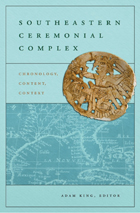 Southeastern Ceremonial Complex: Chronology, Content, Contest
Edited by Adam King
University of Alabama Press, 2007 A timely, comprehensive reevaluation of the Southeastern Ceremonial Complex.
One of the most venerable concepts in Southeastern archaeology is that of the Southern Cult. The idea has its roots in the intensely productive decade (archaeologically) of the 1930s and is fundamentally tied to yet another venerable concept—Mississippian culture. The last comprehensive study of the melding of these two concepts into the term Southeastern Ceremonial Complex (SECC) is more than two decades old, yet our understanding of the objects, themes, and artistic styles associated with the SECC have changed a great deal. New primary data have come to light that bear directly on the complex, requiring a thorough reanalysis of both concepts and dating. Recent publications have ignited many debates about the dating and the nature of the SECC. This work presents new data and new ideas on the temporal and social contexts, artistic styles, and symbolic themes included in the complex. It also demonstrates that engraved shell gorgets, along with other SECC materials, were
produced before A.D. 1400.
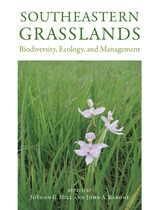 Southeastern Grasslands: Biodiversity, Ecology, and Management
JoVonn G. Hill and John A. Barone, eds.
University of Alabama Press, 2019 A holistic approach to analyzing distinct grassland habitats that integrates ecological, historical, and archaeological data
Today the southeastern United States is a largely rural, forested, and agricultural landscape interspersed with urban areas of development. However, two centuries ago it contained hundreds of thousands of acres of natural grasslands that stretched from Florida to Texas. Now more than 99 percent of these prairies, glades, and savannas have been plowed up or paved over, lost to agriculture, urban growth, and cattle ranching. The few remaining grassland sites are complex ecosystems, home to hundreds of distinct plant and animal species, and worthy of study.
Southeastern Grasslands: Biodiversity, Ecology, and Management brings together the latest research on southeastern prairie systems and species, provides a complete picture of an increasingly rare biome, and offers solutions to many conservation biology queries. Editors JoVonn G. Hill and John A. Barone have gathered renowned experts in their fields from across the region who address questions related to the diversity, ecology, and management of southeastern grasslands, along with discussions of how to restore sites that have been damaged by human activity.
Over the last twenty years, both researchers and the public have become more interested in the grasslands of the Southeast. This volume builds on the growing knowledge base of these remarkable ecosystems with the goal of increasing appreciation for them and stimulating further study of their biota and ecology. Topics such as the historical distribution of grasslands in the South, the plants and animals that inhabit them, as well as assessments of several techniques used in their conservation and management are covered in-depth. Written with a broad audience in mind, this book will serve as a valuable introduction and reference for nature enthusiasts, scientists, and land managers.
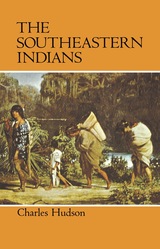 The Southeastern Indians
Charles Hudson
University of Tennessee Press, 1978 Drawing upon oral traditions, historical documents, and accounts by observers and scholars made over a four-hundred-year period, the author recaptures the culture, society, and history of the varied Indian peoples of the southeast. “Hudson. . .has brought everything together in such a manner that the Indian tribes of this region finally will be accorded the recognition that their achievements deserve.”–Choice
The Indians of the Southeastern United States enjoyed the richest and most advanced level of culture of any native people north of Mexico. Hardly any of their achievements are remembered today, however, and more than any of the aboriginal Americans, the Southeastern Indians have been ignored by both the historian and the general public. The Southeastern Indians brilliantly recaptures the culture, society, prehistory, and history of these native American people. Drawing upon oral traditions, historical documents, and accounts by observers and scholars made over a four-hundred-year period, Charles Hudson boldly and vividly brings to life the world of these Indians by presenting their culture in all its aspects. Here is social and cultural history at its best—a masterful book with unprecedented authenticity and fullness.
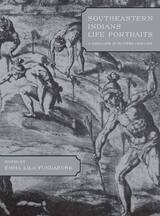 Southeastern Indians Life Portraits: A Catalogue of Pictures 1564-1860
Emma Lila Fundaburk
University of Alabama Press, 1958 This pictorial classic is a valuable ethnological record of southeastern Indians that also showcases the work of early photographers and artists.
A collection of over 350 photographs, paintings, drawings,and woodcuts, Life Portraits offers us an important visual representation of southeastern Indians—at work, at play, in rituals, and in death—when they first encountered Europeans.
Studied by historians and archaeologists, as well as museum exhibit designers and costumers, these illustrations provide a wealth of information on native dress and jewelry, house construction, agricultural techniques, warfare, and other aspects of American Indian life. Among the tribes illustrated are Natchez, Choctaw, Creek, Chickasaw, Cherokee, Seminole, Chitimacha, Timucua, Powhatan, Tuscarora, Caddo, Yuchi, and Shawnee.
A special section of the book quotes historic narratives and comments on the life and work of the artists, lithographers, photographers, and engravers who made the originals. Included among these are Jacques le Moyne, John White, Theodore De Bry, Francis Parsons, Joshua Reynolds, John Trumball, George Catlin, John Mix Stanley, Thomas McKenney, and Samuel Waugh.
Life Portraits has been a classic title in southeastern archaeology and a staple of bookstores and museum shops around the country since its original publication in 1958. Because the carefully identified illustrations were secured from a wide variety of sources, including the British Museum, the Charleston Museum, the New York Public Library, and the Oklahoma Historical Society, this volume represents the most comprehensiveand widely available record of Indian images. Designed for Americana collections, it will appeal to general readers as well as professional historians and archaeologists.
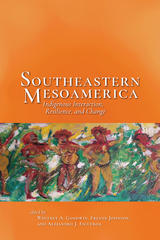 Southeastern Mesoamerica: Indigenous Interaction, Resilience, and Change
Whitney A. Goodwin
University Press of Colorado, 2020 Southeastern Mesoamerica highlights the diversity and dynamism of the Indigenous groups that inhabited and continue to inhabit the borders of Southeastern Mesoamerica, an area that includes parts of present-day Honduras, Guatemala, and El Salvador. Chapters combine archaeological, ethnohistoric, and historic data and approaches to better understand the long-term sociopolitical and cultural changes that occurred throughout the entirety of human occupation of this area.
Drawing on archaeological evidence ranging back to the late Pleistocene as well as extensive documentation from the historic period, contributors show how Southeastern Mesoamericans created unique identities, strategically incorporating cosmopolitan influences from cultures to the north and south with their own long-lived traditions. These populations developed autochthonous forms of monumental architecture and routes and methods of exchange and had distinct social, cultural, political, and economic traits. They also established unique long-term human-environment relations that were the result of internal creativity and inspiration influenced by local social and natural trajectories.
Southeastern Mesoamerica calls upon archaeologists, anthropologists, historians, ethnohistorians, and others working in Mesoamerica, Central America, and other cultural boundaries around the world to reexamine the role Indigenous resilience and agency play in these areas and in the cultural developments and interactions that occur within them.
Contributors: Edy Barrios, Christopher Begley, Walter Burgos, Mauricio Díaz García, William R. Fowler, Rosemary A. Joyce, Gloria Lara-Pinto, Eva L. Martínez, William J. McFarlane, Cameron L. McNeil, Lorena D. Mihok, Pastor Rodolfo Gómez Zúñiga, Timothy Scheffler, Edward Schortman, Russell Sheptak, Miranda Suri, Patricia Urban, Antolín Velásquez, E. Christian Wells
 The Southern Agrarians: With a new preface by the author
Paul K. Conkin
Vanderbilt University Press, 2001 The southern Agrarians were a group of twelve young men who joined, from 1929 to 1937, in a fascinating intellectual and political movement. Prominent among them were Robert Penn Warren, Allen Tate, John Crowe Ransom, and Donald Davidson. In the midst of the depression, these gifted writers tried, as did so many other intellectuals, to plot the best cultural and economic choices open to southerners and Americans as a whole. That they failed to gain most of their goals does not diminish the significance of their crusade, or the enduring values that they espoused. Interweaving group biography and intellectual history, Conkin traces how these young intellectuals came to write their classic manifesto, I'll Take My Stand, relates their political advocacy to the earlier Fugitive movement in poetry, and follows their careers after the Agrarian crusade fell apart. More than any other historian or critic, Conkin takes seriously the economic and political beliefs of these southern writers.
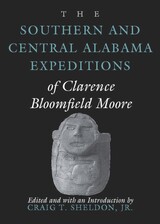 The Southern and Central Alabama Expeditions of Clarence Bloomfield Moore
Clarence Bloomfield Moore, edited and introduced by Craig T. Sheldon Jr.
University of Alabama Press, 2001 Covering 19 years of excavations, this volume provides an invaluable collection of Moore's pioneering archaeological investigations along Alabama's waterways. In 1996, The University of Alabama Press published The Moundville Expeditions of Clarence Bloomfield Moore, which covered a large part of Moore's early archaeological expeditions to the state of Alabama. This volume collects the balance of Moore's Alabama expeditions, with the exception of those Moore made along the Tennessee River, which will be collected in another, forthcoming volume focusing on the Tennessee basin.
This volume includes:
Certain Aboriginal Remains of the Alabama River (1899);
Certain Aboriginal Remains of the Tombigbee River(1901);
a portion of Certain Aboriginal Remains of the Northwest Florida Coast (1901);
The So-Called "Hoe-Shaped Implement" (1903);
Aboriginal Urn-Burial in the United States (1904);
A Form of Urn-Burial on Mobile Bay (1905);
Certain Aboriginal Remains of the Lower Tombigbee River (1905);
Certain Aboriginal Remains on Mobile Bay and on Mississippi Sound (1905);
a portion of Mounds of the Lower Chattahoochee and Lower Flint Rivers (1907);
a portion of The Northwest Florida Coast Revisited(1918).
Craig Sheldon's comprehensive introduction focuses both on the Moore expeditions and on subsequent archaeological excavations at
sites investigated by Moore. Sheldon places Moore's archaeological work in the context of his times and against the backdrop of similar investigations in the Southeast. Sheldon discusses practical matters, such as the various assistants Moore employed and their roles in these historic expeditions. He provides brief vignettes of daily life on the Gopher and describes Moore's work habits, revealing professional and personal biographical details previously unknown about this enigmatic archaeologist.
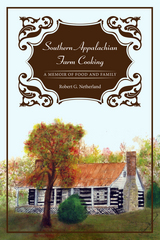 Southern Appalachian Farm Cooking: A Memoir of Food and Family
Robert G. Netherland
University of Tennessee Press, 2016 Part cookbook and part memoir, Southern Appalachian Farm Cooking blends staples of farm-fresh, Appalachian cuisine with stories of life on a large farm in East Tennessee, where homemade biscuits and harvest vegetables were the fruits of hard work and meager earnings. Robert G. Netherland begins with the family farm: a sprawling sixty acres of fertile, rolling hills located in the small town of Surgoinsville, Tennessee, situated between bends in the Holston River. From there, Netherland guides the reader through threshing wheat, churning butter, sharecroppers and country doctors, hunting and hog killing, and all the while sharing updated versions of his family’s recipes for authentic farm-to-table food. From biscuits to cornbread, freshly shelled beans to red-ripe tomatoes, and savory meats to the sweetest cherry pies, Southern Appalachian Farm Cooking provides the home cook with recipes and historical asides to turn any trip to the farmer’s market into a delicious family affair. In sharing his experiences, Netherland reminds us of a time when prepackaged and plastic-wrapped food didn’t line our counters and fill our cabinets, but in its place were baskets of seasonal fruit, canned vegetables, fresh baked breads, and hot-from-the-oven cobblers. Southern Appalachian Farm Cooking is more than just a nostalgic memoir of farming and food, it’s also filled with healthy, simple, everyday eats for the modern cook.
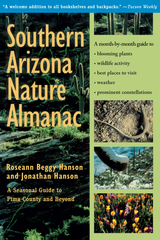 Southern Arizona Nature Almanac
Roseann Beggy Hanson and Jonathan Hanson
University of Arizona Press, 2003 Southern Arizona is a not only a world-class travel destination, it's also a region with so many natural attractions that even its residents never run out of places to explore. The Southern Arizona Nature Almanac reveals the incredible diversity of the desert Southwest by highlighting its most compelling features and natural phenomena for each month of the year: blooming plants, wildlife activity, places to visit, weather, and prominent constellations. From migratory birds to snakes to insects, the almanac will show you what to expect in the sky or under your feet, no matter what season you venture out.
In addition to original illustrations by Jonathan Hanson, the guide includes photos and weather charts. Handy appendixes include lists of birds, mammals, reptiles, butterflies, and a desert plants "blooming calendar." Accessible to the fledgling naturalist and detailed enough for the natural scientist, the Southern Arizona Nature Almanac is a definitive resource guide to the natural wonders of this fascinating land.
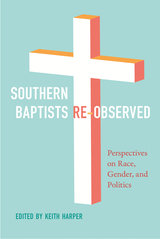 Southern Baptists Re-Observed: Perspectives on Race, Gender, and Politics
Keith Harper
University of Tennessee Press, 2022 In 1993, sociologist Nancy Ammerman published an edited collection, Southern Baptists Observed, that assayed the Southern Baptist Convention (SBC) as the conservative takeover of the denomination was triumphant and expanding. This volume examines the state of the SBC now that it has been under conservative control for a generation. Rather than asking where that change in leadership came from, the question here is what has happened since.
The sweeping success of the conservative takeover—based on enforcing doctrinal fidelity, especially on issues like biblical inerrancy and so-called complementarianism, a rejection of modern, secular values, and advanced international missionary work—veiled a weakness at its very heart. By the turn of the twenty-first century, the conservative resurgence failed to attract new members and, even worse, the younger generation who had grown up in the SBC were fleeing the denomination—nearly half of them are leaving the church as adults and never coming back. The contributors to this volume all offer insights into the question of why. While conservatives dominate the SBC’s governance, they have failed to resolve issues that preoccupy its members and the larger society, including those related to gender, homosexuality, race, and abuse.
The essays are grouped under four broad categories: Truth and Freedom: Baptist Institutions and Contentious Issues; Defining and Defending Biblical Truth: Staking the Boundaries; Apologies, Reconciliation, and Continuing Reality; and the View from Outside. With an introduction by editor Keith Harper contextualizing the history of the movement and the issues it faces today, this collection is sure to add new insight into this influential denomination.
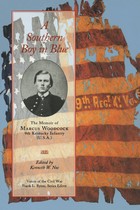 A Southern Boy in Blue: The Memoir of Marcus Woodcock, 9th Kentucky Infantry (U. S. A.)
Kenneth W. Noe
University of Tennessee Press, 2001 Of the one hundred thousand Southerners who donned Federal uniforms during the Civil War, more than forty thousand were Tennesseeans. Not surprisingly, most came from the Appalachian counties of East Tennessee—but not all. A Middle Tennessean named Marcus Woodcock, not yet nineteen when the war began, was among the exceptions.
A Southern Boy in Blue is Woodcock's own account of his experiences during the war. After joining the 9th Kentucky Infantry, Woodcock barely missed the battle of Shiloh—a bout of measles kept him from the front lines—but he went on to see action at Stones River, Chickamauga, and Missionary Ridge. He also participated in the Atlanta campaign and the siege of Corinth and was among the reserves at the battle of Perryville. In three years he rose from the rank of private to that of first lieutenant. Since Woodcock wrote his memoir in 1865 (instead of much later as many veterans did), his descriptions of battles, camp life, and period politics have a special vividness. Woodcock's account is also significant in showing how his views and opinions of the war changed over time. Initially opposed to the use of black troops and to Lincoln's re-election, he eventually converted to both positions and describes the process by which he transformed his thinking.
Woodcock's memoir has been meticulously annotated by Kenneth Noe, who also provides an introduction that places Woodcock's experiences in historical context and describes his postwar career as a prominent Tennessee legislator, attorney, business administrator, and Baptist layman. The book is not only a compelling personal account but an important addition to the literature on Southern Unionism.
The Editor: Kenneth W. Noe is associate professor of history at West Georgia College. He is the author of Southwest Virginia's Railroad: Modernization and the Sectional Crisis.
Southern Capitalism: The Political Economy of North Carolina, 1880–1980
Philip J. Wood
Duke University Press, 1986 Southern Capitalism challenges prevailing views of Southern development by arguing that the persisting peculiarities of the Southern economy—such as low wages and high poverty rates—have not resulted from barriers to capitalist development, nor from the lingering influence of planter values. Wood argues that these peculiarities can instead be best understood as the consequence of a strategy of capitalist development, based on the creation and preservation of social conditions and relations conducive to the above-average exploitation of labor by capital. focusing on the evolving relationship between capital and labor as the core of this strategy, Wood follows the process of capitalist industrialization in North Carolina from its beginnings in the aftermath of the Civil War to the 1980s.
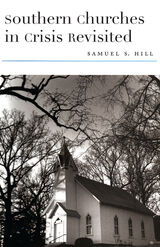 Southern Churches in Crisis Revisited
Samuel S. Hill
University of Alabama Press, 1999 Hill’s landmark work in southern religious history returns to print updated and expanded—and compellingly relevant. In 1966, Samuel S. Hill’s Southern Churches in Crisis argued that southern Protestantism, a cornerstone of white southern society and culture, was shirking its moral duty by refusing to join in the fight for racial justice. Hill predicted that the church was risking its standing in southern society and that it would ultimately decline in influence and power. A groundbreaking study at the time, Hill’s book helped establish southern religious history as a field of scholarly inquiry. Three decades later, Southern Churches in Crisis continues to be widely read, quoted, and cited.
In Southern Churches in Crisis Revisited, which reprints the 1966 text in full, Hill reexamines his earlier predictions in an introductory essay that also describes how the study of religion in the South has become a major field of scholarly inquiry. Hill skillfully engages his critics by integrating new perspectives and recent scholarship. He suggests new areas for exploration and provides a selected bibliography of key studies in southern religious history published in the three decades subsequent to the original appearance of this groundbreaking work.
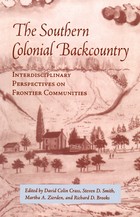 Southern Colonial Backcountry: Interdisciplinary Perspectives
David Colin Crass
University of Tennessee Press, 2005 This book brings a variety of fresh perspectives to bear on the diverse people and settlements of the eighteenth- and early-nineteenth-century southern backcountry. Reflecting the growth of interdisciplinary studies in addressing the backcountry, the volume specifically points to the use of history, archaeology, geography, and material culture studies in examining communities on the southern frontier. Through a series of case studies and overviews, the contributors use cross-disciplinary analysis to look at community formation and maintenance in the backcountry areas of Virginia, North Carolina, South Carolina, and Tennessee.
These essays demonstrate how various combinations of research strategies, conceptual frameworks, and data can afford a new look at a geographical area and its settlement. The contributors offer views on the evolution of backcountry communities by addressing such topics as migration, kinship, public institutions, transportation and communications networks, land markets and real estate claims, and the role of agricultural development in the emergence of a regional economy. In their discussions of individuals in the backcountry, they also explore the multiracial and multiethnic character of southern frontier society.
Yielding new insights unlikely to emerge under a single disciplinary analysis, The Southern Colonial Backcountry is a unique volume that highlights the need for interdisciplinary approaches to the backcountry while identifying common research problems in the field.
The Editors: David Colin Crass is the archaeological services unit manager at the Historic Preservation Division, Georgia Department of Natural Resources.
Steven D. Smith is the head of the Cultural Resources Consulting Division of the South Carolina Institute of Archaeology and Antrhopology.
Martha A. Zierden is curator of historical archaeology at The Charleston Museum.
Richard D. Brooks is the administrative manager of the Savannah River Archeological Research Program, South Carolina Institute of Archaeology and Antrhopology.
The Contributors: Monica L. Beck, Edward Cashin, Charles H. Faulkner, Elizabeth Arnett Fields, Warren R. Hofstra, David C. Hsiung, Kenneth E. Lewis, Donald W. Linebaugh, Turk McCleskey, Robert D. Mitchell, Michael J. Puglisi, Daniel B. Thorp.
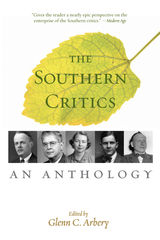 The Southern Critics: An Anthology
Glenn C. Arbery
Intercollegiate Studies Institute, 2010
The literary greatness of the South
In the early 1920s a collection of young Southerners at Vanderbilt University formed the literary group known as the Fugitives. Over the next few decades they and their followers would exert an enormous influence on the study of literature. Indeed, the “Southern Critics” included some of the most important American writers and critics of the twentieth century: Robert Penn Warren, Flannery O’Connor, John Crowe Ransom, Allen Tate, and Cleanth Brooks, to name just a few.
In The Southern Critics: An Anthology, editor Glenn C. Arbery gathers the most penetrating essays by these and other writers, bringing their significant contribution back into focus. Arbery’s enlightening commentary allows us to understand how the Southern Critics’ concern for the history and culture of the South informed all their work—not just the landmark Agrarian manifesto I’ll Take My Stand (1930) but even their writings on literature and poetry, including their revolutionary “New Criticism.”
Remarkably, the essays collected here speak to our time as much as to the Southern Critics’ own. In the twenty-first century we recognize the prescience of their warnings about would happen to art, leisure, and time itself when everything fell under the sway of the industrial model
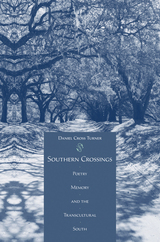 Southern Crossings: Poetry, Memory, and the Transcultural South
Daniel C. Turner
University of Tennessee Press, 2012
“Daniel Cross Turner has made a key contribution to the critical study and appreciation of the diverse field of contemporary Southern poetics. “Southern Crossings” crosses a gulf in contemporary poetry criticism while using the idea—or ideas, many and contrary—of “Southernness” to appraise poetries created from the profuse, tangled histories of the region. Turner’s close readings are dynamic, even lyrical. He offers a new understanding of rhythm’s central place in contemporary poetry while considering the work of fifteen poets. Through his focus on varied yet interwoven forms of cultural memory, Turner also shows that memory is not, in fact, passé. The way we remember has as much to say about our present as our past: memory is living, shifting, culturally formed and framed. This is a valuable and important book that entwines new visions of poetic forms with forms of regional remembrance and identity.”—Natasha Trethewey, Pulitzer Prize winner and author of Native Guard: Poems
Offering new perspectives on a diversity of recent and still-practicing southern poets, from Robert Penn Warren and James Dickey to Betty Adcock, Charles Wright, Yusef Komunyakaa, Natasha Trethewey, and others, this study brilliantly illustrates poetry’s value as a genre well suited to investigating historical conditions and the ways in which they are culturally assimilated and remembered.
Daniel Cross Turner sets the stage for his wide-ranging explorations with an introductory discussion of the famous Fugitive poets John Crowe Ransom, Allen Tate, and Donald Davidson and their vision of a “constant southerness” that included an emphasis on community and kinship, remembrance of the Civil War and its glorified pathos of defeat, and a distinctively southern (white) voice. Combining poetic theory with memory studies, he then shows how later poets, with their own unique forms of cultural remembrance, have reimagined and critiqued the idealized view of the South offered by the Fugitives. This more recent work reflects not just trauma and nostalgia but makes equally trenchant uses of the past, including historiophoty (the recording of history through visual images) and countermemory (resistant strains of cultural memory that disrupt official historical accounts). As Turner demonstrates, the range of poetries produced within and about the American South from the 1950s to the present helps us to recalibrate theories of collective remembrance on regional, national, and even transnational levels.
With its array of new insights on poets of considerable reputation—six of the writers discussed here have won at least one Pulitzer Prize for poetry—Southern Crossings makes a signal contribution to the study of not only modern poetics and literary theory but also of the U.S. South and its place in the larger world.
Daniel Cross Turner is an assistant professor of English at Coastal Carolina University. His articles, which focus on regional definition in national and global contexts and on aesthetic forms’ potential to record historical transitions, appear in edited collections as well as journals including Genre, Mosaic, the Southern Literary Journal, the Southern Quarterly, and the Mississippi Quarterly.
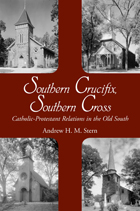 Southern Crucifix, Southern Cross: Catholic-Protestant Relations in the Old South
Andrew Henry Stern
University of Alabama Press, 2012 Southern Crucifix, Southern Cross examines the complex and often overlooked relationships between Catholics and Protestants in the antebellum South.
In sharp contrast to many long-standing presumptions about mistrust or animosity between these two groups, this study proposes that Catholic and Protestant interactions in the South were characterized more by cooperation than by conflict.
Andrew H. M. Stern argues that Catholics worked to integrate themselves into southern society without compromising their religious beliefs and that many Protestants accepted and supported them. Catholic leaders demonstrated the compatibility of Catholicism with American ideals and institutions, and Protestants recognized Catholics as useful citizens, true Americans, and loyal southerners, in particular citing their support for slavery and their hatred of abolitionism. Mutual assistance between the two groups proved most clear in shared public spaces, with Catholics and Protestants participating in each other’s institutions and funding each other’s enterprises. Catholics and Protestants worshipped in each other’s churches, studied in each other’s schools, and recovered or died in each other’s hospitals. In many histories of southern religion, typically thought of as Protestant, Catholicism tends to be absent. Likewise, in studies of American Catholicism, Catholic relationships with Protestants, including southern Protestants, are rarely discussed. Southern Crucifix, Southern Cross is the first book to demonstrate in detail the ways in which many Protestants actively fostered the growth of American Catholicism. Stern complicates the dominant historical view of interreligious animosity and offers an unexpected model of religious pluralism that helped to shape southern culture as we know it today.
 The Southern Debate over Slavery: Volume 1: Petitions to Southern Legislatures, 1778-1864
Edited by Loren Schweninger
University of Illinois Press, 2001 An incomparably rich source of period information, The Southern Debate over Slavery offers a representative sampling of the thousands of petitions about issues of race and slavery that southerners submitted to their state legislatures between the American Revolution and the Civil War.
These petitions, filed by slaveholders and nonslaveholders, slaves and free blacks, women and men, abolitionists and staunch defenders of slavery, constitute a uniquely important primary source. Petitioners were compelled to present the most accurate and fully documented case they could, since their claims would be subject to public scrutiny and legal verification. Unlike the many reminiscences and autobiographies of the period, these petitions record with great immediacy and minute detail the dynamics, common understandings, and legal restrictions and parameters that shaped southern society during this period.
Arranged chronologically, with their original spelling and idiosyncratic phraseology intact, these documents reveal the grim and brutal nature of human bondage, the fears of whites who lived among large concentrations of blacks, and the workings of the complicated legal system designed to control blacks. They tell about the yearning of bondspeople to gain their freedom, the attitudes of freed blacks who were forced to leave the South, and the efforts of African Americans to overcome harsh and restrictive laws. They also underscore the unique situation of free women of color and the reliance of manumitted (formally freed) blacks on their former owners for protection, travel passes, guardianship papers, and reference letters.
Astonishingly intimate and frank,The Southern Debate over Slavery illuminates how slavery penetrated nearly every aspect of southern life and how various groups of southerners responded to the difficulties they confronted as a result of living in a slave society.
The Southern Debate over Slavery: Volume 2: Petitions to Southern County Courts, 1775-1867
Edited by Loren Schweninger
University of Illinois Press, 2007 An incomparably rich source of period information, the second volume of The Southern Debate over Slavery offers a representative and extraordinary sampling of the thousands of petitions about issues of race and slavery that southerners submitted to county courts between the American Revolution and Civil War. These petitions, filed by slaveholders and nonslaveholders, slaves and free blacks, women and men, abolitionists and staunch defenders of slavery, constitute a uniquely important primary source. The collection records with great immediacy and minute detail the dynamics and legal restrictions that shaped southern society.
Southern Discomfort: Women's Activism in Tampa, Florida, 1880s-1920s
Nancy A. Hewitt
University of Illinois Press, 2001 Linked to the Caribbean and southern Europe as well as to the Confederacy, the Cigar City of Tampa, Florida, never fit comfortably into the biracial mold of the New South. Nancy A. Hewitt explores the interactions among distinct groups of women--native-born white, African American, Cuban and Italian immigrant women--that shaped women's activism in the vibrant, multiethnic city. Hewitt emphasizes the process by which women forged and reformulated their activist identities from Reconstruction through the U.S. declaration of war against Spain in April 1898, the industrywide cigar strike of 1901, and the emergence of progressive reform and labor militancy. She also recasts our understanding of southern history by demonstrating how Tampa's triracial networks alternately challenged and re-inscribed the South's biracial social and political order.
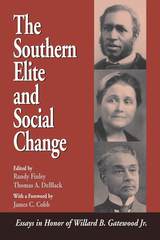 The Southern Elite and Social Change: Essays in Honor of Willard B. Gatewood, Jr.
Randy Finley
University of Arkansas Press, 2002 Elites have shaped southern life and communities, argues the distinguished historian Willard Gatewood. These essays—written by Gatewood's colleagues and former students in his honor—explore the influence of particular elites in the South from the American Revolution to the Little Rock integration crisis. They discuss not only the power of elites to shape the experiences of the ordinary people, but the tensions and negotiations between elites in a particular locale, whether those elites were white or black, urban or rural, or male or female. Subjects include the particular kinds of power available to black elites in Savannah, Georgia, during the American Revolution; the transformation of a southern secessionist into an anti-slavery activist during the Civil War; a Tenessee "aristocrat of color" active in politics from Reconstruction to World War II; middle-class Southern women, both black and white, in the New Deal and the Little Rock integration crisis; and the different brands of paternalism in Arkansas plantations during the Jacksonian and Jim Crow eras and in the postwar Georgia carpet industry.
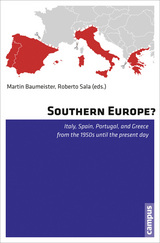 Southern Europe?: Italy, Spain, Portugal, and Greece from the 1950s Until the Present Day
Edited by Martin Baumeister and Roberto Sala
Campus Verlag, 2015 According to mainstream discourse of the Cold War, post-1945 Western Europe was essentially a homogeneous historical space fully integrated into modern industrial society. But as Southern Europe? makes clear, Western European societies were in fact divided by deep political and economic inequalities. While nations in the north embodied consolidated democracies, Spain, Portugal, and Greece were at times all authoritarian regimes. Deeply afflicted with underdevelopment, these countries were cut off from the “economic miracles” other Western European states were experiencing. With its weak democracy, Italy held a contradictory position between the struggles of the Iberian and Greek peninsulas and the progress of its neighbors beyond the Alps.
Now, old inequalities long believed to be things of the past have resurfaced, and a new debt crisis appears to be splitting the continent apart along historic lines. This book raises the important question of whether studying the geopolitics and social history of southern Europe might be a valuable analytical tool for understanding these contemporary financial catastrophes.
Southern Exposure: Making the South Safe for Democracy
Stetson Kennedy
University of Alabama Press, 2011 Using thorough and stark statistics, Kennedy describes a South emerging from World War II, coming to grips with the racism and feudalism that had held it back for generations. He includes an all-out Who’s Who, based on his own undercover investigations, of the "hate-mongers, race-racketeers, and terrorists who swore that apartheid must go on forever." The first paperback edition brings to a new generation of readers Kennedy’s searing profile of Dixie before the civil rights movement.
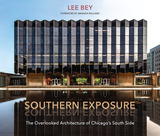 Southern Exposure: The Overlooked Architecture of Chicago's South Side
Lee Bey; Foreword by Amanda Willliams
Northwestern University Press, 2019 Southern Exposure: The Overlooked Architecture of Chicago’s South Side is the first book devoted to the South Side’s rich and unfairly ignored architectural heritage. With lively, insightful text and gallery-quality color photographs by noted Chicago architecture expert Lee Bey, Southern Exposure documents the remarkable and largely unsung architecture of the South Side. The book features an array of landmarks—from a Space Age dry cleaner to a nineteenth-century lagoon that meanders down the middle of a working-class neighborhood street—that are largely absent from arts discourse, in no small part because they sit in a predominantly African American and Latino section of town better known as a place of disinvestment, abandonment, and violence.
Inspired by Bey’s 2017 Chicago Architecture Biennial exhibition, Southern Exposure visits sixty sites, including lesser-known but important work by luminaries such as Jeanne Gang, Frank Lloyd Wright, and Eero Saarinen, as well as buildings by pioneering black architects such as Walter T. Bailey, John Moutoussamy, and Roger Margerum.
Pushing against the popular narrative that depicts Chicago’s South Side as an architectural wasteland, Bey shows beautiful and intact buildings and neighborhoods that reflect the value—and potential—of the area. Southern Exposure offers much to delight architecture aficionados and writers, native Chicagoans and guests to the city alike.
Southern Foodways and Culture: Local Considerations and Beyond
Lisa J. Lefler
University of Tennessee Press, 2013 Southern Foodways and Culture brings together papers from the 46th Southern Anthropological Society (SAS) meeting in Oxford, Mississippi. This volume represents the work of anthropologists who share interest in the importance of food and in the use of plants and animals.
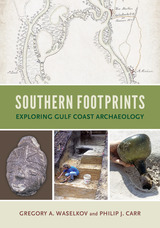 Southern Footprints: Exploring Gulf Coast Archaeology
Gregory A. Waselkov and Philip J. Carr
University of Alabama Press, 2024 A “greatest hits” of archaeological research that has transformed knowledge of human history Southern Footprints celebrates more than fifty years of archaeological research along the Gulf Coast by the University of South Alabama and the Center for Archaeological Studies. Archaeologists Gregory A. Waselkov and Philip J. Carr, the former and current directors of the center, present the “greatest hits” that have transformed knowledge of human history on the Alabama and Mississippi Gulf Coast from the Ice Age until recently. Each archaeological site, from surface collections to premiere archaeological preserves, such as Old Mobile and Holy Ground, offers clues to the past. The chapters in this collection are arranged chronologically and survey the history and archaeology of a wide range of significant sites, including the Gulf Shores canoe canal, Bottle Creek Mounds, Old Mobile, Fort Mims, Spanish Fort, Spring Hill College, and Mobile River Bridge. Waselkov and Carr take care to acknowledge in these stories populations who have been historically underdocumented, now recognizing the contributions of Native Americans and African Americans that have been uncovered through archaeology. The authors reveal the dire impacts of climate change, environmental disasters, development, and neglect—and convey their urgency to protect these areas of shared history—as a result of the meticulous excavation, analysis, and preservation of artifacts from these sites. Color photographs showcase the archaeology as it unfolds, often with the help of dedicated volunteers. Southern Footprints will serve as an indispensable reference on the rich Gulf Coast heritage for all to appreciate.
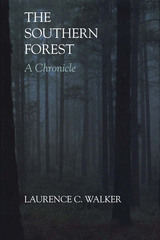 The Southern Forest: A Chronicle
By Laurence C. Walker
University of Texas Press, 1991 When the first European explorers reached the southern shores of North America in the early seventeenth century, they faced a solid forest that stretched all the way from the Atlantic coast to eastern Texas and Oklahoma. The ways in which they and their descendants used—and abused—the forest over the next nearly four hundred years form the subject of The Southern Forest. In chapters on the explorers, pioneers, lumbermen, boatbuilders, and foresters, Laurence Walker chronicles the constant demands that people have made on forest resources in the South. He shows how the land's very abundance became its greatest liability, as people overhunted the animals, clearcut the forests, and wore out the soil with unwise farming practices—all in a mistaken belief that the forest's bounty (including new ground to be broken) was inexhaustible. With the advent of professional forestry in the twentieth century, however, the southern forest has made a comeback. A professional forester himself, Walker speaks from experience of the difficulties that foresters face in balancing competing interests in the forest. How, for example, does one reconcile the country's growing demand for paper products with the insistence of environmental groups that no trees be cut? Should national forests be strictly recreational areas, or can they support some industrial logging? How do foresters avoid using chemical pesticides when the public protests such natural management practices as prescribed burning and tree cutting? This personal view of the southern forest adds a new dimension to the study of southern history and culture. The primeval southern forest is gone, but, with careful husbandry on the part of all users, the regenerated southern forest may indeed prove to be the inexhaustible resource of which our ancestors dreamed.
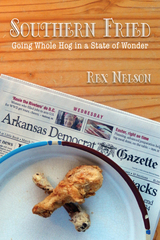 Southern Fried: Going Whole Hog in a State of Wonder
Rex Nelson
Butler Center for Arkansas Studies, 2016 For decades, Rex Nelson has been traveling Arkansas. He learned to love the back roads, small towns, and people of the state while going on trips with his father, who sold athletic supplies to high schools. They sat in old Depression-era gyms built by the Works Progress Administration, ate in small-town cafes, and waded in streams on warm spring days. Throughout his career as a sportswriter, political writer, senior staff member in the governor’s office, presidential appointee to the Delta Regional Authority, and now corporate communications director for Simmons Bank, Nelson has written millions of words about Arkansas and its people. In this collection of columns from the Arkansas Democrat-Gazette, Nelson brings to life the personalities, communities, festivals, and tourist attractions that make Arkansas unique. As he says, “Arkansas is a hard place to explain to outsiders. We’re mostly Southern but also a bit Midwestern and a tad Southwestern. The Ozarks are different from the pine woods of the Gulf Coastal Plain, and the Delta is different from the Ouachitas. Invariably, though, those who take the time to get off the main roads and get to know the real Arkansas are entranced by the place.”
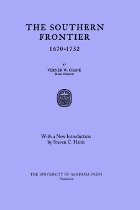 The Southern Frontier 1670-1732
Verner Crane, with a new introduction by Steven C. Hahn
University of Alabama Press, 2004 A classic resource on the struggle for dominance in southern North America during the colonial period This volume recounts the clashes and intrigues that played out over the landscape of the Old Southwest and across six decades as the Spanish, French, British, and ultimately Americans vied for control. Rivalry began soon after initial discovery, mapping, and exploration as the world powers, particularly England and France, competed for control of the lucrative fur trade in the Mississippi valley. The French attempted to establish trade networks stretching from the Atlantic Ocean inland to the Mississippi River and northward from ports on the Gulf of Mexico to the Ohio River. But they found the British already entrenched there. Verner Crane guides us through this multinational struggle and navigates the border wars and diplomatic intrigues that played crucial roles in the settlement of the South by Euro-Americans. In his new introduction, Steven Hahn places the work in the context of its time, sketches its publication history, and provides biographical information on Crane.
Southern Frontier, 1670-1732: 1670-1732
Verner W. Crane
University of Michigan Press, 1929 The Southern Frontier looks at the origins of Anglo-Americans in the Southeastern United States. It covers a time frame from the first settlements along the Carolina coast, to the Indian Revolt of 1715, to the genesis of Georgia as a colony, and a means to protect British interests in America. The struggles include Queen Anne's War, the Yamesee War, and various diplomatic and militaristic struggles with the Native Americans and the Spanish.
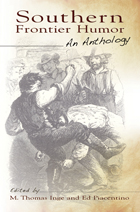 Southern Frontier Humor: An Anthology
Edited by M. Thomas Inge & Ed Piacentino
University of Missouri Press, 2010 If, as some suggest, American literature began with Huckleberry Finn, then the humorists of the Old South surely helped us to shape that literature. Twain himself learned to write by reading the humorists’ work, and later writers were influenced by it. This book marks the first new collection of humor from that region published in fifteen years—and the first fresh selection of sketches and tales to appear in over forty years. Thomas Inge and Ed Piacentino bring their knowledge of and fondness for this genre to a collection that reflects the considerable body of scholarship that has been published on its major figures and the place of the movement in American literary history. They breathe new life into the subject, gathering a new selection of texts and adding Twain—the only major American author to contribute to and emerge from the movement—as well as several recently identified humorists. All of the major writers are represented, from Augustus Baldwin Longstreet to Thomas Bangs Thorpe, as well as a great many lesser-known figures like Hamilton C. Jones, Joseph M. Field, and John S. Robb. The anthology also includes several writers only recently discovered to be a part of the tradition, such as Joseph Gault, Christopher Mason Haile, James Edward Henry, and Marcus Lafayette Byrn, and features authors previously overlooked, such as William Gilmore Simms, Ham Jones, Orlando Benedict Mayer, and Adam Summer. Selections are timely, reflecting recent trends in literary history and criticism sensitive to issues of gender, race, and ethnicity. The editors have also taken pains to seek out first printings to avoid the kinds of textual corruptions that often occur in later versions of these sketches. Southern Frontier Humor offers students and general readers alike a broad perspective and new appreciation of this singular form of writing from the Old South—and provides some chuckles along the way.
Southern Gardens, Southern Gardening
William Lanier Hunt
Duke University Press, 1992 Originally published in 1982, this bestselling collection of gardening writing by William Lanier Hunt--one of the South’s leading gardening writers and horticulturalists--is now available for the first time in paperback. Arranged by months of the year, Southern Gardens, Southern Gardening is filled with useful, commensense instruction, as well as the wisdom and art of gardening.
 Southern Governors and Civil Rights: Racial Segregation as a Campaign Issue in the Second Reconstruction
Earl Black
Harvard University Press, 1976 This book offers a systematic, comprehensive analysis of the rise and partial decline of racial segregation as an issue in southern electoral politics throughout the entire South over the third quarter of the twentieth century. The first comparative examination of a white political elite, the study draws upon an extraordinary breadth of data: 80 governorships, over 250 candidates, six “waves” of elections for each of the eleven southern states from 1950 to 1973.
By classifying candidates for the southern governorships according to their campaign stances on racial segregation, Earl Black maps out the changing racial attitudes of white office seekers over a critical period in southern history—the time now referred to as the Second Reconstruction. He shows that, largely because of Federal pressures, segregationist orientations have increasingly been replaced by nonsegregationist perspectives, and that the decline of segregationist rhetoric has been more evident in the peripheral south than in the deep south. Specific areas include: the segregation issue in the early 1950s; state-by-state summaries of the segregation issue after 1954; and the relationship between the candidates' campaign platform on race and their ability to run successfully at consecutive stages of the electoral process.
Black's conclusion that “stateways” can alter “folkways” is well-reasoned and persuasive. Accessible to all readers interested in public affairs, Southern Governors and Civil Rights makes a significant contribution to the literature on the consequences of national intervention to change southern racial attitudes.
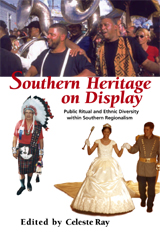 Southern Heritage on Display: Public Ritual and Ethnic Diversity within Southern Regionalism
Edited by Celeste Ray
University of Alabama Press, 2002 How ritualized public ceremonies affirm or challenge cultural identities associated with the American South
W. J. Cash's 1941 observation that “there are many Souths and many cultural traditions among them” is certainly validated by this book. Although the Civil War and its “lost cause” tradition continues to serve as a cultural root paradigm in celebrations, both uniting and dividing loyalties, southerners also embrace a panoply of public rituals—parades, cook-offs, kinship homecomings, church assemblies, music spectacles, and material culture exhibitions—that affirm other identities. From the Appalachian uplands to the Mississippi Delta, from Kentucky bluegrass to Carolina piedmont, southerners celebrate in festivals that showcase their diverse cultural backgrounds and their mythic beliefs about themselves.
The ten essays of this cohesive, interdisciplinary collection present event-centered research from various fields of study—anthropology, geography, history, and literature—to establish a rich, complex picture of the stereotypically “Solid South.” Topics include the Mardi Gras Indian song cycle as a means of expressing African-American identity in New Orleans; powwow performances and Native American traditions in southeast North Carolina; religious healings in southern Appalachian communities; Mexican Independence Day festivals in central Florida; and, in eastern Tennessee, bonding ceremonies of melungeons who share Indian, Scots Irish, Mediterranean, and African ancestry. Seen together, these public heritage displays reveal a rich “creole” of cultures that have always been a part of southern life and that continue to affirm a flourishing regionalism.
This book will be valuable to students and scholars of cultural anthropology, American studies, and southern history; academic and public libraries; and general readers interested in the American South. It contributes a vibrant, colorful layer of understanding to the continuously emerging picture of complexity in this region historically depicted by simple stereotypes.
 Southern Horrors: Women and the Politics of Rape and Lynching
Crystal N. Feimster
Harvard University Press, 2011 Between 1880 and 1930, close to 200 women were murdered by lynch mobs in the American South. Many more were tarred and feathered, burned, whipped, or raped. In this brutal world of white supremacist politics and patriarchy, a world violently divided by race, gender, and class, black and white women defended themselves and challenged the male power brokers. Crystal Feimster breaks new ground in her story of the racial politics of the postbellum South by focusing on the volatile issue of sexual violence.
Pairing the lives of two Southern women—Ida B. Wells, who fearlessly branded lynching a white tool of political terror against southern blacks, and Rebecca Latimer Felton, who urged white men to prove their manhood by lynching black men accused of raping white women—Feimster makes visible the ways in which black and white women sought protection and political power in the New South. While Wells was black and Felton was white, both were journalists, temperance women, suffragists, and anti-rape activists. By placing their concerns at the center of southern politics, Feimster illuminates a critical and novel aspect of southern racial and sexual dynamics. Despite being on opposite sides of the lynching question, both Wells and Felton sought protection from sexual violence and political empowerment for women.
Southern Horrors provides a startling view into the Jim Crow South where the precarious and subordinate position of women linked black and white anti-rape activists together in fragile political alliances. It is a story that reveals how the complex drama of political power, race, and sex played out in the lives of Southern women.
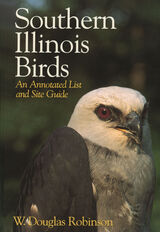 Southern Illinois Birds: An Annotated List and Site Guide
W. Douglas Robinson
Southern Illinois University Press, 1996 Designed to help bird watchers in the field and at home discover the significance of their observations, Southern Illinois Birds documents current knowledge of the birds of southern Illinois by surveying both the published literature on the subject and the unpublished field notes of active observers summarizing many important observations that are not readily available elsewhere.
Bordered on three sides by major rivers, with both upland and lowland forests and dramatic topographic relief in the unglaciated Shawnee Hills, southern Illinois offers a wide variety of habitats and birds unusual to Illinois and the Midwest in general. Compared with studies in central and northern Illinois, there have been few active field observers in the south; yet the contributions of those who worked in southern Illinois have been considerable. Robinson displays their efforts convincingly in this book.
Southern Illinois Birds includes information on early arrival and late departure dates of migrants, the highest reported single-day counts in each season, and records of all vagrants. In addition, Robinson includes maps and guides to some of the best birding areas in the region to encourage birders and others to explore the many birding and scenic attractions in southern Illinois.
Robinson has produced a definitive reference for ornithologists and amateur bird watchers, conservation and government agencies, college students in biology, and future researchers who wish to determine the status and abundance of southern Illinois birds.
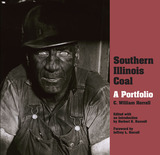 Southern Illinois Coal: A Portfolio
C. William Horrell. Edited with an Introduction by Herbert K. Russell. Foreword by Jeffrey L. Horrell
Southern Illinois University Press, 1995 The coal mining photographs of C. William Horrell, taken across the southern Illinois Coal Belt over a twenty-year period from 1966 to 1986, are extraordinary examples of documentary photography—so stark and striking that captions often seem superfluous. Horrell’s photographs capture the varied phenomena of twentieth-century coal mining technology: the awesome scale of surface mining machines and their impact on the land; massive machines forced into narrow passageways with inches to spare as they carry coal from the face to conveyer belts; and, more significant, the advent of continuous miners, machines that can handle four previously separate processes and which have been a fixture in underground or “deep” mines since the mid-1960s. Horrell was also intrigued by the related activities of mining, including coal’s processing, cleaning, and transportation, as well as the daily, behind-the-scenes operations that keep mines and miners working. His photographs reflect the beauty of the commonplace—the clothes of the miners, their dinner pails, and their tools—and reveal the picturesque remnants of closed mines: the weathered boards of company houses, the imposing iron beauty of an ancient tipple, and an abandoned building against the lowering sky of an approaching storm. Finally, his portraits of coal minersshow the strength, dignity, and enduring spirit of the men and women who work the southern Illinois coal mines.
 Southern Illinois Fishing: A Comprehensive Guide for Anglers
Colby Simms
Southern Illinois University Press, 2025 The ultimate resource for sport fishing in southern Illinois
Southern Illinois’s many waterways teem with an incredible variety of fish species, and award-winning fisherman and journalist Colby Simms knows exactly where and how to catch them all.
Within these pages, Simms shares the secrets he’s gleaned from years of hard-won experience: colossal catfish dominate the Mississippi River; monstrous muskies rule over Kinkaid Lake. Rend gives up record crappie and bowfin, while Crab Orchard produces excellent largemouth bass fishing and Cedar offers huge striped bass. Whether you’re powerboating a large lake or paddling an out-of-the-way oxbow, the region presents countless opportunities for different styles of fishing. Wondering which bait and tackle will produce the best results, or how seasonal weather affects fish migration patterns? Simms has already conferred with fellow fishing pros as well as biologists, outdoor sports media figures, and other experts to bring you the most current, site-specific information possible. From fishing fundamentals to the most advanced, cutting-edge techniques, he presents a battle plan for attacking the waters, big and small, of the lower Prairie State, which will benefit all anglers—from beginners to seasoned tournament competitors.
Nestled between the critical information and detailed instructions, you’ll find stories from Simms and additional professional anglers, state fisheries staff, recreational fishers, and others. You’ll find encouragement and motivation to put away life’s modern distractions and get back to nature. Southern Illinois Fishing brims with enthusiasm, humor, and heart, and is sure to educate and inspire readers to lose themselves in the ancient tradition and modern sport of fishing.
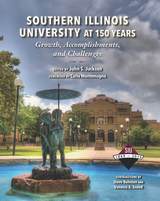 Southern Illinois University at 150 Years: Growth, Accomplishments, and Challenges
Edited by John S. Jackson with a Foreword by Carlo Montemagno and Contributions by Steve Buhman and Vanessa A. Sneed
Southern Illinois University Press, 2019 Chartered in 1869, Southern Illinois University has been a stalwart presence on the southern Illinois landscape for a century and a half. This book celebrates the 150th anniversary of the university’s founding by exploring in depth its history since 1969, when the last book to celebrate a major anniversary was published.
Chapters reflect on SIU’s successful athletics program, the various colleges and departments within the university, the diverse holdings and collections of the library, the unique innovative research enterprises, and special programs such as the Paul Simon Public Policy Institute and Touch of Nature Environmental Center.
Although SIU may be a typical large public university in many ways, its unique location, history, and culture have made it a distinct institution of higher education. Located close to the Shawnee National Forest and Giant City State Park, the landscape is an indelible part of SIU, contributing to both the beauty of the university grounds and the campus culture.
The university’s sesquicentennial provides a wonderful opportunity to revisit all that makes SIU amazing. Illustrated with 306 photographs of theater and music performances, art, sports, past and present students, faculty, staff, administration, politicians, community members, successful alums, distinguished visitors, and patrons of the university buildings, and landscapes, Southern Illinois University at 150 Years captures the university’s story in all its vivid color.
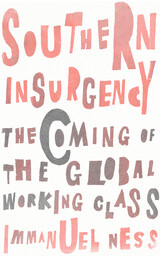 Southern Insurgency: The Coming of the Global Working Class
Immanuel Ness
Pluto Press, 2015 Even as labor in the developed world seems to be in retreat, industrial struggle continues elsewhere—and with particular force in the Global South. In Southern Insurgency, Immanuel Ness provides a thorough and expert perspective of three key countries where workers are fighting the spread of unchecked industrial capitalism: China, India, and South Africa. In each case, he considers the broader historical forces in play, such as the effects of imperialism, the decline of the international union movement, class struggle, and the growing reserve of available labor. He then narrows his focus in each case on the specifics of the current grassroots insurgency: the militancy of miners in South Africa, new labor organizations in India, and the rise of worker insurgencies in China.
The product of extensive firsthand field research, Southern Insurgency paints a picture of the new industrial proletariat in the Global South—a group that lives a precarious, frightening existence yet at the same time offers hope for new approaches to solidarity and the anti-capitalist struggle.
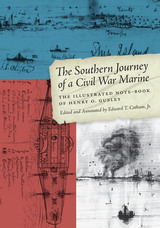 The Southern Journey of a Civil War Marine: The Illustrated Note-Book of Henry O. Gusley
Edited and annotated by Edward T. Cotham, Jr.
University of Texas Press, 2006 On September 28, 1863, the Galveston Tri-Weekly News caught its readers' attention with an item headlined "A Yankee Note-Book." It was the first installment of a diary confiscated from U.S. Marine Henry O. Gusley, who had been captured at the Battle of Sabine Pass. Gusley's diary proved so popular with readers that they clamored for more, causing the newspaper to run each excerpt twice until the whole diary was published. For many in Gusley's Confederate readership, his diary provided a rare glimpse into the opinions and feelings of an ordinary Yankee—an enemy whom, they quickly discovered, it would be easy to regard as a friend. This book contains the complete text of Henry Gusley's Civil War diary, expertly annotated and introduced by Edward Cotham. One of the few journals that have survived from U.S. Marines who served along the Gulf Coast, it records some of the most important naval campaigns of the Civil War, including the spectacular Union success at New Orleans and the embarrassing defeats at Galveston and Sabine Pass. It also offers an unmatched portrait of daily life aboard ship. Accompanying the diary entries are previously unpublished drawings by Daniel Nestell, a doctor who served in the same flotilla and eventually on the same ship as Gusley, which depict many of the locales and events that Gusley describes. Together, Gusley's diary and Nestell's drawings are like picture postcards from the Civil War—vivid, literary, often moving dispatches from one of "Uncle Sam's nephews in the Gulf."
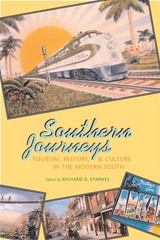 Southern Journeys: Tourism, History, and Culture in the Modern South
Edited by Richard D. Starnes
University of Alabama Press, 2003 The first collection of its kind to examine tourism as a complicated and vital force in southern history, culture, and economics Anyone who has seen Rock City, wandered the grounds of Graceland, hiked in Great Smoky Mountains National Park, or watched the mermaids swim at Weeki Wachee knows the southern United States offers visitors a rich variety of scenic, cultural, and leisure activities. Tourism has been, and is still, one of the most powerful economic forces in the modern South. It is a multibillion-dollar industry that creates jobs and generates revenue while drawing visitors from around the world to enjoy the region’s natural and man-made attractions. This collection of 11 essays explores tourism as a defining force in southern history by focusing on particular influences and localities. Alecia Long examines sex as a fundamental component of tourism in New Orleans in the early 20th century, while Brooks Blevins describes how tourism served as a modernizing influence on the Arkansas Ozarks, even as the region promoted itself as a land of quaint, primitive hillbillies. Anne Whisnant chronicles the battle between North Carolina officials building the Blue Ridge Parkway and the owner of Little Switzerland, who fought for access and advertising along the scenic highway. One essay probes the racial politics behind the development of Hilton Head Island, while another looks at the growth of Florida's panhandle into a “redneck Riviera,” catering principally to southerners, rather than northern tourists. Southern Journeys is a pioneering work in southern history. It introduces a new window through which to view the region's distinctiveness. Scholars and students of environmental history, business history, labor history, and social history will all benefit from a consideration of the place of tourism in southern life.
Southern Labor and Black Civil Rights: Organizing Memphis Workers
Michael K. Honey
University of Illinois Press, 1993 Widely praised upon publication and now considered a classic study, Southern Labor and Black Civil Rights chronicles the southern industrial union movement from the Great Depression to the Cold War, a history that created the context for the sanitation workers' strike that brought Dr. Martin Luther King, Jr. to Memphis in April 1968. Michael K. Honey documents the dramatic labor battles and sometimes heroic activities of workers and organizers that helped to set the stage for segregation's demise.
Winner of the Charles S. Sydnor Award, given by the Southern Historical Association, 1994. Winner of the James A. Rawley Prize given by the Organization of American Historians, 1994. Winner of the Herbert G. Gutman Award for an outstanding book in American social history.
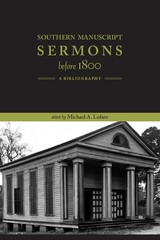 Southern Manuscript Sermons before 1800: A Bibliography
Michael A. Lofaro
University of Tennessee Press, 2010
Southern Manuscript Sermons before 1800 is the first guide to the study of the manuscript sermon literature of the Southern colonies/states of Maryland, Virginia, North Carolina, South Carolina, and Georgia. The bibliography contains entries for over 1,600 sermons by over a hundred ministers affiliated with eight denominations. The compilation provides a previously unavailable major tool for research into the early South.
Richard Beale Davis began the bibliography in 1946 as part of his research for Intellectual Life in the Colonial South, 1585-1763, which won the National Book Award in history. Michael A. Lofaro took over the project in 1976, expanded the colonial entries (pre-1764), and added the period of 1764-1799. George M. Barringer contributed entries for Jesuit sermons. Sandra G. Hancock contributed those for Thomas Cradock.
The bibliography is also available online (dlc.lib.utk.edu/sermons). This database contains the same in-depth descriptions of these sermons, over 90 percent of which are unknown. It provides multiple avenues of access. Searches can be constructed and limited by single or combined criteria of author, repository, book of the Bible, date, state, denomination, keyword, and short title.
Scholars can employ both versions of this tool to construct a more complete picture of the southern mind before 1800 and to reveal how that mind contributes to a national ethos. The bibliography will aid many disciplines—religion, cultural and American studies, history, literature, political science, sociology, psychology, and more—and all those who wish to interpret the past and its effect upon the present. It will lead to a more balanced appraisal of American intellectual history by encouraging access to a large body of southern sermons to place alongside those of the northern and middle states for critical assessment.
Southern Marches of Imperial Ethiopia: Essays in History and Social Anthropology
Donald L. Donham
Ohio University Press, 2002 This pioneering book, first published to wide acclaim in 1986, traces the way the Ethiopian center and the peripheral regions of the country affected each other. It looks specifically at the expansion of the highland Ethiopian state into the western and southern lowlands from the 1890s up to 1974.
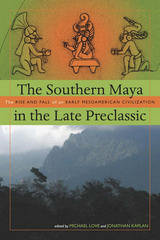 The Southern Maya in the Late Preclassic: The Rise and Fall of an Early Mesoamerican Civilization
Michael Love
University Press of Colorado, 2011 From 400 BC to AD 250, the southern Maya region was one of the most remarkable civilizations of the ancient Americas. Filled with great cities linked by flourishing long-distance trade, shared elite ideologies, and a vibrant material culture, this region was pivotal not only for the Maya but for Mesoamerica as a whole. Although it has been of great interest to scholars, gaps in the knowledge have led to debate on the most vital questions about the southern region.
Recent research has provided a wealth of broadly based new data that have expanded the understanding of this region and its influence on greater Mesoamerica. In The Southern Maya in the Late Preclassic, prominent contributors debate whether the southern region was indeed "Maya" or instead a region of intense multiethnic interaction, with speakers of many languages and many sources of identity. The chapters address a host of advanced developments to which this area can lay claim--urbanism and city-states, the earliest Maya writing, and the origin of the Maya calendar--as well as additional issues including the construction of social and cultural identities, economic networks of early complex societies, relationships between the Maya and the Olmec, and a comprehensive discussion of the ancient city of Kaminaljuyu and its relationship to other cities in the region.
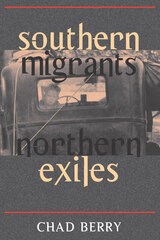 Southern Migrants, Northern Exiles
Chad Berry
University of Illinois Press, 2000 One of the largest internal migrations in U.S. history, the great white migration left its mark on virtually every family in every southern upland and flatland town. In this extraordinary record of ordinary lives, dozens of white southern migrants describe their experiences in the northern "wilderness" and their irradicable attachments to family and community in the South. Southern out-migration drew millions of southern workers to the steel mills, automobile factories, and even agricultural fields and orchards of Ohio, Indiana, Michigan, and Illinois. Through vivid oral histories, Chad Berry explores the conflict between migrants' economic success and their "spiritual exile" in the North. He documents the tension between factory owners who welcomed cheap, naive southern laborers and local "native" workers who greeted migrants with suspicion and hostility. He examines the phenomenon of "shuttle migration," in which migrants came north to work during the winter and returned home to plant spring crops on their southern farms. He also explores the impact of southern traditions--especially the southern evangelical church and "hillbilly" music--brought north by migrants. Berry argues that in spite of being scorned by midwesterners for violence, fecundity, intoxication, laziness, and squalor, the vast majority of southern whites who moved to the Midwest found the economic prosperity they were seeking. By allowing southern migrants to assess their own experiences and tell their own stories, Southern Migrants, Northern Exiles refutes persistent stereotypes about migrants' clannishness, life-style, work ethic, and success in the North.
Southern Nilotic History: Linguistic Approaches to the Study of the Past
Christopher Ehret
Northwestern University Press, 1971 In Southern Nilotic History, Christopher Ehret reconstructs the history of the Southern Nilotic speaking peoples of East Africa, from their earliest origins to the beginning of the colonial period.
“As a history, the book is a remarkable tour de force. Using mainly linguistic evidence, the author locates populations, moves them around, determines their relative influence vis-à-vis their neighbors, and reconstructs aspects of their culture, from basic economy to the practice of extracting incisors.” —American Anthropologist
Southern Paiute: A Portrait
Logan Hebner
Utah State University Press, 2010 Now little recognized by their neighbors, Southern Paiutes once had homelands that included much of the vast Colorado Plateau, Great Basin, and Mojave Desert. From the Four Corners’ San Juan River to California’s lower Colorado, from Death Valley to Canyonlands, from Capitol Reef to the Grand Canyon, Paiutes lived in many small, widespread communities. They still do, but the communities are fewer, smaller, and mostly deprived of the lands and resources that sustained traditional lives. To portray a people and the individuals who comprise it, William Logan Hebner and Michael L. Plyler relay Paiute voices and reveal Paiute faces, creating a space for them to tell their stories and stake claim to who they once were and now are.
|
|

